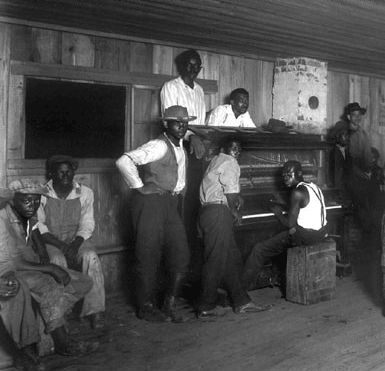
BOOGIE WOOGIE:
Its Origin, Subsequent History, and Continuing Development
Copyright 2004-2015 by John "Nonjohn" Tennison, M.D. All Rights Reserved This article was last updated on August 9, 2015.
(This article is a draft that contains only a fraction of the material that I will eventually publish as a book. Some sections and references in this article are incomplete and will be expanded in the book, including never-before-published material from field research on Boogie Woogie by me and others.)
“There is every reason for us to know something about Africa and to understand its past and the way of life of its peoples. Africa is a rich continent that has for centuries provided the world with art, culture, labor, wealth, and natural resources.”73
and
“But perhaps most important is the fact that fossil evidence indicates that human beings originated in Africa”73
and
“To be human is to be of African descent.”73
-- George C. Bond, Ph.D., Director, Institute of African Studies, Columbia University, (page 6 of the book, "Chokwe")73
Moreover, music historian, Dave Oliphant has written:
"Barrelhouse, boogie-woogie, and jazz all originate to some degree in the religio-sexual customs of primitive African societies, for Wilfrid Mellers14 notes, one of the meanings of the phrase 'boogie-woogie,' and of the word 'jazz' itself, is sexual intercourse, even as the ritualistic-orgiastic nature of the music also represents an ecstatic form of a spiritual order."13
Thus, as I consider Boogie Woogie, I intend to remain ever mindful that we are all of African descent. Being mindful of this fact suggests certain questions: For example, does Boogie Woogie have its widespread and lasting appeal because of any universal, evolutionary and/or instinctual aesthetic that has been biologically inherited by all human beings? Is there historical and cultural evidence in Africa even today that suggest a common biological heritage and aesthetic sensibility among human beings? If so, what are the elements of this common aesthetic? Does Boogie Woogie share any of these elements? Have the pretensions of so-called “civilization” created historical contexts where some human beings have unknowingly denied their own capacity to appreciate Boogie Woogie? To the extent that these questions can be answered in the affirmative, Boogie Woogie can be seen in a much larger context than merely being a popular music and dance form originating in the United States. However, before considering Boogie Woogie in such a broad historical context, I want to first examine its evolution within the United States.
Barrelhouse Pianist

The photo above was taken in Minglewood, TN in 1920. This photo is contained in the Special Collections Photograph Archives of the University of Louisville.
“Boogie Woogie piano playing originated in the lumber and turpentine camps of Texas and in the sporting houses of that state. A fast, rolling bass—giving the piece an undercurrent of tremendous power—power piano playing."
"Neither Pine Top Smith, Meade Lux Lewis nor Albert Ammons originated that style of playing—they are merely exponents of it."
"In Houston, Dallas, and Galveston—all Negro piano players played that way. This style was often referred to as a 'fast western' or 'fast blues' as differentiated from the 'slow blues' of New Orleans and St. Louis. At these gatherings the ragtime and blues boys could easily tell from what section of the country a man came, even going so far as to name the town, by his interpretation of a piece.”1 -- E. Simms Campbell, 1939, pages 112-113, (in Chapter 4 "Blues") in the book, "Jazzmen: The Story of Hot Jazz Told in the Lives of the Men Who Created It"1
Consistent with the findings of E. Simms Campbell are the comments of Elliot Paul, who wrote the following on page 229 in 1957 (in Chapter 10 "Boogie Woogie ") in his book "That Crazy American Music"78:
"The first Negroes who played what is called boogie woogie, or house-rent music, and attracted attention in city slums where other Negroes held jam sessions, were from Texas. And all the Old-time Texans, black or white, are agreed that boogie piano players were first heard in the lumber and turpentine camps, where nobody was at home at all. The style dates from the early 1870s. Even before ragtime, with its characteristic syncopation and forward momentum, was picked up by whites in the North, boogie was a necessary factor in Negro existence wherever the struggle for an economic foothold had grouped the ex-slaves in segregated communities (mostly in water-front cities along the gulf, the Mississippi and its tributaries)."78
Note: Despite the fact that both E. Simms Campbell and Elliot Paul mention "turpentine camps," there is good reason to conclude that Boogie Woogie did not originate in turpentine camps. For a more detailed explanation of the reasoning that led to this conclusion, see the section titled "Why Boogie Woogie Is Unlikely to Have Originated in Turpentine Camps."
On page 2 of his 1940 "Boogie Woogie and Blues Folio,"63 in his annotation to the reprint of the 1923 sheet music of George W. Thomas, Jr.'s "New Orleans Hop Scop Blues," (first published in 1916 by George W. Thomas) Clarence Williams states:
"The 'Boogie Woogie' originated in Texas many years ago. It wasn't called the 'Boogie Woogie' then. George Thomas was the fellow who used this style and first wrote it down."63
George W. Thomas, Jr.

This image of George Washington Thomas, Jr., is from Page 2 of Clarence Williams' 1940 "Boogie Woogie and Blues Folio"63
"Texas as the state of origin became reinforced by Jelly Roll Morton who said he heard the boogie piano style there early in the century; so did Leadbelly and so did Bunk Johnson."74 -- 1983, Rosetta Reitz [Leadbelly reported hearing Boogie Woogie in 1899. -- see section on Leadbelly below.]
Steel Gang Laying a Logging Railroad in the Piney Woods of East Texas
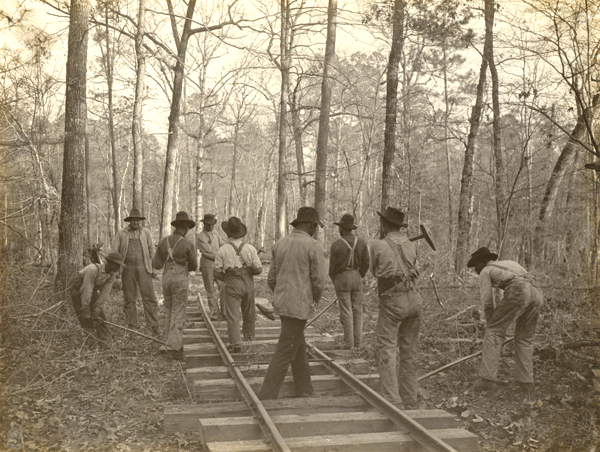
(From the East Texas Research Center Collection)
Click here to go to the website of the East Texas Research Center.
"Although the neighboring states of Arkansas, Louisiana, and Missouri would also produce boogie-woogie players and their boogie-woogie tunes, and despite the fact that Chicago would become known as the center for this music through such pianists as Jimmy Yancey, Albert Ammons, and Meade 'Lux" Lewis, Texas was home to an environment that fostered creation of boogie-style: the lumber, cattle, turpentine, and oil industries, all served by an expanding railway system from the northern corner of East Texas to the Gulf Coast and from the Louisiana border to Dallas and West Texas." (page 75)13 -- Dave Oliphant
Although there is an
obvious typographical error in his comments, in "Looking Up at Down: The
Emergence of Blues Culture,"76
William Barlow writes in Chapter 7, page 231:
"Piano players were the first blues musicians associated
with the Deep Ellum tenderloin. In Dallas, Houston, and other cities of
Eastern Texas, the prevailing piano style of uptempo blues numbers was called
"Fast Western" or "Fast Texas." An offshoot of boogie woogie, it probably
came from the "Piney Woods" lumber and turpentine camps based in northwest
Texas, northern Louisiana, and southern Arkansas. However, the style
became a fixture in "Deep Ellum" after the turn of the century."
Barlow obviously meant to write "northeast Texas," as there were no "Piney
Woods" or "turpentine camps" in "northwest Texas." This typo is also
obvious in that it is "northeast Texas" that is at the confluence of
"northern Louisiana" and "southern Arkansas", an area currently known as
the Arklatex. These comments on the origin of Boogie Woogie by Barlow is
consistent with the 1899 witnessing by Leadbelly, as well as with the account
given by Lee Ree Sullivan of Texarkana.
Moreover, since piano players were the "first blues musicians" in Deep Ellum,
Barlow's comments suggest that Blind Lemon Jefferson might have borrowed his
"Booga Rooga" guitar bass figure from Boogie Woogie pianists in Deep Ellum,
but given travels with Lead Belly on the T&P line, Jefferson could have also
heard such Boogie Woogie pianists at other locations in Texas. Jefferson
might have also derived his "Booga Rooga" bass line from Lead Belly,
after Leadbelly witnessed Boogie Woogie bass lines played by pianists in the
Arklatex.
The Focus of My Inquiry into Boogie Woogie
The quotations above from E. Simms Campbell and Clarence Williams are among the earliest accounts that attribute an origin of Boogie Woogie music to a specific geographical region, namely Texas. Their comments above are also noteworthy in that neither E. Simms Campbell nor Clarence Williams were from Texas. Campbell was from St. Louis and spent time living and conducting research in both Chicago and New York. Williams was from Louisiana, and also spent considerable time living in Chicago and New York. Thus, neither man had a conflict of interest or a Texas bias that might have contributed to a distortion in their thinking about the geographical origin of Boogie Woogie. Moreover, in 1986, after many years of researching the development of the Blues in America, historian Paul Oliver corroborated the idea that Boogie Woogie music originated in Texas (See below). Consequently, part of my current analysis will focus on looking at evidence and at the music and migratory patterns of early Texas Boogie Woogie players. At the same time, I want to see if it is possible to account for other early reports of the performance of Boogie Woogie that seem to be geographically discontinuous with the preponderance of early reports. In summary, I hope to engage in a sort of "meta-analysis" that will yield a coherent theory for development of Boogie Woogie that takes into account all known evidence.
I will describe the musical features that distinguish Boogie Woogie. Moreover, when appropriate, I will also take the opportunity to defend the musicality of and dispel misconceptions about Boogie Woogie.
Ultimately, I want to consider Boogie Woogie in a much broader context of human evolution and universal aesthetic sensibilities. Part of this broader consideration will examine how the formal elements of Boogie Woogie have strong correlates and associations with ancient spiritual, religious, and sexual practices.
Another attribution of the geographical origin of Boogie Woogie to Texas was in the radio script, "The Boogie Woogie Beat: Rompin' Stompin' Rhythm," (broadcast the week of 1/17/02, Riverwalk script ©2001 by Margaret Moos Pick). Moos wrote [when referring to the developers of the Boogie Woogie]:
"They had a captive audience: loggers from the lumber camps deep in the piney woods, and workers laying track for the Texas and Pacific railroad, carving a line of steel through the wilderness. The sounds of barrelhouse Boogie Woogie spread out in all directions following the path of the newly emerging railroad lines."
Steam Locomotives Sang the Blues & Inspired Early Boogie Woogie Musicians
In the book, "The Story of the Blues," on page 16 in
his chapter titled “Cottonfield Hollers,”5
historian Paul Oliver wrote:
On page 170 (Chapter 4 "Lonesome
Whistles") of the book, "The Land Where the Blues Began,"27
Alan Lomax, wrote:
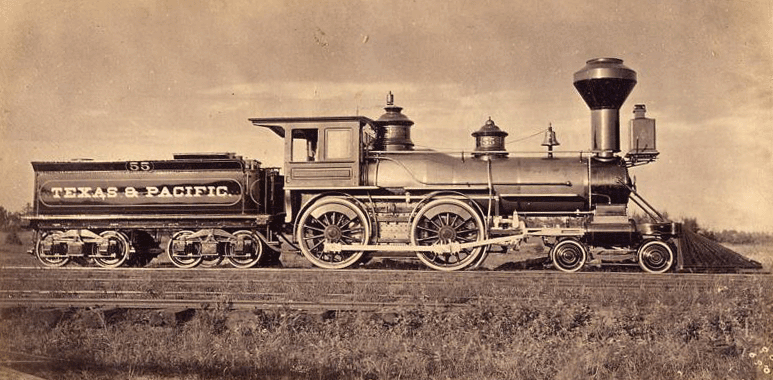
Pictured above is the Texas & Pacific steam locomotive 55, an A-2 Class 4-4-0 manufactured by the Schenectady company. The first steam locomotives used by the Texas & Pacific were built by Rogers Locomotive Works. For an excellent website pertaining to the Texas & Pacific Railway, see http://www.texaspacificrailway.org. For two excellent websites pertaining to general information about steam locomotives, including the Texas & Pacific, see http://www.steamlocomotive.com and http://www.steamlocomotive.info.
In the 1986 television broadcast of Britain's "South Bank Show" about Boogie Woogie19, music historian, Paul Oliver, noted:
"Now the conductors were used to the logging camp pianists clamoring aboard, telling them a few stories, jumping off the train, getting into another logging camp, and playing again for eight hours, barrelhouse. In this way the music got around -- all through Texas -- and eventually, of course, out of Texas. Now when this new form of piano music came from Texas, it moved out towards Louisiana. It was brought by people like George Thomas, an early pianist who was already living in New Orleans by about 1910 and writing "New Orleans Hop Scop Blues," which really has some of the characteristics of the music that we came to know as Boogie."19
Logging Train in the Piney Woods of East Texas
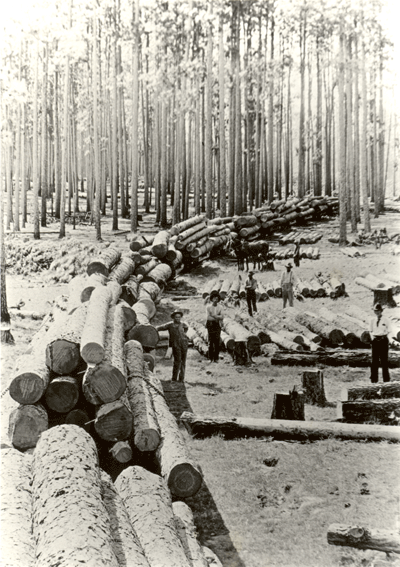
(From the East Texas Research Center Collection)
“The Boogie Woogie piano players had already developed a mature style in the early twenties, yet it waited until 1938 to find ready acceptance in the hot music field, and by such dispensers of musical taste as the arrangers.” – Frederick Ramsey, Jr. and Charles Edward Smith, 1939, page xiv in the "Introduction" to the book, “Jazzmen: The Story of Hot Jazz Told in the Lives of the Men Who Created It.”1
Hersal Thomas (sitting) & Older Brother George Thomas (standing)
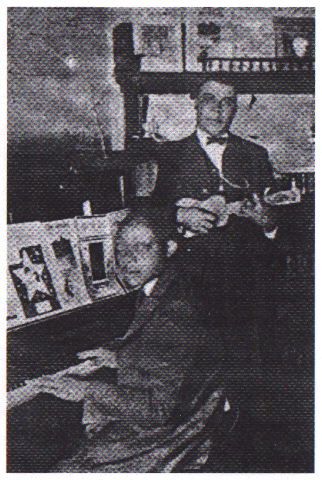
(The image above appears on the cover of the CD album "Texas Piano, Vol. 1" by Document Records.)
If anyone knows of any other pictures of George or Hersal Thomas other than those displayed in this article, please contact me at nonjohn@nonjohn.com.
The Forward of the 1942 sheet music book, "5 Boogie Woogie Piano Solos by All-Star Composers,"12 edited by Frank Paparelli, states:
"This book features for the first time, the works of George and Hersal Thomas. They are credited with discovering the Boogie Woogie style."
According to music historian, Paul Oliver, this "discovery" was made in East Texas by George W. Thomas, Jr.5
Specifically, on page 85 of the book, "The Story of the Blues," Oliver writes that George W. Thomas “composed the theme of the New Orleans Hop Scop Blues – in spite of its title – based on the blues he had heard played by the pianists of East Texas.”5
On February 12, 2007, Paul Oliver confirmed to me that it was Sippie Wallace who told him that performances by East Texas pianists had formed the basis for George Thomas's "Hop Scop Blues." Moreover, Paul Oliver also indicated to me that Sippie had not been specific as to the locations in East Texas at which George Thomas witnessed these pianists.77
(However, in my upcoming book, I will provide an analysis of all evidence that I have collected to develop a coherent theory of the most probable locations within Texas where George and Hersal could have been exposed to specific musical elements later seen in "New Orleans Hop Scop Blues," "The Fives," and "The Rocks," and other pieces by the Thomas brothers.)
What is a "Barrelhouse?"
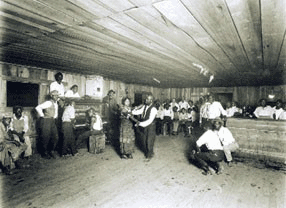
Above is a barrelhouse of the sort where Boogie Woogie was born.
When discussing the "barrelhouse" style of Boogie Woogie pianist, Robert Shaw, the Texas Handbook of History gives the following description of a "barrelhouse:"
"The style was named for the barrelhouses, where it was performed-sheds with walls lined with beer and whiskey, an open floor, and a piano on a raised platform in a corner of the room. The back of the barrelhouse was also used as a bawdy house."
Hersal Thomas: King of Chicago's House-Rent
"Boogie" Party Pianists
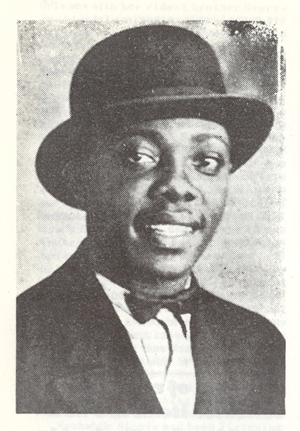
Hersal Thomas was an immense influence on other pianists,
including Albert Ammons, Meade Lux Lewis, Jimmy Yancey, and many others.
Many elements that we now know as elements of "Boogie Woogie" can be traced to Hersal and George Thomas' "The Fives."
Definitions of Boogie Woogie
The New Harvard Dictionary of Music2, 1986, defines "Boogie Woogie" as "a piano blues style featuring percussive ostinato accompaniments" that involve "steadily repeated bass patterns, one or two bars long" that "delineate the 12-bar blues progression, sometimes with IV in measure 2 or 10." This dictionary also states, "Melodies range from series of repeated figures reinforcing the explicit beat (including tremolos, riffs, rapid triplets) to polyrhythmic improvisations."
In 1987, Smithsonian music historian Martin Williams wrote (page 50)38:
"Boogie woogie is a percussive blues piano style--no one knows how old--in which an ostinato bass figure, usually (but not always) played eight beats to the bar, is juxtaposed with a succession of right hand figures."
Like all succinct attempts to define Boogie Woogie, these are, by necessity, limited in detail. Yet, they provide a starting place to approach Boogie Woogie, and from which to consider instances that defy these definitions. (For a more detailed consideration of Boogie Woogie's formal musical characteristics, see the "Tennison's Ten Boogie Woogie Elements" section below.)
How Old is Boogie Woogie?
In 1987, Martin Williams noted that "no one knows how old" Boogie Woogie is (page50).38
In 1995, Francis Davis wrote the following in "The History of the Blues" (page 151)7:
"Somewhere along the way -- no one knows for sure exactly when -- barrelhouse forked into boogie-woogie, an urban style characterized by eight insistent beats to the measure in the bass, and right-hand melodies that were essentially rhythmic variations on this bass line."7
With regard to the Boogie Woogie elements present in Pine Top Smith's "Boogie Woogie," in 1963, musical historian, Mack McCormick wrote:
"The term 'Fast Western' is unknown among Texas pianists. Moreover, they identify boogie woogie with the 1929 Pine Top smith record. They are, however, quick to point out that the elements Smith used had been common for decades."66
This account is consistent with Sammy Price's account40, which indicates that Blind Lemon Jefferson was playing Boogie Woogie bass figures on his guitar (which Jefferson called "booga rooga") before Pine Top Smith made his piano recordings.
However, despite Mack McCormick's learning that Robert Shaw was not familiar with the term, "Fast Western,"66 Lee Ree Sullivan of Texarkana told me in 1986 that he was familiar with "Fast Western" and "Fast Texas" as terms to refer to Boogie Woogie in general, but not to denote the use of any specific bass figure used in Boogie Woogie. Sullivan said that "Fast Western" and "Fast Texas" were terms that derived from the "Texas Western" Railroad Company of Harrison County, (formed on February 16, 1852), but which did not build track until after later changing its name to "Southern Pacific" on August 16, 1856. This Texas-based "Southern Pacific" was the first "Southern Pacific" railroad, and was in no way connected to the more well known "Southern Pacific" originating in San Francisco, California. Although the "Texas Western" Railroad Company changed its name to "Southern Pacific," Sullivan said the name "Texas Western" stuck among the slaves who were used to construct the first railway hub in northeast Texas. The Texas-based Southern Pacific Railroad was bought out by the newly-formed Texas and Pacific Railroad on March 21, 1872.
According to Sullivan, slaves had access to pianos on Sundays in some churches after the earlier morning services of white church-goers were completed. Sullivan said that, as far as he knew, prior to the Civil War, Sunday was the only day of the week on which slaves formally congregated at churches to play piano music in northeast Texas.68 Had such meetings not been in the context of practicing religion, antebellum access to pianos by slaves in northeast Texas would have probably been more limited. However, some slave narratives indicate informal access to pianos in non-scheduled contexts, such as in the homes of slaves owners.
The historical account of Clarence Williams indicates that George W. Thomas, Jr. was among the first, if not the first, to bring the musical elements of barrelhouses to urban performance. Williams noted that Thomas was playing "Hop Scop Blues" (later "New Orleans Hop Scop Blues") in Houston in 1911. George Thomas, Jr. was among the first to publish a Boogie Woogie broken-octave walking bass figure used in barrelhouses into written musical form in 1916. However, "The Weary Blues" by Artie Matthews (published in 1915) uses a Boogie Woogie broken-octave walking bass figure as well. So when Clarence Williams claims that "George Thomas was the fellow who used this style and first wrote it down,"63 it appears that having "wrote it down" does not refer to publishing, but rather having transcribed a Boogie Woogie broken-octave bass line.
Moreover, the Boogie Woogie broken-octave walking bass figure in Matthew's "The Weary Blues," is the same bass figure that Paul Oliver and others have identified as "The Cows" and as having originated in Texas."5 The bass figure known as "the cows" is a classic broken-octave Boogie Woogie walking-bass figure and can be heard in unison-octave form in the Cow Cow Davenport's "Cow Cow Blues" and in the open of Fats Waller's "Alligator Crawl." Although Waller was not known or playing or liking Boogie Woogie, he inserts "the cows" bass figure at 3 other places in "Alligator Crawl" besides the introduction.
In his book, "Ragtime: A Musical and Cultural History,"71 Edward A. Berlin has suggested that Blind Boone's 1909 "Southern Rag Medley 2"72 used a Boogie Woogie bass line in its "Alabama Bound" section. However, analysis of Boone's original sheet music, and analysis of Boone's 1912 piano roll performance of his "Southern Rag Medley 2," reveals that Boone's Alabama-bound bass line does not rise to the level of being a "Boogie Woogie" bass line. Specifically, Boone maintains a "duple-meter," "oom-pah" feel with his Alabama-bound broken-octave, bass line. Despite being "broken octaves" that "walk," Boone's broken octaves do not create a sense of ostinato, and his broken-octave bass notes remain harmonically subservient to the harmonic demands of the right hand, rather than achieve Boogie Woogie's sense of melodic and contrapuntal independence from the right hand part. Still, Boone's "Southern Rag Medley 2" is important in that this piece represents one of the earliest transcriptions of a transitional form suggestive of both Ragtime and Boogie Woogie. Moreover, in 1908 (the year prior to the publication of "Southern Rag Medley 2"), Scott Joplin used a broken octave bass line his "Pine Apple Rag." Yet, like Boone, Joplin's broken-octave bass line in "Pine Apple Rag" maintained a 2-4 "duple-meter," "2-to-the-bar," oom-pah feel, that was not independent, but rather, was harmonically constrained by the right hand part. Moreover, like "Pine Apple Rag," and "Southern Rag Medley 2", Artie Matthews's "Pastime Rag No. 1" (published in 1913) (See discussion below on different types of broken-octave bass lines.) also maintains a 2-4 "duple-meter," "2-to-the-bar," oom-pah feel, that is not independent, but rather, is harmonically constrained by the right hand part. Also, Matthews "broken-octaves" in "Pastime Rag No. 1" are grace-noted, the sort of "reverse-boogie" bass line that Eubie Blake uses in the 1917 piano roll recording of his "Charleston Rag." Not until Artie Matthews' 1915 publication of "The Weary Blues" do we have what rises to the level of having a "Boogie Woogie" broken-octave bass line, but with no inherent swing pulse. Yet, like George Thomas's "New Orleans Hop Scop Blues," the Boogie Woogie bass line of "The Weary Blues" is only present during part of the piece. Not until Jimmy Blythe's "Chicago Stomp" is there an example of (with the exception of the 4-measure introduction) a piece of music containing a Boogie Woogie bass line from beginning to end.
When Francis Davis says that "barrelhouse forked into boogie-woogie,"7 the word "forked" implies that some stylistic change might have occurred at the time of the "fork." However, no one to my knowledge has ever identified any specific stylistic elements that changed at a time of "forking." Thus, a more precise statement would have been to say that the music developed in the barrelhouses came later to be called Boogie Woogie when played in more urban environments. Moreover, despite Davis' description, not all Boogie Woogie is 8-to-the-bar, and right-hand parts of Boogie Woogie are not necessarily rhythmic variations of the bass line.
Even though the preponderance of evidence is consistent with an East Texas geographical origin for Boogie Woogie, historians do not have enough evidence to pin down the date of the very first occurrence of what could be called Boogie Woogie. However, besides McCormick's research indicated that Boogie Woogie elements used by Pine Top Smith "had been common for decades"66 before 1929, Sharon A. Pease (on page 8 of the October 15, 1939 issue of Down Beat Magazine83) noted the following in an article about Pinetop Smith:
"Pinetop cannot be given credit as the creator of the boogie-woogie style, for we know it has been played in the South as far back as the oldest residents can recall."83
Other than noting that they were the "oldest" residents, Sharon Pease was not specific about how many or which residents had been surveyed to determine that Boogie Woogie had been "....played in the South as far back as the oldest residents can recall."83 However, given the account of Elliot Paul, who noted: "And all the Old-time Texans, black or white, are agreed that boogie piano players were first heard in the lumber and turpentine camps, where nobody was at home at all. The style dates from the early 1870s.,"78 it is reasonable to conclude that Sharon A. Pease would have come to the same conclusion whether or not his survey was limited to African Americans. If the "oldest residents" as of October 15, 1939 to which Sharon Pease refers were solely African American, some of these African Americans would almost certainly have been old enough to have witnessed the piano performances of the early 1870s. Consequently, Sharon Pease's account is entirely consistent with Elliot Paul's account of Boogie Woogie, when Paul states,
"The style dates from the early 1870s."78
Moreover, by counting backwards from the ages of all known living African Americans who were alive as of the Down Beat article on October 15, 1939, it would be possible to derive a range of time prior to 1870 that African Americans in the population to which Sharon Pease referred could have potentially heard Boogie Woogie. Certainly, African musical sensibilities were present prior to 1870. However, prior to 1870, it is not clear whether they were being expressed on piano as influenced by the sounds associated with steam locomotives. That is, if these musical sensibilities were being expressed solely on drums, such expression would not mark the formal beginning of "Boogie Woogie."
Nonetheless, the African musical elements that informed Boogie Woogie were surely present prior to the Civil War. Consequently, the earliest Boogie Woogie performances would have had the purest relationship to African musical elements of ostinato, polyrhythm, and improvisation. These earliest performances would have stood in contrast to the more-structured, composed, and sterilized Boogie Woogies that were introduced to white audiences on a large scale in the 1930s and 1940s.
Given the account of Elliot Paul; and given that Lead Belly witnessed Boogie Woogie in 1899 in the Arklatex; and given the North to South migration of the Thomas family; and given the Texas & Pacific headquarter in Marshall in the early 1870s; and given that Harrison County had the largest slave population in the state of Texas; and given the fact that the best-documented and largest-scale turpentine camps in Texas did not occur until after 1900 in Southeast Texas, it is most probable that Boogie Woogie spread from Northeast to Southeast Texas, rather than from Southeast to Northeast Texas, or by having developed diffusely with an even density over all of the piney woods of East Texas. It would not be surprising if there was as yet undiscovered evidence of the earliest Boogie Woogie performances buried (metaphorically or literally) in Northeast Texas.
June 19, 1865 -- "Juneteenth" -- A Turning Point in the Development of Boogie Woogie
My inquiry into the "origin" of Boogie Woogie within the United States will focus mainly on evidence of when West African percussive ostinato styles and improvised percussive lead parts came to be applied to pianos in the United States. I make several assumptions that I hope are true. First, I assume that slaves had limited access to pianos prior to the end of the Civil War. In general, musical activities of slaves were limited, as these activities were believed by plantation owners to be capable of inciting riots and rebellions. Thus, prior to the civil war, most slave owners would have limited intentional access by slaves to the luxury and high technology of pianos. However, there are almost certainly exceptions to this assumption. Indeed, in these exceptions could lie the origins of Boogie Woogie.
Moreover, even before the Civil War was over, slave labor was used in Texas for construction of railroad tracks. Thus, the sounds of steam locomotives could have served as musical inspiration even before African Americans had easy access to pianos.
Nonetheless, most of my inquiry into the origin of Boogie Woogie will be concerned with events that followed the Civil War. Since a preponderance of evidence points towards a Texas origin for Boogie Woogie, I will focus largely on events following June 19, 1865. This date is known as "Juneteenth" in Texas because it is the date that "Union soldiers, led by Major General Gordon Granger, landed at Galveston, Texas with news that the war had ended and that the enslaved were now free."49 Consequently, this date would have been a significant transitional date at which time African Americans in Texas gained knowledge of their new freedoms and, thus, had the potential to make dramatic changes in four areas:
1. Expressing Freedom of travel
2. Engaging in musical expression and experimentation
3. Communicating musical ideas with each other
4. Greater access to pianos and other items of previously limited availability
Thus, the development of Boogie Woogie could proceed at a significantly faster rate after June 19, 1865.
Other events prior to June 19, 1865 that were relevant to the development of Boogie Woogie were the sounds of steam locomotives. These sounds would have been heard by slaves working on railroad construction. Moreover, slave owners would not have been able or desirous of censoring slaves from hearing these sounds. Moreover, these sounds would have occurred where tracks were being built and where steam locomotives were running.
In summary, the "origins" of Boogie Woogie that I will consider most will be those events that occurred from June 19, 1865 to 1900. Although Boogie Woogie continued to develop and evolve after 1900, various pieces of evidence, such as Lead Belly's account of piano walking bass lines in 1899, have resulted in my tendency to refer to Boogie Woogie events prior to 1900 as "origin" events, while referring to events after 1900 as "developmental" events. I recognize that such a division is arbitrary, as the development of Boogie Woogie, like most things in our macroscopic world (in contrast to quantum physics), is continuous and has no naturally-identifiable boundaries between historical eras. That is, the eras are all in our minds and only serve as convenient ways to divide time so as to create a nomenclature to have meaningful verbal communication with each other.
Marshall, Texas: The Birthplace of Boogie Woogie
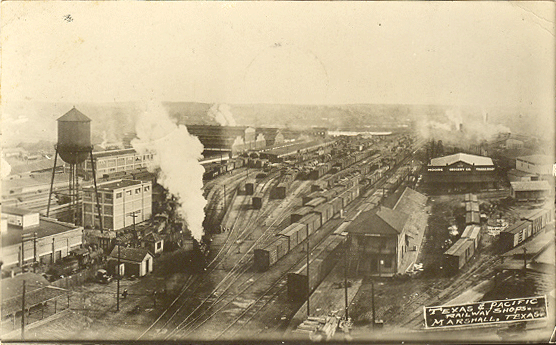
Pictured above are the Texas & Pacific Shops in Marshall, Texas, the "Birthplace of Boogie Woogie" and earliest "Hub of Boogie Woogie"
When I call Marshall the "birthplace of Boogie Woogie", I define "birthplace" as "the municipality whose boundaries are most likely to encompass or be closest to the point on the map which is the geographic center of gravity for all instances of Boogie Woogie performance between 1870 and 1875." Moreover, I also regard Marshall as the earliest "Hub of Boogie Woogie," the crossroads with the most railroad traffic in the Piney Woods of East Texas, where the paths of the earliest itinerant Boogie Woogie musicians most frequently intersected, resulting in further development of the Boogie Woogie style. This railroad traffic resulted from Marshall having been the original headquarters and hub for the Texas and Pacific Railroad since the early 1870s. The Texas & Pacific Railroad both manufactured and repaired steam locomotives in Marshall, Texas.
On May 13, 2010, the city commissioners of Marshall unanimously passed an ordinance which declared Marshall, Texas the birthplace of Boogie Woogie.
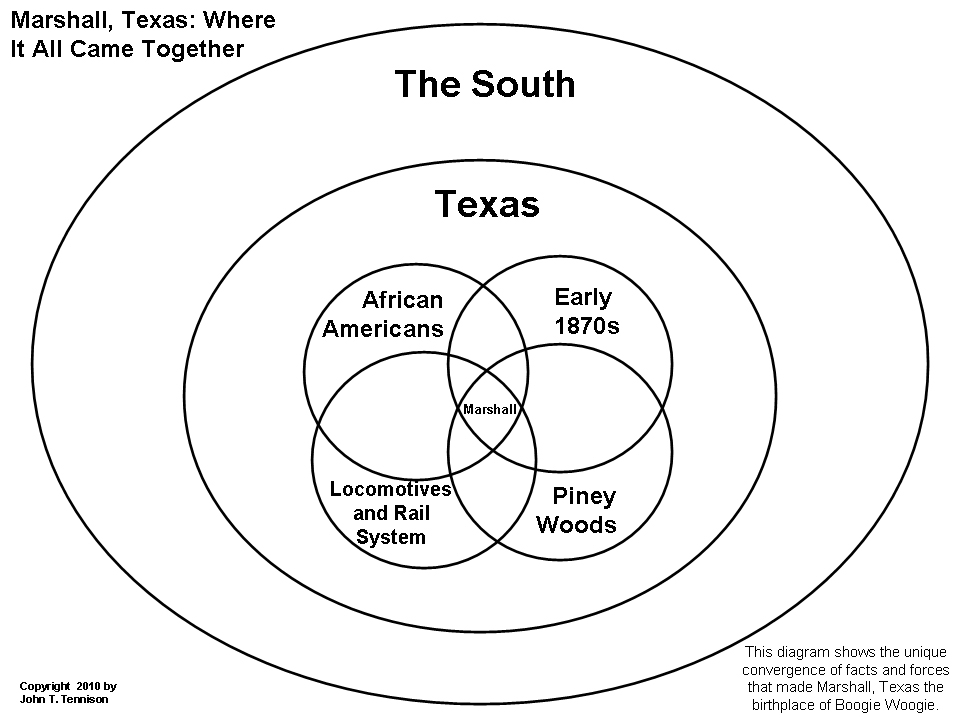
After the early 1870s and before 1900, the center of gravity of Boogie Woogie performance appears to have shifted northward to Texarkana.68 This center of gravity continued to move northward, and by the 1920s, had become centered in Chicago.
Omar Sharriff (AKA David Alexander Elam) Brought the Boogie Woogie Home to Marshall, Texas

This photo of Omar Sharriff (AKA Dave Alexander Elam) was taken by John Tennison on June 11, 2010 in front of Sharriff's alma mater, the historic Pemberton High School in Marshall, Texas.
Omar Sharriff was born “David Alexander Elam” on March, 10, 1938 in Shreveport, Louisiana. The 1940 U. S. Census shows Omar (then known as David Elam) living with his family at age 2 at the street address of 2128 Marion Street in Shreveport, Louisiana. The 1940 census indicates that Omar's father, Tommy; mother, Susy; and 6-month old brother, Donald were also living at that same address in Shreveport at the time of the 1940 U.S. census. The 1940 U. S. Census indicates both of Omar's parents as having been born in Louisiana. However, this is possibly in error, as another document suggests that Omar's father, Tom Elam (AKA Tommy Elam), was born in Tatum, Texas, in 1893. Moreover, the 1940 U. S. Census indicates that Tommy Elam was 45 years old, but gives a birth year of "about 1895," suggesting that even at the time the census was taken, the census taker was expressing uncertainty about the birth year of Tommy Elam, which would also imply uncertainty about Tommy Elam's age. Consequently, at this time, I will express the birth year of Tom Elam (AKA Tommy Elam) as "circa 1893-1895."
After the 1940 U.S. Census was taken, Omar's family moved to a rural community in Harrison County Texas, just outside and south of Marshall and on the east side of Highway 59. Omar attended elementary school in this community before his family moved within the Marshall city limits, where Omar attended Pemberton High School. After being away from Marshall for many years, Omar Sharriff moved back to Marshall, Texas in 2011, where he lived for almost a year before his death on January 8, 2012.
Contemporary Keyboard Magazine First Annual Readers' Poll
In the first-ever Readers' Poll results, published on page 25 of the January, 1977 issue of Contemporary Keyboard magazine (later known as Keyboard Magazine), Omar Sharriff (then known as Dave Alexander) was ranked 2nd only to Ray Charles as the greatest living blues pianist. It is noteworthy to point out that Dave Alexander was ranked above other great living blues pianists at the time, including Professor Longhair (3rd place) , Memphis Slim (4th place) , Champion Jack Dupree (tied for 5th place), and Piano Red (tied for 5th place).
Omar's father, Tom Elam (AKA Tommy Elam) (born circa 1893-1895), was the first person that Sharriff ever heard play Boogie Woogie. Tom Elam was possibly born in Tatum, Texas, not far from Marshall. Sharriff's Boogie Woogie homecoming concert on June 11, 2010, represented a historical turning point, namely that of formally recognizing and publicly supporting the continuing performance of Boogie Woogie in Marshall, Texas, the Birthplace of Boogie Woogie.
Some confusion has existed over the years as to the identity of Sharriff's biological father. At least one published account25 has stated that Omar was the son of David Alexander (AKA Black Ivory King), who also spent time performing in the Arklatex and who recorded 4 pieces in Dallas, Texas. However, in a phone interview on October 25, 2010, with Jack Canson of Marshall, Texas, Sharriff stated that he was not the biological son of David Alexander (Black Ivory King). Rather, Sharriff stated that his mother, Susie (possibly spelled "Susy") Hill, named him after Black Ivory King at the request of Sharriff's father, Tom Elam, who was friends with David Alexander (Black Ivory King). Interestingly, Lead Belly has also cited David Alexander (Black Ivory King) as the name of a pianist who Lead Belly encountered90, most likely in the Arklatex area. Specifically, in 1970, on page 12 of his Down Beat article, "Illuminating The Leadbelly Legend," Ross Russell wrote:
"Leadbelly also heard pianists named Pine Top Williams, Dave Alexander, and Dave Sessom of Houston, Tex., although he was not sure if he heard them in 1906 or later in his travels."90
The First Railroad between Texas and Another State
The first inter-state railroad between Texas and another state was the line running between Marshall, Texas and Shreveport, Louisiana. This line was created in 1863 when the Southern Pacific built tracks to the state line between Texas & Louisiana, where tracks continued onward to Shreveport. The Texas portion of this line was created by the Southern Pacific, which was absorbed into the Texas & Pacific in 1872.
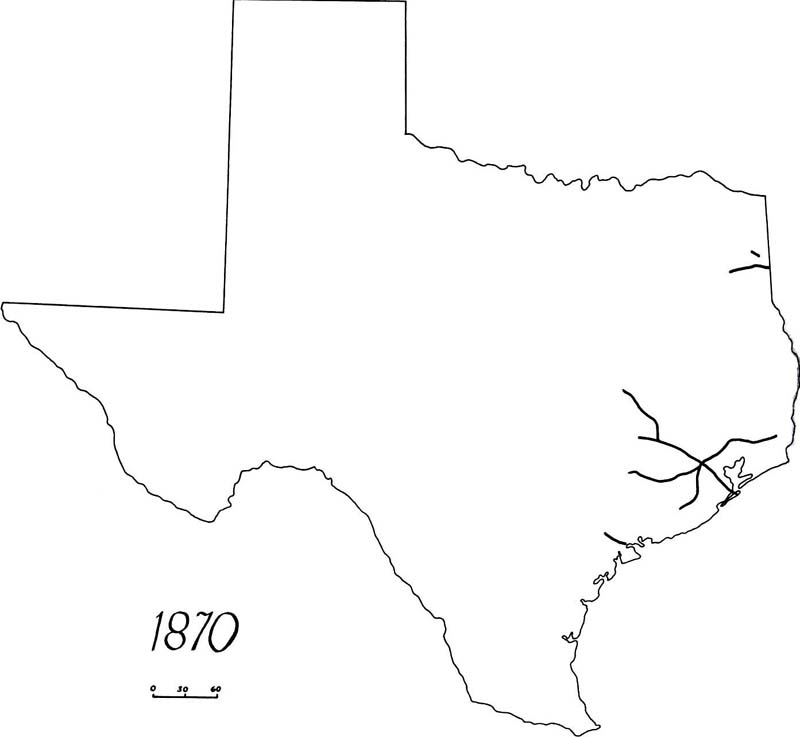
The figure above is from Charles Zlatokovich's book, "Texas Railroads". The first inter-state railroad between Texas and another state (Louisiana) can be seen meeting the Texas border in the northeast portion of the state of Texas. The towns on this line (from west to east) included Longview, Hallsville, Marshall, Waskom, and Greenwood, and Shreveport.
The Texas & Pacific Railway Depot in Marshall, Texas
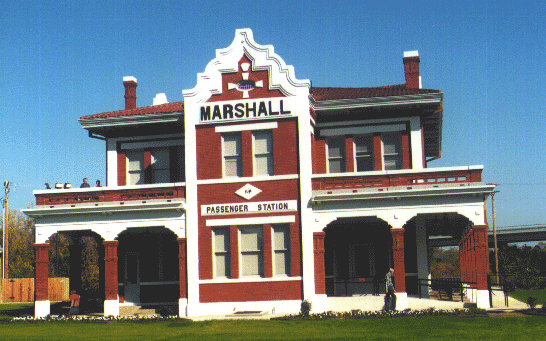
Pictured above is the refurbished Texas & Pacific Train Depot in Marshall, Texas
Pictured above is the recently refurbished (1999) Texas & Pacific Railway Depot in Marshall, Texas, site of a current-day Texas & Pacific Museum.
The Continuing Mystique of Steam: The Texas State Railroad
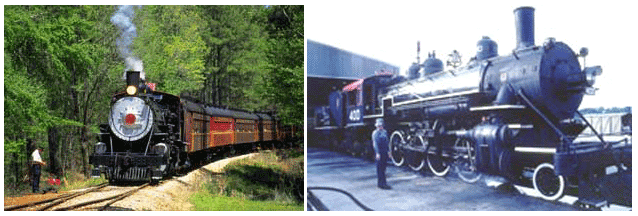
Still running as of 2009, the Texas State Railroad, which runs between Rusk and Palestine through the Piney Woods of East Texas, can give you an inkling of the experience that itinerant musicians might have had as they traveled through the woods from one barrelhouse to the next between 1870 and 1900 while sharing musical ideas that would make history. Palestine was one of the towns through which the Thomas family probably traveled when they migrated from Little Rock to Houston. At this time (between 1883 and 1898), Palestine was on the International and Great Northern Railway route, part of the Jay Gould system of Railroads. The Texas State Railroad runs the only Texas & Pacific locomotive still in operation as of 2009. It is a 4-6-0 "Ten Wheeler," which was Engine 316 when owned by Texas and Pacific, but now lives on renamed as Engine 201 on the Texas State Railroad. The 4-6-0 wheel configuration is the same type depicted on the cover of "The Fives'," by the Thomas Brothers. Consequently, to ride this particular Texas & Pacific locomotive in the Piney Woods of East Texas has strong symbolic meaning, but is also probably as close as one can come in 2009 to simultaneously experiencing the locomotive and natural environmental sounds of East Texas as heard by the itinerant musicians who created Boogie Woogie in East Texas.
Other Names by Which Boogie Woogie is Known
The developments in Boogie Woogie that occurred in Chicago in the 1920s, and at various places in the 1930s, resulted in a prototypical recordings or yardsticks by which other latter music can be compared to assess its "Boogie-Woogie-ness." Meade Lux Lewis, Albert Ammons, and Pete Johnson are exemplary Boogie Woogie exponents whose collection of recordings from the 1920s,1930s, and 1940s provide a yardstick to which other music can be compared to asses its Boogie-Woogie-ness. Although I prefer the term "Boogie Woogie," to describe music that resembles the prototypical sound of Ammons, Lewis, and Johnson, below are other terms that are sometimes used to refer to music that contains the formal elements of Boogie Woogie:
Fast Western - "Fast Western" appears to be the earliest term by which Boogie Woogie was known.85 "Fast Western" was cited as an early term for Boogie Woogie by E. Simms Campbell in 1939.1 The assertion that "Fast Western" was the earliest term by which Boogie Woogie was known was made by Max Harrison in 1959 when he wrote: "The music did not acquire the name 'boogie' for some time. At first it was called 'fast Western' -- another indication of its place of origin -- and it retained similar names when it travelled. Thus, when recalling his early days in Kansas City, Pete Johnson said all the pianists played 'the same sort of Western rolling blues."85 Rosetta Reitz corroborated the account of Pete Johnson, when she wrote: "Pete Johnson who grew up in Kansas City said they called it 'western rolling blues.'"74 "Fast Western" as the earliest term for Boogie Woogie was corroborated by Mack McCormick in the liner notes to his Treasury of Field Recordings, Vol. 2.86 McCormick came to this conclusion despite the fact that he found that Boogie Woogie pianists from the Houston area and from places other than the Arklatex were not familiar with the term "Fast Western" for Boogie Woogie. According to Lee Ree Sullivan of Texarkana, both "Fast Western" and "Fast Texas" derived from the "Texas Western Railroad," a precursor to what later became the Texas & Pacific Railroad.68 Thus, it appears most probable that "Fast Western" is a term for Boogie Woogie that emerged in the Marshall area of Harrison County, Texas in early 1870s, where Boogie Woogie was probably first played.
Fast Texas - usually used interchangeably with "Fast Western." See "Fast Western" above.
Fast Blues - as described by E. Simms Campbell in 1939, as contrasted with the "Slow Blues" of New Orleans1
Galveston Blues - In 1966, Victoria Spivey indicates that what had been called "The Galveston Blues" was "now called the 'Boogie Woogie.'"45
Barrelhouse - refers to the locations where much of early Boogie Woogie evolved. Literally speaking, "Barrelhouse" can refer to any music that was traditionally played in barrelhouses. Consequently, not all "Barrelhouse" music was Boogie Woogie. For example, some "Barrelhouse" music would have sounded more like Ragtime than Boogie Woogie. However, in present-day usage, "Barrelhouse" is used more often to refer to styles that sound more like Boogie Woogie and less like Ragtime. Sometimes the term "barrelhouse" is used to refer to music that is said to have proceeded but led to Boogie Woogie, yet, unless distinctions are made as to what musical elements distinguish this usage of "Barrelhouse" from Boogie Woogie, this is an ambiguous distinction. Many times "barrelhouse" is used to describe Boogie Woogie when it is played with the least structure of all, in which the player has no idea of what he or she is going to play until after starting to play. Such performances, as in the case of Alex Moore, are often accompanied by spontaneous commentary. When speaking of Boogie Woogie played on Fannin Street in Shreveport, Lead Belly stated, "Boogie Woogie was called barrelhouse in those days."87
Boogie - Sometimes uses as a contraction or synonym of "Boogie Woogie." However, sometimes used to refer to guitar renditions of a Boogie Woogie walking bass or a Boogie Woogie pulse, especially as was developed in Rockabilly and "Hillbilly" derivatives of Boogie Woogie.
Blues Piano - can refer to the fact that some Boogie Woogies use a 12-bar or other common cyclical harmonic progression used in blues music.
Dudlow Joe (AKA Dud Low Joe; AKA Dudlow) - Given considerable confusion I have encountered surrounding the term, "Dudlow Joe," an extended discussion of this term is warranted. According to Little Brother Montgomery and Willie Dixon, "Dudlow Joe" was a term used for Boogie Woogie in Mississippi when Little Brother Montgomery was about 12-13 years old, meaning 1918-1919.96 Given the accounts that indicate use of "Boogie," and "Boogie Woogie," prior to 1900, "Dudlow Joe" does not appear to predate "Boogie Woogie," or the still earlier "Fast Western" as a term for what we now know as Boogie Woogie. Moreover, in 1960, Montgomery seems to indicate that when he was nine years old, (circa 1915), the term "walkin' basses" was used to describe a Boogie Woogie bass figure.96 Montgomery also seems to indicate that "Dudlow Joe" did not become a term for Boogie Woogie until Montgomery was 12-13 years old.96 Specifically, in the 1965 book, "Conversation with the Blues," (based on field recordings made by Paul Oliver from June through September in 1960 (page xvii)96), Montgomery is quoted as having said the following on page 69-7096: "On up I learned another blues from a great guy name of Loomis Gibson. We called it the Loomis Gibson Blues which is the name of it. When I first tried to play it I was only around the age of nine so I used to only play a walking bass with one finger then, but after I got up around twelve or fourteen I could double up and I could play with all of my hand. Later on, Loomis Gibson passed and I named it the Crescent City Blues. We used to call it walkin' basses at the time, but we never called it anything special. I was playin' what you call boogie woogies ever since I was twelve or fourteen years old but then we called it Dud Low Joe."96 In contrast to the 1965 "Conversation with the Blues" book, the 1965 co-released LP of the field recordings made in 1960 by Paul Oliver contain liner notes which quote Montgomery saying the following: "....- oh I were playin' boogie-woogies ever since I were twelve or thirteen years old. We used to call it walkin' basses at the time...(piano solo)...we called it Dud Low Joe." Thus, it appears that the 1965 book publication of "Conversation with the Blues," and even the later 1997 Cambridge University Press re-publication of the "Conversation with the Blues" book contain a transcription error by having printed "fourteen" rather than "thirteen" years old.)
Other comments about "Dudlow Joe" from Little Brother Montgomery appear in the book, "Deep South Piano: The Story of Little Brother Montgomery," by Karl Gert zur Heide, 1970, Studio Vista Publishing97. On page 18, Karl Gert zur Heide wrote that, with regard to Boogie Woogie bass figures, Little Brother Montgomery stated the following: "We were playing all those kind of basses down there, way before ever it came out on records. I used to only play a walking bass with one finger then, but after I got up around twelve, fourteen I could double up and play with all of my hand. We called it Dudlow Joe."97 Also on page 18 of his book, Karl Gert zur Heide writes that Willie Dixon stated the following: "They used to call boogie piano Dudlow Joes in Mississippi. I didn't hear it called boogie till long after. If a guy played boogie piano they'd say he was a Dudlow player. Later on guitars played boogie too."97 On page 33 of his book, Karl Gert zur Heide writes that Willie Dixon, who was born in 1915 in Vicksburg, Mississippi, stated the following: "When I was a little boy in Mississippi, I used to run around and follow the bands through the streets."97 and "They had a band up on the back of a truck and I loved it. I remember Little Brother up on the truck playing piano. You've got to hear him do Farish Street Jive. It's the most beautiful thing. Years ago they called it Dudlow."97 Also on page 33 of his book, Karl Gert zur Heide states: "Little Brother's commentary upon hearing Lee Green's Dud-Low Joe was: 'He's trying to play Farish Street Jive.'"97 Thus, Montgomery's and Dixon's accounts indicate that the term "Boogie Woogie" and "Fast Western" had not yet become part of the vernacular of Montgomery's circle of piano players circa 1918-1919. A common misconception that I have encountered is the mistaken belief that Montgomery and/or Dixon claimed that Boogie Woogie originated in Mississippi. Examination of their quotes from the Paul Oliver interview and the Karl Gert zur Heide biography reveal that neither of them made such a claim.
However, in the 1989 biography of Willie Dixon ("I Am The Blues: The Willie Dixon Story," by Willie Dixon with Don Snowden)98, Dixon does make additional specific claims which are ridiculous and unbelievable. For example, on page 5 of the 1989 biography, Willie Dixon states: "They call it the old 12 bar blues because people like Little Brother Montgomery and other guys started putting a left hand boogie beat to 'em. In those days, if the beat wasn't uptempo, they called it 'barrelhouse' and if it was uptempo, they called it 'Dudlow' or 'Dudlow Joe.' They would call this left hand putting the dudlow to the blues." and (also on page 5 of the 1989 Dixon Biography): "After people got wise enough to commercialize it, somebody said, 'Well, we'll call this boogie-woogie.' That gave everybody a chance to say, 'This is my boogie and that's his boogie.' If they kept calling boogie-woogie 'dudlow,' then it would have been based on black folks' music.' When they began calling it boogie-woogie, it creates the feeling of a certain thing anybody can do."98 First, it should be pointed out that Dixon is not claiming that Montgomery originated left-handed Boogie Woogie bass figures, but rather that "Montgomery and other guys" were ones who started playing such bass figures in the context of a 12-bar blues structure. However, given that Dixon was not born until 1915, and given that Montgomery was not born until 1906, even this claim is unbelievable because of accounts of Boogie Woogie bass figures having been played with structures involving 12 bars and various other numbers of bars prior to 1900. Of course, whether such structures prior to the birth of Montgomery could be considered "blues" structures is a matter of definition, but it is almost certainly the case that the elements used to accompany Boogie Woogie bass figures prior to 1906 had characteristics that would have easily been considered "blues" by modern definitions. Moreover, Dixon's claim that the use of "barrelhouse" referred to music that "wasn't uptempo" is not a universal way of using the term "barrelhouse," as there are plenty of instances where the term "barrelhouse" is used more generally to describe any music that happened to be played in a barrrelhouse, be it slow or fast. However, the most ridiculous and unbelievable claim that Dixon makes is when he suggests that the term "boogie-woogie" was first used as a result of a desire to commercialize the music. This claim is at odds with multiple accounts which demonstrate that the music was being called "Boogie Woogie" by African Americans, whose use of "Boogie Woogie" had nothing to do whatsoever with a desire to "commercialize" the music. Of course, there was a substantial commercialization of the term "Boogie Woogie" in the 1940s, but this came well after the term "Boogie Woogie" had become part of the African American vernacular for non-commercial reasons. Moreover, Dixon makes the absurd claim that calling the music "boogie-woogie" would give the impression that the music was less "based on black folks' music" than would occur if the music was called "dudlow." Amazingly, Dixon seems oblivious to the fact that the breakthrough recording that popularized the term "Boogie Woogie" to larger numbers of people than ever before was Pine Top Smith's Boogie Woogie, which was a "race" record marketed primarily to African Americans, and for which record companies had no motivation to obscure the fact that Pine Top Smith was African American or that Pine Top Smith's Boogie Woogie was a style of music played predominantly by African Americans at that time. However, in the later case of "Tommy Dorsey's Boogie Woogie," there probably was an intent to sterilize and obscure the black origins of the music to make it palatable for white audiences, but the use of "Boogie Woogie" in the title did not serve that function.
Lastly, despite an extensive interview of Little Brother Montgomery, Paul Oliver's research led him to the conclusion that Boogie Woogie had originated in Texas. Similarly, after extensive interviews of both Little Brother Montgomery and Willie Dixon, Karl Gert zur Heide's wrote the following about the origin of Boogie Woogie on page 11 of his book: "The earliest reports hint at an origin somewhere between New Orleans and Dallas, Memphis and Houston, but Mississippi and Alabama also had strong boogie traditions."97 Karl Gert zur Heide's descriptions of an origin "somewhere between New Orleans and Dallas, Memphis and Houston"97 is fully consistent with my conclusion that Marshall, Texas is the most probable municipal geographical center of gravity of the earliest Boogie Woogie performances, especially when one considers the earliest railroad corridors that created a connection between the four cities of New Orleans, Dallas, Memphis, and Houston. For example, the Texas and Pacific Railroad was the primary railroad corridor between "New Orleans and Dallas", and the earliest primary railroad corridor between "Memphis and Houston" included the Texas and Pacific tracks between Texarkana and Marshall, Texas, and the Texas and Pacific tracks between Marshall and Longview, Texas. Moreover the common track between the Dallas-New Orleans corridor and the Memphis-Houston corridor was the Texas and Pacific track between Marshall and Longview, Texas.
Country Blues (Piano) - Sometimes used as a contrast to urban blues, such as those with the Harlem Stride oom-pah bass lines.
Honky Tonk - suggests a location and the sound of a train, as in "Honky Tonk Train"
Ragtime - can refer to the syncopation (i.e. the "ragged time") used in Boogie Woogie and Ragtime. Yet, Boogie Woogie usually does not have a oom-pah left hand as its predominant bass figure as Ragtime typically does.
Walking Bass - What Sammy Price said Boogie Woogie was called in Texas while, at the same time, being called "booga-rooga" by Blind Lemon Jefferson (This usage pre-dated the recording of "Pine Top's Boogie Woogie.") Also, Little Brother Montgomery seems to indicate that "walkin' basses" was a term used prior to "Dudlow Joe" among Montgomery's circle of Boogie Woogie players.96 Of course, not all Boogie Woogie bass figures are walking basses. Walking basses tend to be heard melodically and thus contrapuntal to right-hand parts, but because of their width and close harmonies of their chords, stride basses (see below) tend not to be perceived as melodic, but rather as harmonic accompaniment to right-hand parts.
Stride - as opposed to "Walk," refers to a relatively greater width between successive left hand notes and/or chords. Put another way, "Walking" basses and "Stride" basses are on the same continuum, with "Striding" being at one end and "Walking" being at the other end. Oom-pah strides are less common in Boogie Woogie, and more common in "Ragtime" and what is called "Stride Piano," as developed Harlem and New York City. In the movie, "Ray,"33 about the life of Ray Charles, the Ray Charles character indicates that he got his start playing "stride," yet this is a factual error. If the writers of this screenplay had stuck to the facts, they would have the Ray Charles Character say that he learned piano from a "Boogie Woogie" piano player, as the real-life Ray Charles indicated in his 1978 autobiography: "Sometimes I'm asked about my biggest musical influence as a kid. I always give one name: Mr. Wylie Pitman. I called him Mr. Pit."56 and (page 8) "Mr. Pit could play some sure-enough boogie-woogie piano."56 and (page 8) "Oh, that piano! It was an old, beat-up upright and the most wonderful contraption I had ever laid eyes on. Boogie-woogie was hot then, and it was the first style I was exposed to. Mr. Pit played with the best of them."56 Moreover, in an interview with Clint Eastwood in the "Blues Piano"32 documentary in the "Martin Scorsese Presents the Blues" series, Charles also gives credit to Boogie Woogie as the style in which he first got his start. Thus, screenplay writers for the movie, "Ray,"33 were either ignorant, and/or wanted to promote the word "stride." Sadly, the only time the term "Boogie Woogie" occurs in the film, "Ray," is when it is uttered in a derogatory fashion by a racist white member of a country band when he indicates to the Ray Charles character that the country band does not play any "Boogie Woogie." Thus, the movie adds to the confusion of what is meant by "Boogie Woogie." Still, "Ray" is an excellent film that beautifully depicts the discovery by young Ray of, Mr. Wylie Pitman (A.K.A. "Mr. Pit"), the Boogie Woogie player who kindly gave Ray his first piano lessons.33
Swing - Many Boogie Woogies have a swing (A.K.A. shuffled) feel to them, yet "Swing" also often refers to a sort of high-brow, urbanized, orchestrated, ensemble music that often lacks the ferocity of raw Boogie Woogie.
Jazz - Jazz is the most non-specific of all terms used to refer to Boogie Woogie. (See section bellow titled, "Is Boogie Woogie Jazz?") For the four reasons listed below, Boogie Woogie is Jazz, but so are a lot of other styles of music! Thus, calling Boogie Woogie "Jazz" is true, but not very specific.
Rock and Roll Piano - Think Jerry Lee Lewis or Little Richard! What they played was essentially Boogie Woogie with the addition of vocals, guitars, and drums.
Rockabilly - Sometimes used to describe the use of a Boogie Woogie beats, pulses, bass lines (often adapted to guitar) in country music that emerged in the 1940s and that (in addition to the direct influence of piano-based Boogie Woogie) influenced such artists as Jerry Lee Lewis and Chuck Berry, both of whom consider their own music to be a form of Boogie Woogie.
Hillbilly - Sometimes used interchangeably with "Rockabilly" Moon Mullican (AKA "King of the Hillbilly Pianists") is an example of a white performer who played Boogie Woogie, influenced Jerry Lee Lewis, and brought Boogie Woogie to the Nashville country music scene.
8-to-the-Bar - Refers to the number of pulses per measure, although not all Boogie Woogie is 8-to-the-bar. 8-to-the-bar is in contrast to Ragtime's 2-to-the-bar (AKA oom-pah).
Sixteen - term used by Eubie Blake to refer to 16 notes in the left hand for every 4 in the right. However, Blake's account of the use of this term might have been concocted. (See section below on Eubie Blake.)
The Sacred & Profane: Boogie Woogie, Jazz, Sex, Trance, Spirituality, & Existentialism
Historians must decide the arbitrary starting date at which they want to start making their historical inquiries and analysis. That is, every effect has its cause, which is the effect of a still earlier cause. With regard to the "origin" of Boogie Woogie, I could easily say that Boogie Woogie had its origins in West African ostinato percussive traditions underlying improvised lead percussive parts. Moreover, these traditions existed prior to the slave trade to the Americas. In turn, these percussive traditions had their origins (causes) in still earlier facts of human biology. That is, improvised lead parts played on top of an ostinato substrate resonated with primitive humans for reasons that are almost certainly intrinsic to our evolutionary and sexual biology.
Ostinato (a repeating musical pattern, such as a melody and/or rhythm) probably had its first, primitive appeal because it sounded like three things:
1. A heartbeat
2. Breathing
3. The in-and-out or back-and-forth movement of sexual intercourse
Accelerating ostinato probably had its first, primitive appeal because all three of the factors above accelerate during sexual intercourse.
Improvised lead percussive parts probably had their first, primitive appeal because such parts sounded like the randomness, unpredictability, surprise, delight, and loss of control during orgasm and ejaculation.
In the book, Texan Jazz13, Chapter 4, titled, "Boogie Woogie," page 75, author Dave Oliphant writes, "Barrelhouse, boogie-woogie, and jazz all originate to some degree in the religio-sexual customs of primitive African societies, for Wilfrid Mellers (page 273)14 notes, one of the meanings of the phrase 'boogie-woogie,' and of the word 'jazz' itself, is sexual intercourse, even as the ritualistic-orgiastic nature of the music also represents an ecstatic form of a spiritual order." A quotation of the complete paragraph in the Mellers chapter cited by Oliphant reveals one of the most eloquent descriptions of the relatedness between Boogie Woogie and sexuality that I have read. In his 1964 book, “Music in a New Found Land: Themes and Developments in the History of American Music14,” in the chapter, “Orgy and alienation: country blues, barrelhouse piano, and piano rag,” Wilfrid Mellers writes on pages 273-274:
“Not surprisingly, considering where it was played, barrelhouse piano is an extremely sexy music in which the incessant beat and thrust of the boogie rhythm become synonymous with male potency. However confused and confusing its etymology may be, there is no doubt that one of the meanings of the phrase boogie-woogie, as of the word jazz itself, is sexual intercourse; and what happens in the music is both descriptive and aphrodisiac. Thus the obsessively repeated rhythmic figurations of the “riff” phrase adapt a primitive orgiastic technique to the bar-parlour: while both the repetitions and the perpetual cross-rhythms of the right hand brace the body and the nerves against the forward thrust. The deeper implications of the act of coition come in, too, because in the relationship between the two voices or rather hands there is both a duality of tension, and also a desperate desire for unity which would, of its nature, destroy the forward momentum, make Time stop. From this point of view the significance of the break is interesting. Technically, it is simply a rest for the pianist’s hard-stomping left hand; but it becomes, in the explosion of its cross-rhythms, literally a break in Time – a kind of seizure within the music’s momentum. In this sense its effect is like an orgasm: though it is never finally resolutory. The piano blues is a communal act in that it is meant to be performed in public places; but the orgasm into which the listeners, along with the pianist, are “sent” remains as private, if elemental, as it would be when enacted in the room upstairs.”14
and (page 274):
“Boogie-woogie is a sensual celebration, too: but its creators, far from being lords of the earth, had nothing to celebrate but their own animal vigour.”14Wilfrid Mellers also writes (page 276):
"The Negro’s obsession with the railroad has become a twentieth-century myth. The railway train—powerful at the head, snake-like in elongation—is probably a phallic image; and the railway also opened up and ravished the American wilderness. Although it represented an endless series of departures, there was always the hope that one might arrive somewhere wonderful at the end. The Negro himself worked on the railroad, and rode on it legitimately or as hobo; in any case he was a traveler moved on by economic necessity, living in the mere fact of motion because he had little else to live for. In Honky Tonk Train Blues the thrust of the chunky left-hand triads generates an immense momentum, which is enhanced by the right hand’s fantastically complex (though of course intuitive) cross-rhythms. The interlocked energy of the rhythms is vigorously sexual; but again the orgasm is incomplete. We cannot conceive of motion except in relation to passion, feeling, growth; here, we are “sent” by the rhythm into a state of trance because we experience it without reference to melody or even harmony—for the note-clusters are, for the most part, percussive dissonances. For this reason, the motion itself becomes a kind of immobility; and the piece ends, through inanition, in the same way as Indiana Avenue Stomp. The train chuffs to stillness, just as the pendulum of the stomp’s clock surrenders motion. This is indicated in the conventional fade-out on the flat seventh. Barrelhouse blues hardly ever end in tonic resolution, and Jimmy Yancey, what key he was playing in, tended to doodle out on the flat seventh of E flat. He was still traveling, never really at journey’s end.”14
The accelerating chugging sound of a steam locomotive is an ecstatic, orgasmic sound that naturally resembles the human sexual excitation cycle as described by researchers Masters and Johnson. The chugging sound resembles the sound of human breathing and of perspiring bodies slapping together. After the steam locomotive is fully accelerated, the blowing of its whistle is analogous to the human orgasm. The slowing down of the steam locomotive as it pulls into the station is analogous to the slowing in breathing and refractory period between human sexual orgasms. A train wreck or boiler explosion is analogous to having a heart attack and orgasm at the same time, following by immediate death, as tragically happens from time to time.
When speaking of Boogie Woogie as played in the late 1920s, music historian Giles Oakley wrote in his book, “The Devil’s Music: A History of the Blues:”24
“Both the music and the word boogie had been around for years; brothels were called boogie houses, and to ‘pitch a boogie’ could mean to throw a party, or something more sexual, but it was the 1928 recording of Pine Top’s Boogie-Woogie by Pine Top Smith which pinned the name to this rough, driving piano style.”24
Texas Boogie Woogie pianist, Robert Shaw, said the following in 1963 in the liner notes to his "Texas Barrelhouse Piano" album (Previously released on Mack McCormick's Almanac label):
"When you listen to what I'm playing, you got to see in your mind all them gals out there swinging their butts and getting the mens excited. Otherwise you ain't got the music rightly understood. I could sit there and throw my hands down and make them gals do anything. I told them when to shake it, and when to hold it back. That's what this music is for."46
The fact that Ragtime and Boogie Woogie were the soundtracks of brothels is evidence of their role in representing, accompanying, and evoking sexual feelings and behaviors. In contrast, highly-orchestrated, urban incarnations of Boogie Woogie are often sterile and deny Boogie Woogie’s origins in raw sexual drives, feelings, and behaviors. Pure, raw, Boogie Woogie performed with its greatest degree of virtuosity always remains sexually aware. To not have this awareness or lose touch with one's own sexuality during the performance results in a less intense, less virtuosic, and less musically pleasing performance.
Occasionally, I will hear a music critic suggest that discussing the sexual relatedness of Boogie Woogie is an attempt to de-legitimize the musicality of Boogie Woogie. Such criticism usually comes from someone who is uncomfortable with or who has a fear of public discussions of sexuality. That is, someone's negative attitude towards sexuality, NOT sexuality itself, creates the mis-perception that sexuality de-legitimizes music. In this instance, fear, not sexuality, is the de-legitimizing factor. I would argue instead that relatedness to sexuality (whether or not it is conscious) legitimizes, empowers, and builds a unassailable foundation for Boogie Woogie.
In contrast, the decrease in creativity and dis-empowering effects of de-emphasizing sexuality is conveyed by the words of Sigmund Freud, who wrote:
"My impression is that sexual abstinence does not promote the development of energetic, independent men of action, original thinkers or bold innovators and reformers; far more frequently it develops well-behaved weaklings who are subsequently lost in the great multitude."
Moreover, along with the "profane," the "sacred" is always present. Revealing the inseparable connectedness between the "profanity" and the "sacredness" of Boogie Woogie demonstrates its universality and consequently, increases its legitimacy.
A poignant example of Boogie Woogie's dual role in a "sacred" and "profane" environments comes from T-Bone Walker, the first well-known electric blues guitarist. Walker was born in northeast Texas in Linden, in the same far northeast region of Texas as Scott Joplin. Walker's influence on later artists, such as B. B. King, is profound and obvious. In fact, much of what is called B. B. King's "Delta Blues" comes from East Texas. Listening to the early recordings of T-Bone Walker will leave no doubts to this claim.
In 1913, Walker heard Boogie Woogie being played in his church in Dallas. So, clearly, not all churches considered Boogie Woogie to be evil or "the Devil's music." Although T-Bone was a guitar player, Boogie Woogie's influence can be heard in much of his music, as can be heard in his "Hypin' Women Blues," which incorporates prominent Boogie Woogie piano, and "profane" lyrics about streets filled with women looking for romance.
The Rock and Roll Hall of Fame website quotes Mahalia Jackson, who said, "Rock and roll was stolen out of the sanctified church!" What was stolen was not so much the Gospel lyrics, but rather, the intensity of Boogie Woogie and other forms of music performed in African American churches. Indeed, the only significant differences between some African American Gospel music and secular African American Blues Music are the lyrics and the behaviors encouraged or associated with each genre of music. The quality and intensity of the emotions felt during each genre of music are often indistinguishable, demonstrating once again an inseparable connection between the sacred and the profane. Thus, although Boogie Woogie might not have always occurred in the context of a specific belief system of an organized religion, Boogie Woogie does provide what scholars, such as William James, have called "religious experiences."48
Besides Boogie Woogie's and Jazz's inextricable sexual and spiritual relatedness, these styles of music are also intimately related to American existentialism. This connection was passionately conveyed in the writings of Normal Mailer. In the book, “Existentialism,”3 Editor Robert C. Solomon in 1974 (University of Texas) wrote:
“In a long series of brilliant and discomforting novels and essays
Norman Mailer has given us the first explicit formulation of what might well be
called American existentialism. This
is not to say that it has held an appropriate position in American intellectual
life. But given the difference
between the role of the intellect in French and American life, it is not
surprising that American existential should find its home in jazz and in the
streets, Whether or not we consider it worthwhile to attempt a comparison
between Mailer’s existentialism and the philosophical theses we have
presented, it is undeniable that Mailer’s writings offer us the best American
expression of the existential attitude we have to date.”
In his 1957 essay, “The White Negro,“4 Mailer writes:
“Knowing in the cells of his existence that life was war, nothing but war, the Negro (all exceptions admitted) could rarely afford the sophisticated inhibitions of civilization, and so he kept for his survival the art of the primitive, he lived in the enormous present, he subsisted for his Saturday night kicks, relinquishing the pleasures of the mind for the more obligatory pleasures of the body, and in his music he gave voice to the character and quality of his existence, to his rage and the infinite variations of joy, lust, languor, growl, cramp, pinch, scream and despair of his orgasm. For Jazz is orgasm, it is the music of orgasm, good orgasm and bad, and so it spoke across a nation, it had the communication of art even where it was watered, perverted, corrupted, and almost killed, it spoke in no matter what laundered popular way of instantaneous existential states to which some whites could respond, it was indeed a communication by art because it said, 'I feel this, and now you do too.'”4
(Note: In 1957, Mailer’s use of the word, “Negro,” was not considered a racial epithet or in any way meant to be derogatory. If he were writing the essay in 2004, he very well might have substituted the expression “African American” for the word “Negro.”)
Is Boogie Woogie "Jazz?" Yes! Absolutely!
There is a war of words in which some want to co-opt the word “jazz” to apply only to the music that they own, promote, play, or otherwise stand to benefit from. Sometimes this approach results in "defining" Boogie Woogie outside of the scope of "jazz." However, when analyzed carefully, there is no question that Boogie Woogie has historically been considered a form of Jazz in the 1930s, 1940s, and 1950s, and should still be regarded as jazz in present times.
Not only has Boogie Woogie traditionally been considered as a form of jazz, Boogie Woogie has been considered one of the most impressive forms of jazz. For example, in 1936, English jazz reviewer, John Goldman wrote the following in Swing Music Magazine about Meade Lux Lewis's recordings37:
"I believe that Meade Lux Lewis is not only the most interesting musician in jazz today, but of yesterday also. Moreover, unlike the others, he will not date: unlike any of the others, he is as much of any other age as this age."37
and
"You will probably be immediately struck by Meade Lux Lewis's curious left hand. I was. I hadn't heard anything like it in jazz before."37
These John Goldman comments are quoted in Chapter 7 (page 133) of Peter Silvester's book, The Story of Boogie Woogie: A Left Hand Like God9.
Not until the 1950s, did Boogie Woogie start to lose some of its identity as Jazz when Boogie Woogie gained widespread exposure and re-labeling as "Rock and Roll."
However, even in 1987, The Smithsonian still included Meade Lux Lewis's "Honky Tonk Train Blues" in the "Smithsonian Collection of Classic Jazz."38
Moreover, there is no question that Boogie Woogie should still be considered a form of jazz, especially in improvisatory forms as practiced by modern-day Boogie Woogie composers. Furthermore, Boogie Woogie easily falls within modern definitions of jazz. To see why, consider this following analysis:
In Chapter 2, “What is Jazz” in “Jazz Styles: History and Analysis”15 (Seventh Edition) by Mark C. Gridley, the following is written on page 4:
“Many different kinds of music have
been called 'jazz.' So it is no
surprise that people cannot agree about how to define it.”
However,
Gridley enumerates the following possible definitions
of jazz, all of which are satisfied by Boogie Woogie (page7-8)15:
1.
“For many people, music need only be
associated with the jazz tradition to be called jazz.”
2.
“For many others, a performance need only convey
jazz swing feeling in order to be called jazz.”
3.
“For some people, a
performance need only be improvised in order
to qualify as jazz.”
4.
“The most common definition for jazz requires that a performance contain
improvisation and convey jazz swing feeling.”
Clearly, improvisatory Boogie Woogie easily satisfies all four of these definitions of Jazz. Thus, Boogie Woogie, especially when involving improvisation, is a form of Jazz. In fact, improvisatory Boogie Woogie in some ways is more truly "jazz" than what is being taught as "jazz" in formal school programs around the world. That is, to the extent that any music can be taught, it has lost some of its improvisational freedom, is being produced according to a set of rules, and is therefore less jazz-like, because its practitioners are not making up the rules as they go. The best Boogie Woogie players, however, improvise not only the specific notes they play, but also their harmonic progressions, and the number of bars for a given harmonic progression. Such broad improvisational freedom is greater than that in most music that is called "jazz," and can make it hard for jazz musicians who play pitched instruments to follow these Boogie Woogie performers, because the other jazz musicians playing pitched instruments are following the teaching of restricting themselves to a non-improvised number of bars, and non-improvised chord changes. In contrast, Jazz musicians who play non-pitched instruments, such as percussionists, can typically follow and sound good with an advanced Boogie Woogie player, while avoiding all of the unintended dissonances that result when players of two pitched instruments are unable to synchronize their improvised chord and other harmonic changes.
Similarities and Differences Between Boogie Woogie and Ragtime:
"They All Played Ragtime,"8 (But Only Some of Them Played Boogie Woogie)44
Although the words, “Boogie Woogie” and “Ragtime” have occasionally been used synonymously, there is no question that the modern meanings of these terms refer to different musical attributes. Nonetheless, some of the same sensibilities, especially in the right-hand parts, informed both Boogie Woogie and Ragtime.
Although his exact place of his birth is uncertain, evidence indicates that Scott Joplin, the Father of Ragtime, was born in Northeast Texas, somewhere between Texarkana and Marshall Texas, possibly near Linden, where his family was known to be living not long after Scott's birth. Scott Joplin's father moved the Joplin family to Texarkana so that Joplin's father could take a job with the Texas & Pacific Railroad. Scott Joplin took his first piano lessons in Texarkana. Joplin was known to have had a classically-trained German piano teacher, Julius Weiss, who was born in Saxony, circa 1840-1841. Weiss might very well have brought a Polka "oompah" rhythmic sensibility from the old country to Texarkana, Texas, where Joplin was his pupil.
The syncopated right-hand melodic parts of Ragtime are very similar to right-hand parts and motifs frequently heard in Boogie Woogie. Indeed, some of the syncopated right-handed parts of Ragtime are virtually indistinguishable to what appears in the right-handed parts of Boogie Woogie. If it were not for Boogie Woogie having developed left-handed ostinatos distinctive from the harmonically-constrained, straight, 2-beat oom-pah pulse of Ragtime, and if it were not for the polyrhythmic interplay between right and left hands in Boogie Woogie, it might have never come to be regarded as a style distinguishable from Ragtime. That fact there is a high degree of similarity between Joplin's syncopated, percussive right-handed parts and the syncopated, percussive right-handed parts of Boogie Woogie suggests that both Ragtime and Boogie Woogie were being influenced by the same stylistic sensibilities and tendencies present in African Americans in Northeast Texas from at least the 1870s onward.
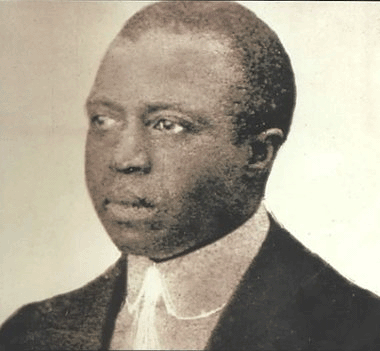
Scott Joplin
Scott Joplin's most
distinctive compositional attribute was that of combining syncopated and percussive right-handed motifs
with a European Polka harmonic structure. According to “The History of the
Blues” (1995 by Francis Davis, Hyperion, New York), “Ragtime borrowed its
harmonic schemes and its march like tempos from Europe, but the syncopations
that marked it as new were African-American in origin, possibly derived from the
music of rural fiddle and banjo players.”7
Indeed, in "The Smithsonian Collection of Classic Jazz" (1987, Smithsonian Institution Press)38, Martin Williams states (page 13), "Ragtime was basically a piano keyboard music and, one might say, an Afro-American version of the polka, or its analog, the Sousa-style march." In this same publication Martin Williams also states (page 14) that "ragtime introduced, in the accents of its right-hand melodies, delightful syncopations onto the heavy 2/4 oompah rhythm of its cakewalk-derived bass line...."38 Yet, precisely because of the lack of syncopation in the left-hand bass lines, the poly-rhythmic potential of Ragtime was severely limited as compared to the simultaneous right and left-hand syncopations of Boogie Woogie, and other forms of Jazz that developed later.
The regular, and incessant, 2/4 “oompah” polka-like left-hand bass lines of Ragtime give it a distinctively different march like feel with less potential for the poly-rhythmic complexities when combined with right-hand parts. In contrast, the shuffled, walking, swinging, or “rolling” bass line of Boogie Woogie can yield substantial polyrhythmic complexity when combined with intricate right-handed parts of Boogie Woogie. Although some Ragtime had intricate right-hand parts, because of the unvarying, non-syncopated left-hand bass lines, Ragtime never realized the polyrhythmic heights achieved by Boogie Woogie. Indeed, in Music in a New Found Land: Themes and Developments in the History of American Music14, Wilfrid Mellers writes (page 278):
In the
same book14,
Wilfrid Mellers also writes (pages 277-278):
“Yet while rag is a composed music, an emulation of white techniques that seems to belie the instinctual character of American Negro music, it is also in an odd way a parody music – like the Cake-walk from which it had descended. And we cannot be sure whether it parodies the white man’s image of the Negro or the Negro himself; We can only feel that there is a certain pathos in the Negro’s obsession with “white” rondo form as an attempt to tame, even to “civilize”, the rhythmic hysteria of barrelhouse stomp, especially as exemplified in the train pieces. The essence of the rag is its unremittent rhythmic pattern which, though habitually syncopated, is never violent. The melancholy, the frenzy, the ecstasy of the blues are all banished. Instead of lament or orgy, we have a dead-pan manner that shuts out personal sensation. The music is hard, bright, obstinately eupeptic and incorrigibly cheerful; in its machine-made way it is even elegant, like the Negro dandy wearing his straw boater at a raffish angle. In so far as the inane grin and the prancing vivacity attempt to shut out the painful actuality of the Negro’s experience, there is an affinity between piano rag and the positively ebulliently entertainment music we referred to in the previous chapter: rag is the Negro’s attempt at the buoyant optimism of the Sousa march and the brilliant elegance of the Gottschalk dance, and the mass feeling is depersonalized because personal feeling may be too much to bear. In this sense, rags are an alternative to the blues; and their use of the discipline of military music becomes equated with the disciplined non-humanity of a machine. This is literally true: for many rags were transferred to the pianola roll and, even if not played by a machine, should be played like a machine, with meticulous precision. Perhaps it is better to be a merry machine, the music says, than to be human but blue: so the queer, sad poetry of the best rags comes from the flimsiness of the gay mask they wear. Although this poetry may be inherent in the situation rather than in the music itself, the later rags of the master of the convention, Scott Joplin, unobtrusively readmit those elements of tension which the rag had tried to deny. Euphonic Sounds (43), for instance, written in 1909, has some oddly elliptical modulations in its second strain, wandering from tonic B flat to B minor, to E flat, and then from G minor to D flat major, changing to the relative B flat minor, and so back to tonic major; in the first strain it also indulges in syncopations in which the beat is merely implied. In the later Magnetic Rag (44) such elements of relative complexity are structural as well as incidental, for Joplin modifies the third and fourth strains so that they acquire some of the features of a sonata development. Joplin thus confesses to an element of duality, even of dubiety, in his attempt to relinquish the blues’ tension. Related to this, perhaps, is the fact that his rags are often quite difficult to play; one cannot merely take them in one’s stride – unless one’s stride happens to be exceptionally large and agile.”
Is Ragtime or Boogie Woogie More Difficult to Play?
There is a long history of snobbery and resentment from some Ragtime players towards Boogie Woogie players. Interestingly, there does not seem to have been as much resentment from Boogie Woogie players towards Ragtime players. Specifically, the most resentment seems to have come from Ragtime players who tended to play with 2-to-the-bar, oom-pah, "striding" left hand bass figures.
Ragtime and Boogie Woogie players still sometimes get into arguments over whether Ragtime or Boogie Woogie is more difficult to play. For example, one dimension of variability in broken-octaves of Boogie Woogie and the oom-pah bass of Ragtime is the size of the stride between one broken octave couplet to the next in Boogie Woogie, or between the "oom" and the "pah" in Ragtime. Quite often, the arguments over difficulty arise over claims from Ragtime players who say the wide strides in their oom-pah left had parts are harder to play than the closer intervals in some Boogie Woogie bass lines. Yet, size of stride is a dimension of variability that can be made wider in Boogie Woogie or Ragtime, resulting in either style becoming very difficult to play. Consequently, a simple Ragtime piece with small strides would be easier to play that a complex Boogie Woogie piece with large strides. On the other hand, a complex Ragtime piece with large strides and frequently-changing chords would be harder to play than a rudimentary Boogie Woogie with a simple, shuffled-chord bass in a typical blues progression involving only I, IV, and V chords.
Boogie Woogie players will often argue that improvisation, and the independence of left and right hand required to create the complex polyrhythms of Boogie Woogie requires more skill than that typically required to play the striding bass of Ragtime. Yet, a Ragtime piece with a wide stride with ever-changing chords between each oom-pah requires a high degree of skill.
Therefore, since there is potentially infinite variability of difficulty in the genres of both Boogie Woogie and Ragtime, to globally label and stereotype one genre as harder or easier to play than the other makes no sense. Instead, it makes more sense to say that different (although somewhat overlapping) skill sets are required for each style of music.
Hersal & George W. Thomas, Jr. Influenced Jimmy Yancey, Albert Ammons,
Meade "Lux" Lewis, and Other Boogie Woogie Players in Chicago
Evidence that Ammons was influenced by Texas Boogie Woogie musicians (especially Hersal Thomas) who had moved to Chicago was provided in 1939 in Chapter VIII (“Boogie Woogie”) of Jazzmen1, where historian William Russell wrote the following on page 189:
"Albert Ammons is younger than most of the Chicago blues pianists, but he was old enough to be a member of the Eighth Illinois Home Guards during the World War. In his early teens he joined the bugle and drum corps. They had fourteen buglers and fourteen drummers; Albert was one of the drummers. Both his parents played piano. Not long after the war, he started to learn the blues and soon knew two or three good pieces. He listened to the Yancey brothers and to other Chicago pianists, including Hersal Thomas, another remarkable musician who never gained more than local fame. Hersal played all the favorite blues and was known especially for his own Suitcase Blues. In those days if a pianist didn’t know the Fives and the Rocks [composed by George and Hersal Thomas from Texas] he’d better not sit down at the piano at all. Whenever Hersal Thomas, who made a deep impression on young Ammons, came to a party, the other pianists were afraid to play; so he became unusually popular and got all the girls.”
Other evidence documenting the influence of George and Hersal Thomas on Albert Ammons and Meade "Lux" Lewis comes from "5 Boogie Woogie Piano Solos by All-Star Composers" (a book of sheet music) edited by Frank Paparelli, Copyright 1942, Leeds Music Corporation, RKO Building, Radio City, New York, NY.12 This source states:
"Albert Ammons and Meade 'Lux' Lewis claim that 'The Fives,' [copyrighted in 1921 and published in 1922] the Thomas brothers' musical composition, deserves much credit for the development of modern Boogie Woogie. During the twenties, many pianists featured this number as a 'get off' tune and in the variations played what is now considered Boogie Woogie."12
Indeed, all modern Boogie Woogie bass figures can be found in "The Fives," including swinging, walking broken-octave bass, shuffled (swinging) chord bass (of the sort later used extensively by Ammons, Lewis, and Clarence "Pine Top" Smith), and the ubiquitous "oom-pah" ragtime stride bass.
In the liner notes to the 1967 Sippie Wallace album, "Sippie Wallace Sings the Blues," released by Storyville Records, historian Paul Oliver wrote the following about the influence of and untimely death of Hersal Thomas:
"This was an irreparable loss to the piano blues as witness the memories and testimony of such performers as Jimmy Yancey and Albert Ammons. Every pianist tried to play his 'Rocks' and 'Fives,' and learned his figures from his [Hersal's] records; one was Little Brother Montgomery from Louisiana whose support to Sippie on "Special Delivery Blues", "I'm a Mighty Tight Woman" and "Murder's Gonna Be My Crime" evoke shades of the great Hersal."70
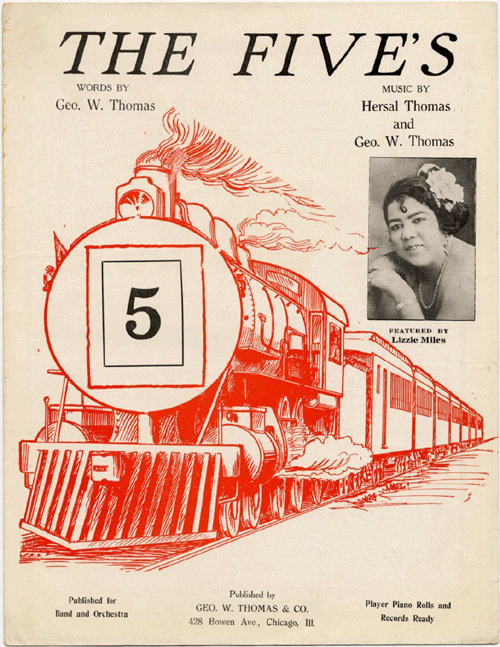
Above is the cover of the "The Five's" (usually referred to as "The Fives" without an apostrophe), copyright registered in 1921 by Hersal and George, and published in 1922. If anyone has a full copy of this sheet music, I would love to hear from them at nonjohn@yahoo.com.
Although he provides some valuable historical information in "Jazzmen"1, William Russell mistakenly wrote that Jim Yancey had written, "The Fives."
In "Jazzmen"1, Russell erroneously writes,
"Around five o'clock in the morning when almost everyone was knocked out and things were getting pretty dull and awfully quiet, someone over in a corner came to life and yelled out, 'Let's have some blues.' Then Jimmy obliged with his Five O'clock Blues, known as the Fives for short."
However, Borneman disputes the idea that "The Fives" are short for "Five O'clock Blues." (See the Borneman quotation below.)35
In "Jazzmen"1, Russell also erroneously writes,
"His [referring to Yancey] first piece, the Fives, is probably the germ from which most of the piano blues of the Boogie Woogie type grew, and after a quarter of a century, it can still hold its own in dynamic interest and vitality when compared with later versions."
Although Russell was mistaken to credit Yancey with having written "The Fives," Russell was correct when he wrote that "The Fives" is "probably the germ from which most of the piano blues of the Boogie Woogie type grew...."1 However, it is Hersal and George Thomas who deserve the credit for spreading the musical motifs heard in "The Fives" from Texas to New Orleans, and then to Chicago. Witnesses to this fact include Albert Ammons, who indicates that Yancey was NOT the author of, "The Fives." Instead Ammons claims that Hersal Thomas brought the "Fives" to Chicago. Ammons, who was a pupil who admired Yancey, would have had no obvious motivation to credit Hersal Thomas while discrediting Jim Yancey. Thus, Ammons' claim should be taken seriously.
Specifically, Ammons'
refutation of
Russell's claim can be found on page 21 of Ernest Borneman's chapter on
"Boogie Woogie," in chapter 2 of "Just Jazz"35:
"Hersal Thomas, composer of 'Hersal Blues' and 'Suitcase Blues', was the first
person, according to Albert, to bring the 'Fives' to Chicago. Some critics have
said that the Fives are short for 'Five O'clock Blues', a title under which Jim
Yancey recorded them. But it seems much more likely that they take their name
from that rudimentary boogie bass, fingered by first and fifth finger alone,
which takes the tonic, adds the fifth and alternates back and forth between it
and the sixth."35
Moreover, William Russell in his chapter titled "Three Boogie-Woogie Blues Pianists," in the book, "The Art of Jazz: Essays on the Nature and Development of Jazz,"62 edited by Martin Williams, Oxford University Press, 1959, states the following about Jimmy Yancey's time on the T.O.B.A. circuit (page 100):
"Jimmy never played piano on the stage; in fact he didn't start to learn it until he was fifteen."62
Thus, since Yancey was born in 1898, Yancey did not start to play the piano until 1913, which is 2 years after George W. Thomas was witnessed by Clarence Williams to have been playing Thomas' "Hop Scop Blues" (later renamed "New Orleans Hop Scop Blues") in Houston, Texas. Thus, this lends still more evidence that Boogie Woogie had undergone significant development before Yancey ever started playing the piano.
On page 17 of the February 19, 1959 issue of Down Beat, Meade Lux Lewis speaks about the pianist who caused him to shift his allegiance from violin to piano:
"Lewis considers that the primary reason for his shifting allegiance to piano [from violin] was the emergence on the Chicago scene of a pianist from St. Louis, Mo., whose name he cannot remember."55
and
"This man played The Fives. It was something new and it got Ammons and me all excited. (Sure wish I could remember his name.) The best way to describe his way of playin' is to say that the right hand played The Fives while the left hand didn't matter. You could play any kind of left hand -- a rumble bass, a walkin' bass, and so on."55
Given the most probable railroad route from Texas to Chicago, Hersal Thomas would have almost certainly come "from" St. Louis to arrive in Chicago. Moreover, Meade Lux Lewis' account of a man "from St. Louis" who "emerged on the Chicago scene" playing "The Fives" indicates that this person was not Yancey (who was from Chicago), and moreover, that Yancey had not been what inspired Lewis to switch his instrument from violin to piano.
Meade Lux Lewis also discusses "the Fives" in an interview he gave to Don Hill and Dave Mangurian in 1961 in Los Angeles at Meade Lux Lewis's house in the Watts district of Los Angeles.
This interview was
transcribed on pages 16-28 of Cadence Magazine, Volume 13, Number 10,
October, 1987.
Starting on page 17 of this issue of Cadence Magazine, the
following statements are made by Lewis:
"I went to the Webster School, in the Southside of Chicago
with Albert Ammons."
and
"I continued on at Webster and then went to what they call
the South Division High School. When my father died I left there and had
to go to work. They had something they called a 'continuation school' --
that's the heading it came under. That was compulsory. A lot of kids
were leaving school ahead of time and the education was so bad until they made
it a ruling that they had to go into a 'continuation school' for a certain
length of time. I never did finish that."
and
"At that time I was was very much interested in automobile mechanics and I was doing pretty good. But music seemed to take hold of me because some fellow came up from St. Louis and he started playing this tune they call, 'The Fives.' It seems that he went around to different houses where they were having parties which was a natural thing in those days. And he was playing this tune. Well, it seemed that all of the youngsters got a kick out of it and some of the older people did too -- the tune caught on like wildfire. It seems like every time some guy would start playing "The Fives' all the gals would crowd all around him like mad. So I told Al, I said, 'We gotta learn how to play this stuff; let's get together."
and
"That particular tune they called 'The Fives' was put into the category of 'boogie woogie' music because boogie woogie was based on 'The Fives.' Well, as time went on conditions changed, people were moving to other cities and the first thing you know, why, the old neighborhood changed pretty fast...."
and
"So it happens in the year of 1924, I went down to visit my relatives in Louisville, Kentucky."
Lewis's comments from Down Beat and his comments quoted in Cadence Magazine, taken together with Ammons' claim that Hersal Thomas had brought "The Fives" to Chicago35, indicate that Hersal Thomas was almost certainly the person that Meade Lux Lewis was talking about when he was discussing the person who "came up from St. Louis" to bring "The Fives" to Chicago. It is interesting to note that Lewis never says that the person who brought "The Fives" to Chicago had been born in St. Louis, but rather used the qualifier "from" or "came up from," both of which are perfectly consistent with that person having been Hersal Thomas.
Another source that is consistent with Lewis's comment about noticing the attention of women given to the person who played "The Fives," and therefore wanting to collaborate with Ammons to "learn how to play this stuff" comes from Sippie Wallace, who told Axel Zwingenberger that Albert Ammons "would drop by their house every day in order to learn from Hersal."
This account was
revealed by Axel Zwingenberger in an interview by Judy Carmichael of Axel
Zwingenberger on Carmichael's public radio show, "Jazz Inspired." At just over
22 minutes into the intervew, Zwingenberger stated the following:
"....Sippie is a very important part of blues history. And
I was fortunate to meet her in 1982. Actually, my link with Sippie at first came
out a relationship she had with the Ammons family, because Sippie's youngest
brother was Hersal Thomas, and he was one of the most prolific Texas Blues piano
players. And they had moved to Chicago. And Albert Ammons as a teenager became
very interested in that style. And Sippie told me that Albert would drop by
their house every day in order to learn from Hersal. And Sippie called him
actually "Little Albert," which means that she knew him really from almost
childhood days. And Albert had a wonderful version of the Hersal Thomas tune,
'The Suitcase Blues.'"
Recall that William Russell stated the following in Jazzmen:
"He [Albert Ammons] listened to the Yancey brothers and to other Chicago pianists, including Hersal Thomas, another remarkable musician who never gained more than local fame. Hersal played all the favorite blues and was known especially for his own Suitcase Blues. In those days if a pianist didn't know the Fives and the Rocks he'd better not sit down at the piano at all. Whenever Hersal Thomas, who made a deep impression on young Ammons, came to a party, the other pianists were afraid to play; so he became unusually popular and got all the girls.”
Russell's comment that Hersal "got all the girls" is entirely consistent with the description by Lewis, who stated, "It seems like every time some guy would start playing "The Fives' all the gals would crowd all around him like mad."
In the April 19, 1924 issue of "The Music Trade Review," an article titled, “A Juvenile Songwriter" stated:
"Hersal Thomas of Chicago [after moving from East Texas] enjoys the distinction of being one of the youngest songwriters in the world. He has just passed his fifteenth birthday...The outstanding song written by this young songwriter is entitled, "The Fives"...This was his first commercial recording and has been followed by others which are meeting with a good sale among the dealers."
The CD "Boogie
Woogie Blues" released in 1991 by Biograph Records contains digital
recordings derived from the playback of piano rolls made by early Boogie Woogie
artists. Among these is Hersal
Thomas, who had moved from Houston to Chicago with his older brother, George W.
Thomas, Jr. The liner notes of the "Boogie Woogie Blues" CD state:
"Hersal Thomas, king of Chicago's
house-rent party pianists in the middle 1920's, was one of the first to record a
Boogie Woogie solo.”
and
When speaking about the various piano
players at ‘boogie’ or ‘house-rent’ parties in Chicago,
Paul Oliver wrote on page 92 in The Story of the Blues5:
“They included the child prodigy, Hersal Thomas, whose appearance in Chicago and Detroit from Houston, Texas, at the age of fourteen created sensation and profoundly influenced the piano players who heard his grumbling basses and highly poetic melodic inventions.”
and (page 92)5
Paul Oliver wrote, “Pine Top Smith took his wife, Sara Horton Smith, to Chicago and took the room on South Parkway in a building where, coincidentally two other piano-players, Mead ‘Lux’ Lewis and Albert Ammons, were also living.” Ammons has reported having contact with Pine Top Smith. Moreover, both Ammons and Lewis acknowledge having heard and having been excited and inspired by Hersal Thomas. Thus, given his proximity to Ammons and Lewis, Pine Top probably also heard the performances of Hersal Thomas, who was already in Chicago with his brother George no later than 1923 (prior to Pine Top Smith's arrival). Moreover, Pine Top's Boogie Woogie (1928), like than of Ammons and Lewis, clearly shows some elements used by the Thomas brothers.5Moreover, Peter Silvester notes that Yancey's 1939 Solo Art recording titled, "'The Fives' was basically the same piece as 'Yancey Stomp' and 'Midnight Stomp.'" (page 50)9
These 1939 recordings on the Solo Art label were Yancey's first recordings. Of these recordings, Peter Silvester states (page 50):
"It is strictly Yancey material and the titles given to it were probably concocted for the recording sessions."9
Thus, Silvester indicates that titles used by Yancey in these 1939 recordings had NOT been the titles used to refer to Yancey's musical material prior to 1939, but had simply been a re-titling of Yancey's music.
Indeed, if Jimmy Yancey had been playing "The Fives" or similar material in the 1920s, it is hard to believe that he would not have had opportunities to record at that time, as nothing inhibited his communication with the talent scouts from the early record companies that were recording Yancey's associates. Moreover, besides the thriving 'race' recording industry in Chicago at the time, Yancey's having toured on the T.O.B.A. circuit would have given him numerous opportunities to have been discovered and to have traveled to and heard music from various places, including that from Texas. Lastly, unlike Lead Belly, Yancey (to my knowledge) was not incarcerated, which would have made it more difficult to record, as when Lomax had to bring the recording equipment into the prison to record Lead Belly.
Peter Silvester's analysis (page 180)9 of Yancey also raises doubts about Yancey recording so late relative to the other Boogie Woogie players:
"It is a strange fact about Jimmy Yancey's musical career that despite his popularity as a rent party pianist in the 1920s and 1930s he never entered a studio during this period when sale of 'race' records were at their height."9
In summary, not only did Hersal and George Thomas influence Ammons and Lewis, the Thomases also influenced Jim Yancey, as evidenced by Yancey's re-titling his music "The Fives" in 1939. This influence is chronologically consistent with the fact that Yancey did not make his first recordings until 1939, many years after George and Hersal Thomas, and others made their first Boogie Woogie recordings.
Five Meanings of "The Fives"
On page 17 of the February 19, 1959 issue of Down Beat, Meade Lux Lewis described "The Fives" as something that was done with the right hand, rather than the left. Moreover, in 1959, Lewis has trouble remembering the name of the piano player who played "The Fives" for him and Ammons. However, the article indicates the Lewis believed in 1959 that this pianist had been from St. Louis. The article states:
"Lewis considers that the primary reason for his shifting allegiance to piano [from violin] was the emergence on the Chicago scene of a pianist from St. Louis, Mo., whose name he cannot remember."55
This account by Lewis indicates that this person who emerged on the Chicago scene by playing "The Fives" was not Jimmy Yancey, as Yancey was from Chicago, not St. Louis. Moreover, Lewis had named his "Yancey Special" after Jimmy Yancey. Thus, to imagine that Lewis would have been unable to recall Yancey's name is hard to believe. Hersal Thomas' death by poisoning back in 1926 would have been consistent with Hersal's later obscurity and thus the difficulty that Lewis had in remembering Hersal's name. Still, the fact that Lewis though the pianist who played "The Fives" was from St. Louis begs explanation. There are several possible explanations. First, Lewis might have mistakenly thought that Hersal was "from" St. Louis. Hersal almost certainly travelled through St. Louis on his way to Chicago, thus, in this sense, would have indeed been "from" St. Louis. This line of thought, taken along with Ammons' claim that Hersal had brought "The Fives" to Chicago is consistent with Lewis having misattributed Hersal's town of origin. Lastly, the article also indicates that Lewis had weighed as much as "298 pounds" and was "a short, round tub of a man...." who had "....began medical treatments for obesity, went on the wagon, and today sticks to orange juice and a regulated diet." Thus, prior to having "went on the wagon," Lewis' years of excessive alcohol intake could easily have created memory problems for Lewis, causing him to have misattributed Hersal's town of origin.
Lewis also indicates the following on page 17 in this 1959 Down Beat article about the man who played "The Fives":
"This man played The Fives. It was something new and it got Ammons and me all excited. (Sure wish I could remember his name.) The best way to describe his way of playin' is to say that the right hand played The Fives while the left hand didn't matter. You could play any kind of left hand -- a rumble bass, a walkin' bass, and so on."55
Since Ammons has said that Hersal Thomas was the first person to bring "The Fives" to Chicago, it is reasonable to infer that Lewis was talking about Hersal.
Of course, it is probable that "The Fives" has been used to refer to things that can be done by both the right and/or left hands, and thus both Lewis' and Borneman's explanations would be correct.
This explanation for the origin of the name, "The Fives," contradicts the account given by Russell of being derived from a 5 O'clock performance time by Yancey or of a 5 O'clock departure time for a Chicago steam locomotive (as claimed by some historians).
Borneman's and Lewis's music-theory explanation for the origin of the term, "The Fives," is consistent with other traditions in naming that allude to purely musical attributes, such as "8 to the bar," and "Sixteen," a term used by Eubie Blake to refer to playing four notes in the left hand for every one played in the right, thus yielding 16 notes in the left hand for each 4/4 measure played.
However, the cover and the lyrics of Hersal and George Thomas's "The Fives" provide three other specific meanings for "The Fives." George Thomas's lyrics for "The Fives" refer to both a 5 p.m. and a 5 a.m. arrival time for a train arriving in "Frisco" [San Francisco] and a time at which "he got the engineer told....":
"Five P. M. we due in Frisco...."
and
"We'll be in Frisco tomorrow morn sure at Five...."
and
"Fireman turned on water and he shevel in some coal, Five o-clock this morning he got the engineer told...."
Although the line above clearly refers to a 5 a.m. time, it is not clear that it is referring to an arrival time, but appears instead to be the time at which the "Fireman" communicated with the "engineer."
Although the lyrics do not explicitly mention "Chicago," Thomas writes:
"I'm leaving town..."
and
"...that West bound train does Run...."
Thus, it is clear that Thomas meant to refer to a departure town with a location east of San Francisco. He might have intentionally been non-specific about the departure location so as to give the lyrics broader appeal. However, since George Thomas was living in Chicago when he wrote these lyrics, many have assumed that the "town" from which he is leaving is Chicago. However, I have not confirmed if there was actually a Frisco-bound train(s) with a "5" identification number, or whether there was a train(s) from Chicago that arrived in San Francisco at either 5 p.m. or 5 a.m. Still, Chicago seems to be the best working assumption.
The number 5 on the cover of the sheet music, and the fact that the train is 4-6-0 with 5 axels (see above) is consistent with George Thomas' lyrics specifically referring to the locomotive as "Old Five" and "number 5" in the lyrics to "The Fives." The fact that the number 5 is associated with the depicted train in these two ways suggests meanings beyond referring only to a time of arrival. Moreover, in addition to the system of notation that classifies steam locomotives by the number of wheels, classifying steam locomotives is by their number of Axels is common. That is, the steam locomotive on the cover of "The Five's" sheet music is a 4-6-0 (by number of wheels) and a "5" by number of axels. The system of classifying steam locomotives by their number of axels is still commonly used in Europe. Specifically, the lyrics state:
"Old Five ready to take me away,..."
and
"Here come number 5 she make a mile a minute..."
The fact that their is an apostrophe in the title, "Five's" on the cover of "The Five's" is quite likely to be semantically significant, as it implies that George Thomas wanted to refer to 5-axel steam locomotives in plural, rather than refer only to a specific steam locomotive using "5" as its identification number. Moreover, in Europe, 5-axel steam locomotives are still referred to as "the fives." Thus, it makes perfect sense to use "The Five's" to refer collectively to all 4-6-0 steam locomotives.
The final line of "The Fives" provides the most metaphorical meaning of "The Fives:"
".....I've got the Frisco I mean Frisco evening Fives."
At first glance, this line might appear to be referring to an evening arrival time. However, the expression "....I've got...." suggests a state of mind, such as when one says "I've got the Blues." However, George Thomas does not appear to be referring a depressed or sad mood. Instead, given the exuberant imagery of Thomas' lyrics, having the "Frisco evening Fives" sounds like he is ready to have an exciting night out in San Francisco.
Since George Thomas previously changed the title of his "Hop Scop Blues" to "New Orleans Hop Scop Blues," and since he added lyrics referring to New Orleans to his purely-instrumental "Hop Scop Blues" that he had previously performed in Houston, a similar process probably took place when he wrote lyrics to "The Fives." That is, "The Fives" could have originally been an instrumental piano piece, whose title referred to characteristics about the intervals or meter in right and/or left hands, but this would have not prevented George Thomas from giving "The Fives" new meanings by adopting lyrics inspired by this pre-existing name. By writing lyrics for "The Fives" while living in Chicago, Thomas could appeal to the desire of African Americans to travel from the hardships of Chicago or other cities to places that they imagined to be better, such as California.
Thus, "The Fives" can have at least FIVE different meanings:
1. The hands themselves -- Cassell's Dictionary of Slang, 2006, page 510, mentions several meanings of "fives," including "the hand usually when clinched in a fist," which is attributed to the late 18th century. It also gives a 17th century usage of "fives" as meaning "a foot." Cassell's says in mid 19th century, "fives" came to mean "street fight" (once again suggesting fists). The association with fists and fighting suggests the expression, "two-fisted piano" and "dueling pianos." Boogie Woogie has a history of being played competitively (a kind of "fight") to impress women. In the 1990s, "fives" came to mean masturbation.
2. Something that the left or right hand does
3. Statistics or numbers associated with locomotives - A quantity of locomotives; identification numbers; number of axels on a 4-6-0 (a.k.a. 10-wheeler) locomotive; or numbers in some way representative of the characteristics of locomotives -- The "five fine locomotives" of the Southern Pacific Railroad of Texas which were transferred to the Texas & Pacific Railroad in 1872; or "Old Five" & "number 5" in "The Fives" sheet music.
4. Times on the clock - both 5 p.m. and 5 a.m.; including arrival times and a time at which the "Fireman....got the engineer told."
5. "The Frisco Evening Fives" -- a restless state of mind with an accompanying desire to transcend one's current situation through travel and pleasurable activities.
Classically Trained Musicians Take Boogie Woogie Seriously
In
1940 in the Introduction (page1) to "Boogie Woogie Piano Styles—No. 1 The
History, Development and Art of Playing the Boogie Woogie Style,”17
Alec Templeton wrote:
“It was just ‘ragtime’ back in the post-world war days. Later they called it ‘jazz.’ In 1934 ‘swing’ became the thing. Today there is increasing popular interest in the style of music known as ‘Boogie Woogie.’”
“Ragtime, jazz, and swing each contributed materially to the progress of American dance music and I feel that boogie woogie, too, is destined for a permanent niche in the music field and that it will leave its mark as a purely American development, not only on dance music but on more serious music as well.”
“Already numerous ‘classical’ musicians of my acquaintance have accepted boogie woogie. They realize, as do I, that the Negro playing this peculiar style has achieved something actually creative. Many see in the simple harmonic structure of boogie woogie, with its unlimited possibilities of variations, the starting point of a much needed trend toward individualized, contrapuntal music, a conclusion to which I also subscribe.”
“Today, America is boogie woogie conscious. Dance bands throughout the land are featuring it. Dozens of phonograph records are being issued, featuring boogie woogie artists. I have found it a most interesting style myself, and must confess I derive unusual enjoyment playing it.”
In
1939 in Chapter VIII (“Boogie Woogie”) of Jazzmen1,
William Russell wrote the following on page 205:
Conlon Nancarrow is another classical musician who has appreciated and composed in a complex Boogie Woogie style. See section on Nancarrow below.
William Russell's Chapter VIII in Jazzmen1, (titled "Boogie Woogie") is possibly the first formal historical book chapter written specifically about the history of Boogie Woogie. However, other sections of Jazzmen besides Russell's chapter also discuss Boogie Woogie. If anyone knows of any earlier book chapters on the history of Boogie Woogie, or other references, please email me at nonjohn@nonjohn.com.
The Thomas Family: "The First Family of Boogie Woogie"
George Washington Thomas, Jr. and his younger brother Hersal were regarded as seminal influences by later Boogie Woogie players, such as Albert Ammons and Meade "Lux" Lewis. Although both George and Hersal died tragically at a young age after they moved to Chicago, their having brought Boogie Woogie from the Piney Woods of East Texas to the Big Cities -- first to Houston, then to New Orleans and Chicago -- substantially influenced the course of popular music. Although Albert Ammons, Meade "Lux" Lewis, and Pete Johnson are often considered the prototypical "Big Three" of Boogie Woogie, there is no question that at least Ammons, Lewis, and Johnson drew much of their inspiration from George and Hersal Thomas, as well as from Clarence "Pine Top" Smith, who also suffered a tragically young death after moving to Chicago.
Since George Washington Thomas, Jr. was born in 1883 in Little Rock and since his father, George Thomas, Sr. became a deacon at the First Shiloh Baptist Church in Houston, and since younger sister Beulah (A.K.A. Sippie Wallace) was born in Houston in 1898, it is possible to trace what would have been the most likely migratory pathway used by the Thomas Family as they migrated from Little Rock, AR to Houston, TX. Before 1900, railroads would have been the most likely form of transport for African Americans and others travelling such a distance. Coming into contact with steam locomotives is consistent with their chugging sound, felt by many to sound like Boogie Woogie. Since George W. Thomas, Jr. says that he based his "Hop Scop Blues" (later "New Orleans Hop Scop Blues.") on music he heard in East Texas, it would be logical to surmise that the migratory pathway of the Thomas family took them on the shortest railroad route that ran from Little Rock, through east Texas, and finally to Houston. Such a migratory path would have also taken the Thomas family through Marshall, Texas, the headquarters of the Texas & Pacific Railroad, and the only site (as far as I know) to have ever manufactured steam locomotives in Texas. Given these reasonable assumptions, the Thomas family probably relied on three railroads in the Jay Gould system to transport them from Little Rock to Houston as early as 1883 (the year of George Thomas, Jr.'s birth) , but no later than 1898 (the year of Beulah Thomas's birth).
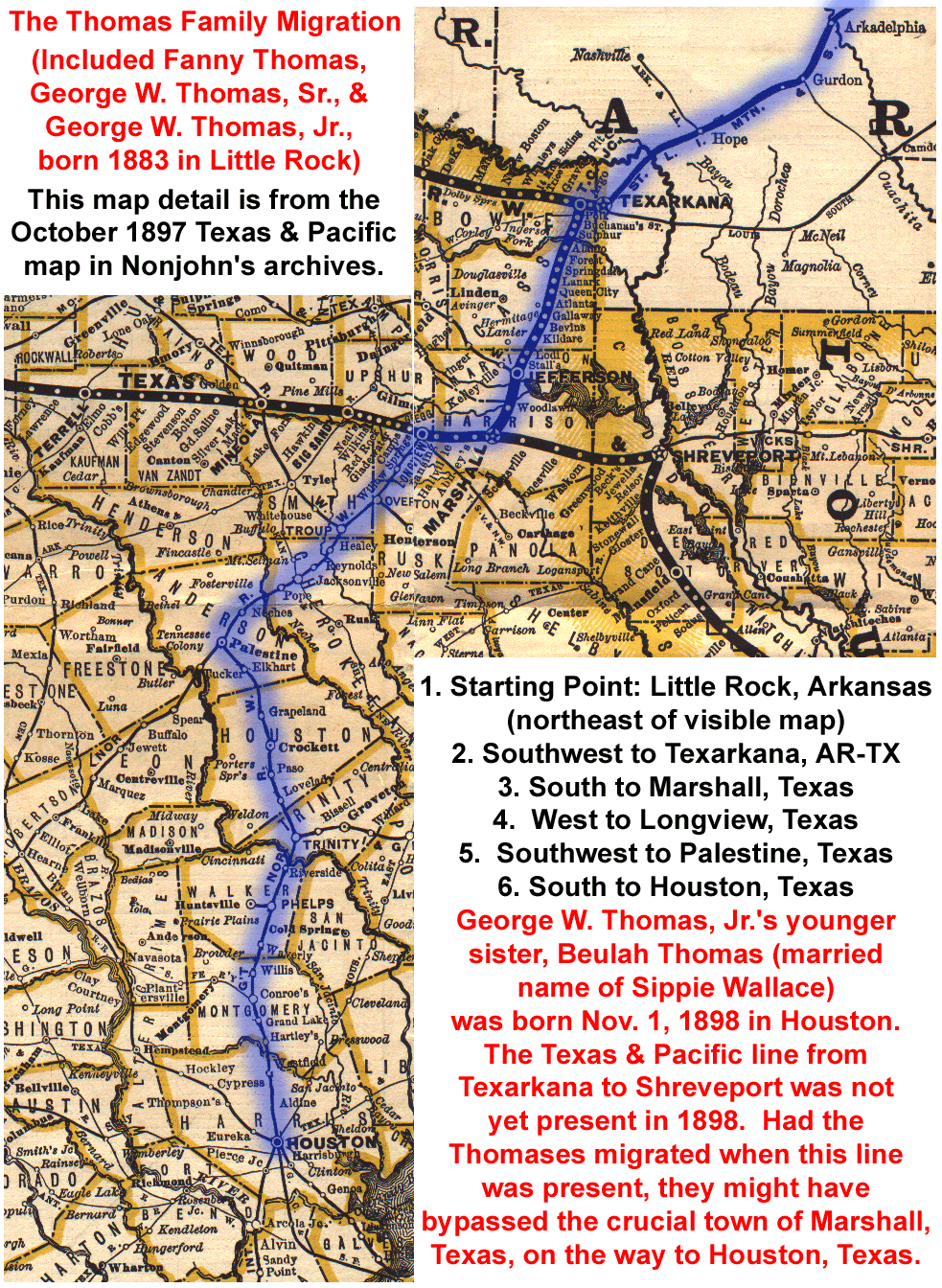
(Blue Highlighting indicates the probable migratory pathway of the Thomas family after the birth of George W. Thomas, Jr. in 1883 - illustrated by John "Nonjohn" Tennison. Copyright 2004. All rights reserved.)
The First North-South Railroad Corridor Through the Piney Woods of East Texas
The first north-south railroad through the Piney Woods of East Texas was established in 1873 when the Texas & Pacific Railroad completed its line from Marshall to Texarkana; and when (also in 1873) tracks built southward from Longview (on the Texas & Pacific line west of Marshall) by the International Railroad met up in Palestine with tracks built northward from Houston by the Houston & Great Northern Railroad. In 1873 both the International Railroad and the Houston & Great Northern were absorbed into what became the International and Great Northern Railroad. (Subsequently, this railroad and the Texas & Pacific became part of the Jay Gould system of railroads. See Jay Gould section.) With the exception of the northern portions of Harris County and the southern portion of Montgomery County (just north of Harris County), this north-south railroad corridor established in 1873 from Texarkana to Houston was completely contained within the Piney Woods of East Texas. From north to south, this corridor contained the following towns: Texarkana, Atlanta, Jefferson, Marshall, Longview, Tecula, Palestine, Crockett, Trinity (originally "Trinity Station"), New Waverly, and Houston.

The map above is adapted from Charles Zlatkovich's excellent book, "Texas Railroads." Although this map shows railroads as they existed in 1880 (by Texas Railroad Commission Records), the north-south corridor (along which town names have been added in red by John Tennison) was established in 1873. The dates in parentheses by some town names indicate the year when a railroad arrived in that particular town.
Three Railroads in the Jay Gould System Probably Brought the Thomas Family to Houston
1. St. Louis, Iron Mountain, & Southern (from Little Rock, AR southwest to Texarkana, TX) This railroad company was formed in May of 1874 from a merger of the St. Louis & Iron Mountain, the C&F, and the CA&T. The St. Louis, Iron Mountain & Southern Railway Company merged into the Missouri Pacific company in May of 1917. Thus, from 1883 until 1898 (when Beulah Thomas (George's younger sister) was born in Houston), the St. Louis, Iron Mountain & Southern Railway Company would have been the logical choice for rail travel from Little Rock to Texarkana.
2. Texas & Pacific (from Texarkana, TX south to
, TX and then west to Longview, TX). This railroad company was formed in 1871. Travel through Marshall would have taken the Thomases through the pounding sound of the town (am I some kind of poet?) of Marshall, the Chugging heart of the Texas & Pacific Railroad Manufacturing and steam locomotive maintenance shops. As stated elsewhere in this article, the Texas & Pacific Railroad company has a stronger association with the early development of Boogie Woogie than any other railroad. Thus, it is "The Boogie Woogie Railroad." This particular part of the Texas & Pacific existed completely in the Piney Woods of East Texas.
3. International & Great Northern (from Longview, TX to Palestine, and then south to Houston). The International & Great Northern company was formed in September of 1873 from a merger of the Houston & Great Northern (formed October, 1866) and the International Railroad Company (formed August, 1870). Like the Texas & Pacific Route above, (with the exception of portions of northern Harris County & southern Montgomery County) this part of the International & Great Northern exists completely in the Piney Woods of East Texas.
An Explanation of the "Jay Gould System" of Railroads
Of all the railroad tycoons of nineteenth century, Jay Gould was perhaps the most notorious and hated. In 1880 (three years prior to the birth of George W. Thomas, Jr. in 1883), Jay Gould acquired control of the St. Louis, Iron Mountain, & Southern; the Texas & Pacific; and the International & Great Northern Railroads. As a result of Gould's control of these three railroads, and his ruthless desire to maximize his own profits, Gould had advertisements published that emphasized travel on these railroads as a single system, one that came to be known as the "Gould System of Railroads." Maps in timetable brochures for these railroads emphasized the routes in the Gould System with bold lines that suggested travel through and to certain destinations served by the Gould System, thus resulting in a flux of travelers through or to these destinations. Other advertisements in magazines and public signs emphasized travel involving locations served by the Gould System (See photo of Texas & Pacific sign in Deep Ellum below.) It was easier to travel on a route that had already been programmed for travelers, as compared to switching to a competitor's line for which porters and others might be less motivated to provide assistance. Thus, not only does the migratory route from Little Rock to Houston that I have proposed for the Thomas family seem most likely from a standpoint of geographical efficiency, such a migratory route also seems most probable because all three railroads were part of the Jay Gould System.
Ultimately, all three of these railroads merged into the Missouri Pacific Company, which later merged into today's Union Pacific Railroad Company:
On May 12, 1917, the St. Louis, Iron Mountain and Southern
was merged with the Missouri Pacific.
On March 1, 1956, the International & Great Northern was merged into the Missouri Pacific Railroad Company.
On October 15, 1976, the Texas
& Pacific was merged into the Missouri Pacific.
In 1982, the Missouri Pacific Company merged with the Union Pacific Railroad Company.
The Maturation of Boogie Woogie Paralleled the Maturation of Steam Locomotives
The repetitive, ostinato, departing-acceleratory, chugging, thumping, rattling sound; as well as the bluesy Doppler-effected, pitch-shifted wail of steam whistles on steam locomotives inspired musical elements heard in Boogie Woogie and Blues music. Moreover, it is interesting to note that the maturation of Boogie Woogie paralleled the sound, power, and speed of maturing steam locomotive technology. Also of significance is that the 1920s maturation of Boogie Woogie occurred in Chicago (the nation's largest railroad hub), and not in New York City. The development of Boogie Woogie in Chicago (and not in New York) might not be a coincidence in that Chicago's laws allowed steam locomotives to come chugging into the heart of downtown past dwellings and businesses. However, New York City's laws did not allow steam locomotives within the city limits. Thus, Boogie Woogie players who had moved to Chicago from the south had the continued opportunity to regularly hear and be inspired by the ever faster, ever louder, ever more powerful sound of maturing steam locomotive technology. People living in New York City, however, had fewer opportunities to hear and thus be inspired by these characteristics of the sound of steam locomotives.
The Texas Type 2-10-4 Super-Power Steam Locomotive: A Metaphor for "Fast Texas" (Boogie Woogie) Piano
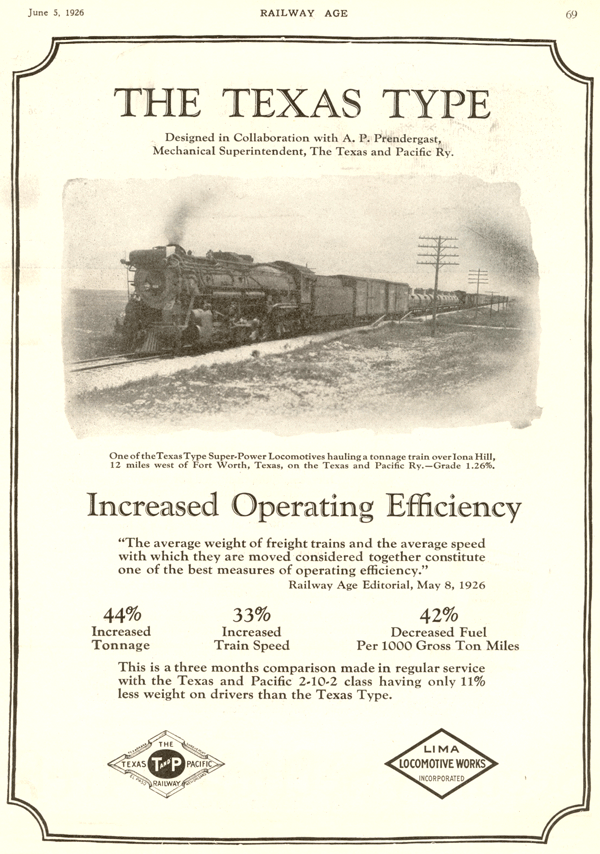
The Texas Type 2-10-4s were among the increasingly faster and more powerful steam locomotives to be designed and produced in the 1920s. The ever-increasing tempo of performed and recorded Boogie Woogies correlated with the increasing speed and power of steam locomotives.
The National Spread of Boogie Woogie
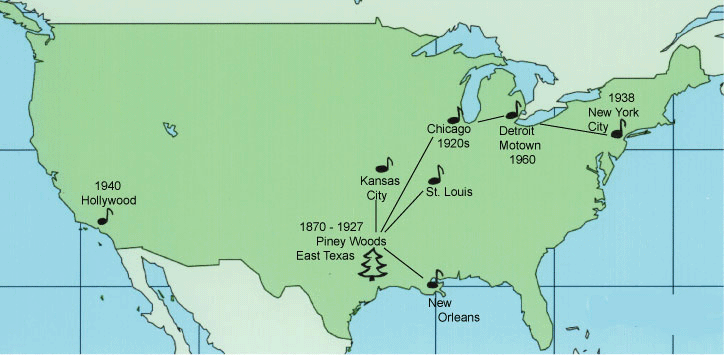
The above map was created by Krystyna Parafinczuk and is used with her permission. Thanks!
The Earliest Sheet-Music Publication of a Boogie Woogie Bass Figure
George Washington Thomas, Jr., is credited by Clarence Williams as playing with a Boogie Woogie bass figure in 1911 in Houston, Texas. Moreover, Clarence Williams credits Thomas with being the first man to write down a Boogie Woogie bass figure. However, George Thomas did not publish his Boogie Woogie bass figure until 1916 in his "New Orleans Hop Scop Blues." In 1915, Artie Matthews published what is an undisputed Boogie Woogie broken-octave walking bass figure in his "The Weary Blues." Although some might argue that Blind Boone's 1909 sheet music publication of "Southern Rag Medley No. 2" would constitute the first "Boogie Woogie" bass figure, such a claim is disputable for reasons that I have argued above. However, "the cows," which appears in a classic 12-bar form in "The Weary Blues" is a classic, undisputed Boogie Woogie bass figure, and one that is reported to have originated in Texas.5, 68
Interestingly, "The Weary Blues" has been recognized since at least 194994 as being an example of published sheet music with a Boogie Woogie bass figure. Specifically, on page 32 of "A Treasury of the Blues,"94 Abbe Niles wrote the following in 1949:
"By contrast, "boogie-woogie," which, after long incubation, came in with a roar a little later, from the springboard of an early record by "Pine Top" Smith (a Negro whose fame was posthumous), was almost pure blues: in the twelve-bar pattern and with the same three basic chords (see p. 14), but with a double beat ("eight to the bar"). This beat was given, against a syncopated treble, by a constantly repeated bass figure, or a 'walking bass' as had been used as early as 1915 in Artie Matthews' Weary Blues."94
Despite this recognition by Abbe Niles, subsequent publications and declarations by "experts," even after the year 2000, continue to mistakenly cite other pieces, such as "New Orleans Hop Scop Blues," as the earliest published sheet music containing a Boogie Woogie bass figure.
Artie Matthews
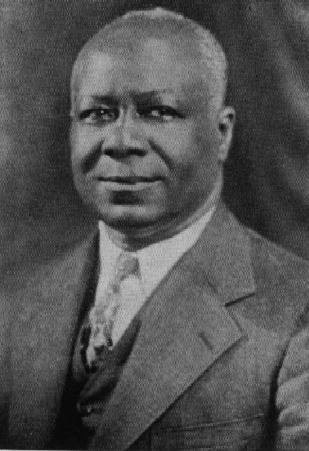
The bass figure used by Matthews in "The Weary Blues" is what has been clearly identified as "the cows," one of the oldest Boogie Woogie bass figures that is said by Lee Ree Sullivan to have originated in Texas, and was also known as the "Texas and Pacific Bass" figure. Sullivan told me that "the cows" originally referred to the grace-noted right-handed figure that was meant to suggest the sound of cows being pushed away by the cow catcher grill at the front of steam locomotives. However, Sullivan said because the right-handed figure was usually accompanied by the left-handed "Texas and Pacific Bass," the bass figure (which was intended to represent the sound of the steam locomotive), came also to be known as "the cows".68 [The Texas & Pacific Railroad has a well-documented history of the significant challenges posed by cows on its tracks.] Moreover, Paul Oliver says that Cow Cow Davenport also borrowed "the cows" for use in his "Cow Cow Blues," after having heard it being used in Texas.5
Another Early Sheet-Music Publication of a Boogie Woogie Bass Figure
Another early sheet-music publication of a Boogie Woogie bass figure can be found in 1916 in George Thomas's "New Orleans Hop Scop Blues." Paul Oliver has noted that George Thomas based his "New Orleans Hop Scop Blues" on music that he had heard being played in East Texas.5
George W. Thomas, Jr. was reportedly born in Little Rock, Arkansas in 1883. (According to one account, George Thomas, Jr. died in March of 1930.) (I don't know the place of his burial.) George Thomas, Jr. was the older brother of sister Beulah Thomas (later known as Sippie Wallace) and younger brother Hersal Thomas. The Thomas siblings often sang in the choir and played at the Shiloh Baptist Church. Hociel Thomas was the daughter of George W. Thomas, Jr.
George Thomas's sister, Beulah Thomas (AKA Sippie Wallace), was born in 1898 in Houston. Thus, the Thomas family had arrived in Houston no later than 1898. Consequently, George Thomas, Jr. likely heard Boogie Woogie music on which he based his "Hop Scop Blues" during the migratory travels of the Thomas family from Little Rock Arkansas to Houston Texas, or possibly from a re-tracing of that pathway after having arrived in Houston. Such a migratory pathway would have most likely taken the family through Texarkana and Marshall, Texas, the headquarters of the Texas & Pacific Railroad, which had the most dense African American population in Texas. Moreover, not only did Marshall contain the repair shops for Texas & Pacific Locomotives, the Texas & Pacific Railroad also manufactured its own steam locomotives in Marshall, TX. Thus, the ostinato, musical sound of the steam locomotives would have been prominent in Texarkana and Marshall . However, Houston was also developing as the other early railroad hub in Texas.
Important Distinctions between Five Kinds of Broken-Octave Bass Figures
What are the necessary and sufficient elements to constitute a broken-octave Boogie Woogie bass line? Some historians have erroneously referred to ANY broken octave bass line as a Boogie Woogie bass line. Yet, there are specific reasons why a broken octave bass is NOT sufficient in and of itself to create a Boogie Woogie feel. For example, broken octaves have been used in the keyboard music of Bach and other classical composers, and at least as early as 1908 in the Ragtime music of Scott Joplin. Although it only occurs for two measures, a broken-octave bass line can be seen on page 6 of Joplin's "Pine Apple Rag," first published in 190841. These broken octaves were played with Ragtime's typical oom-pah pulse, and are not swung. Thus, the mere fact of playing in broken octaves was not a breakthrough for Boogie Woogie, nor does the usage of broken-octaves necessarily yield a Boogie Woogie bass line.

Above is the cover and page 6 of Scott Joplin's Pine Apple Rag. A broken-octave bass line can be seen in the 5th & 6th measures on this page.
The images above are taken from the University of Colorado Digital Sheet Music Collection.
In Bach's music and in Ragtime, the broken octaves were not played with an inherent swing pulse. The breakthrough transitions when the walking quality, ostinato figures, and/or the swing pulse of Boogie Woogie bass figures began to be used. In contrast, the bass chords in Ragtime frequently changed with each oop-pah. Such regular chord changes prevented an ostinato effect to be felt as strongly, if at all, and typically, Ragtime players were "striding," not "walking," as is more often heard in Boogie Woogie.
Even without what I call "Intrinsic Swing Pulse" in the left-hand bass line, a swing pulse can be created in Ragtime by the combination of a non-swinging right hand part (playing the syncopated notes that do not occur on the downbeat) with a non-swinging left hand part (playing the notes that occur on downbeats). I call the Swing Feel created by this technique an "Interactional Swing Pulse." Some Ragtime pieces are played with this effect, but usually the amplitude (loudness) of the straight, oom-pah pulse of the left hand pulse of the left hand in Ragtime competes with the Interactional Swing Pulse, such that the net effect is a performance that does not swing as hard, and thus, still sounds like Ragtime, and is not experienced with as much of a Boogie Woogie feel.
To produce the strongest swing feel, the straight oom-pah pulse must be minimized, if not eliminated all together. To have the strongest swing feel, (unequal) "asymmetric" temporal divisions of 2/3 and 1/3 must be SUPERIMPOSED on top of a equal "symmetric" temporal divisions. Whether or not notes or rests occur at the various temporal divisions, the net effect of all notes and rests will define where the temporal divisions are located, and will determine whether or not a Swing Pulse is created.
With these ideas in mind, broken-octave bass figures can be classified into the following five categories. Category 5 is unequivocally a Boogie Woogie bass figure. Category 2 and 4 will be experienced as Boogie Woogie bass figures IF the bass figures have an interactional relationship to the right-hand part, such that a swing feel emerges. Even with an interactional swing pulse, categories 2 and 4 can be experienced with a Boogie Woogie feel if they have a walking and/or ostinato quality. if the bass has a "walking" and or "ostinato" quality. Categories 1 and 3 will not have a Boogie Woogie feel unless played with a walking and/or ostinato features.
1. Straight Broken-Octave Bass without "Interactional Swing Pulse" - These are non-Boogie-Woogie bass lines. This type of bass is the oldest of the broken octave bass lines, having been used by Bach, and on occasion by Ragtime composers, such as Scott Joplin. However, when Joplin used them, they were still written with a "1-2" oom-pah pulse. That is, if one simply changes the chord of the "pah" note to a single note an octave above the "oom" note, then you have a "broken-octave" bass line. Yet, such a simple variation is not sufficient to convert an oom-pah pulse into a swinging pulse.
2. Straight Broken-Octave Bass with "Interactional Swing Pulse" - The Interactional Swing Pulse probably first occurred in Ragtime music. However, given the competing, incessant oom-pah pulse of the left hand, the magnitude of most Interactional Swing Pulses heard in early Ragtime music was not strong enough to reach a threshold of a Boogie Woogie feel.
3. Grace-Noted Broken Octave Bass (also called a "Reverse Boogie Bass"58) without "Interactional Swing Pulse" - This is the type of broken-octave bass played by Artie Matthews in his "Pastime Rag No. 1 (A Slow Drag)," published in 1913 by Stark Music Company, St. Louis, MO42. In Matthews piece, the graced-noted broken octaves occur for 8 measures in the final "Grandioso" section of his piece. Like Joplin's earlier "Pine Apple Rag," I know of no evidence to suggest that the bass line "Pastime Rag. No. 1" was played with a swing pulse. Later, in 1917, Eubie Blake used a similar grace-noted broke octave in his "Charleston Rag" piano-roll performance, and then much later in his "Eubie's Boogie," first recorded in the late 1960s. Blake's broken octave bass lines have virtually no inherent swing feel, although he does produce a very slight interactional swing pulse at times. Instead of sounding like two separate notes, the broken octave couplets in Blake's basses tend to perceptually fuse together and sound like one musical event that was temporally widened, but with the accents still falling on the downbeats, and lacking an inherent swing feel. Thus, Blake's bass lines in "Charleston Rag" and "Eubie's Boogie" are not Boogie Woogie bass lines. Although I can appreciate what listeners mean when they say "Reverse Boogie Woogie Bass," I feel that this term could confuse some into thinking (without having listened to Blake's recordings) that his bass lines had simply inverted the accents of swinging bass line. However, his bass lines are NOT inversions of Boogie Woogie bass lines. Specifically, rather than being located at position the non-downbeat note in swinging broken-octave bass lines, the grace notes of Blake's broken octaves are much closer to the downbeat note that comes immediately after the grace note. That, Blake's temporal divisions of his broken octaves are far from the 2/3-1/3 temporal divisions that create a swing feel.
4. Grace-Noted Broken Octave Bass with "Interactional Swing Pulse" - As in category 2, a swing pulse can be generated form the interaction between left and right hand parts. The fact that the left-hand part is grace-noted results in it not competing as much with the Interactional Swing Pulse as in the case of the regularly-spaced oom-pahs of category 2.
5. Swinging Broken Octave Bass (A.K.A. having "Intrinsic Swing Pulse") - This type of bass line (first published by George W. Thomas, Jr. in his "New Orleans Hop Scop Blues" in 1916) of a TRUE Boogie Woogie bassline. Later, such bass lines continued to mature in such pieces as Jimmy Blythe's "Chicago Stomp" (See section on Jimmie Blythe.)
Eubie Blake's "Charleston Rag:"
A 1917 Piano Roll with a Non-Swinging, Grace-Noted, Broken-Octave Walking Bass Line
One of the earliest Ragtime piano rolls recorded that had a non-oom-pah, broken-octave walking bass line was Eubie Blake's 1917 piano roll of "Charleston Rag," copyright August 8, 1917, and recorded as a piano roll in late 1917 in New York, NY on Ampico roll 54174-E. However, Blake's walking bass line is not typically regarded as a Boogie Woogie bass line, but rather as a "Reverse-Boogie Bass"58 figure. That is, Blake plays the lower note of each octave couplet as a grace note, with the 2nd note of each octave pair falling on the down beat, which sounds almost like a progression of unison octaves, rather than being a progression of note pairs in which one note in each pair is in the "swung" syncopated position off of the downbeat that allows for the poly-rhythmic feel, and interplay between left and right hands as heard in Boogie Woogie. A performance of the "Charleston Rag" piano roll can be heard on the 2003 Biograph album, "The Greatest Ragtime of the Century" and the Biograph album, "Eubie Blake: Memories of You" CDs.
Interestingly, in the 1917 piano roll of "Charleston Rag," Blake plays his "grace-note" broken-octave walking bass line with accents as if they could have been derived from a literal reading George Thomas's "New Orleans Hop Scop Blues", published in 1916. That is, in Thomas's original 1916 publication of "New Orleans Hop Scop Blues," the lower note in each octave pair of the swinging broken-octave walking bass was notated as a grace note, suggesting to the uninformed reader that the lower note in each octave couplet was not supposed to be given the same accent as the higher note an octave up that immediately followed. Thus, anyone who was giving Thomas' sheet music a literal reading, and who had not heard "New Orleans Hop Scop Blues" played the way George Thomas intended could have mistakenly thought that the piece was supposed to be performed in the literal "grace-note" fashion as we hear in Eubie Blake's 1917 piano roll of "Charleston Rag," and thus would also lack the swing feel so important to Boogie Woogie and Jazz in general.
Since Blake's grace-noted, non-swinging, broken-octave walking bass line would result from a literal reading of the broken-octave bass line in the sheet music of George Thomas's "New Orleans Hop Scop Blues," the possibility that Blake was influenced by the 1916 sheet music of "New Orleans Hop Scop Blues" seems plausible. That is, if east-coast musicians made a literal reading of the grace notes printed in Thomas's 1916 sheet music, the rhythm would be consistent with the rhythm heard the following year in Blake's piano roll performance of his "Charleston Rag." In 1969, Blake claims to have composed "Charleston Rag" before 1900 and says he says he did not know how to write music at that time. Given the relatively greater technological sophistication of the east coast United States at the time as compared to locations in the west, it is perplexing that it would have taken Blake over 17 years to find a way to document a walking bass line that just happens to sound like a literal rhythmic reading of George Thomas's "New Orleans Hop Scop Blues" sheet music that was published in the prior year of 1916. (For a further discussion on unbelievable claims made by Eubie Blake, see the section on him below.)
Because Blake's grace-noted bass line in Charleston Rag is not a Boogie Woogie bass line, it was instead referred to as a "Reverse Boogie Bass"58 in 1973 by Robert Kimball and William Bolcom in their book, ""Reminiscing with Noble Sissle and Eubie Blake," in which the authors state the following on page 42:
"One day a neighbor lady called on Emma Blake. 'Sister Blake, I heard someone, sounded just like little Hubie, playing at Aggie Shelton's [a Baltimore brothel] the other night. And I know it's little Hubie, Em, because of that wobble-wobble in the left hand.' The 'wobble-wobble,' the sort of reverse boogie bass that is still Eubie Blake's trademark, is found in his earliest composition, "Charleston Rag" -- here it would get him into trouble."58
The "trouble" to which the authors refer is the fact that this story conveys how Eubie Blake's mother is said to have discovered that he had been playing at Aggie Shelton's brothel.
A Solo-Piano MIDI Transcription of "New Orleans Hop Scop Blues" by Doc Wilson
"Doc Wilson's Ragtime MIDI Files" website (as sequenced by Dr. Paul F. Wilson) has a MIDI solo-piano transcription of "New Orleans Hop Scop Blues" that can give listeners a better feel for this piece in its original solo piano form. The feel of the original solo-piano version stands in contrast to the orchestrated version as recorded by Bessie Smith in 1930. Like many Boogie Woogie bass figures in orchestrations that came after the 1920s, the Bessie Smith version loses some of its raw power in the urbanized, orchestrated form. For example, the swinging, broken-octave walking bass loses its percussive distinctiveness because it is more buried in the mix of the Bessie Smith version as compared to instances when this and other Boogie Woogie pieces are performed in their original solo-piano form (or on any instrument(s) that maintains a sense of percussive distinctiveness.)
Migratory Path Analysis of Lead Belly and George Thomas
The earliest reported eyewitness account of hearing Boogie Woogie prior to 1900 in or near Texas is Lead Belly's account of hearing Boogie Woogie in 1899.
Specifically, Ernest Borneman notes on page 14 in his chapter on Boogie Woogie (Chapter 2) in the 1957 book, "Just Jazz"35:
"Leadbelly says he heard it first in 1899 in Caddo County on the Texas Border."35
Two years later, on page 108 of his chapter on Boogie Woogie, in the book "Jazz," (edited by Nat Hentoff and Albert J. McCarthy), Max Harrison wrote a very similar statement, but placed "Caddo County" in Texas85:
"Huddie Leadbetter said he first heard it in 1899 in Caddo County, Texas, and Bunk Johnson apparently first encountered it in the lumber camps of western Louisiana."85
In reality, there is no Caddo "County." However, the Caddo Indians were situated in Texas, and a large portion of Caddo Lake is in Harrison County, Texas. So this area of Texas could be correctly called Caddo "Country." Moreover, there is a Caddo "Parish," the Louisiana equivalent of a "county." Moreover, Caddo Parish and Harrison County, Texas straddle the Texas-Louisiana border. Therefore, the exact location of Lead Belly's eyewitness account in 1899 remains uncertain. However, taken collectively, the Borneman and Harrison quotes place more emphasis on the Texas side of the border.
Although he admitted that he based his "Hop Scop Blues" on piano music he heard being performed in East Texas, George Thomas did not specify the date or year when he heard the piano music on which he based his "Hop Scop Blues."
Yet, by considering where the migratory pathway of Lead Belly overlapped with the most probable migratory path of the Thomas family, a geographical area can be derived which I would consider the most probable area where both Lead Belly and George Thomas both could have heard Boogie Woogie prior to 1900.
Specifically, the migratory path of Lead Belly (from the Mooringsport area of Louisiana to Dallas, Texas) included the section of the Texas & Pacific tracks between Marshall, and Longview, Texas. This portion of the Texas & Pacific tracks overlapped with what was the most probable migratory route used by the Thomas family when migrating from the Little Rock, AR, area through Texarkana, and southward towards Houston. Moreover, the Thomas family migration occurred no later than 1898, as George Thomas's sister, Beulah Thomas (later known as Sippie Wallace) was born in Houston in 1898.
Also, besides having spent considerable time in Harrison County, Lead Belly was also known to have lived in Bowie County, and spent time in the Texarkana area. Such travels would have included the section of Texas and Pacific tracks between Marshall and Texarkana. This same section of track is part of the most probable migratory route used by the Thomas family when migrating from the Little Rock, AR area to Houston, TX.
The geographical overlap of Lead Belly's known travels with the Thomas family's north-to-south migration, coupled with Thomas's having said that he based his "Hop Scop Blues" on piano music being played in East Texas, point strongly to two possible sections of the Texas & Pacific tracks in Northeast Texas as the most probable area where both Lead Belly and George Thomas could have both heard Boogie Woogie prior to 1900. These sections are :
1. The section of Texas and Pacific track between Marshall and Longview
2. The section of Texas and Pacific track between Marshall and Texarkana
(Note: For reasons discussed below, I doubt Eubie Blake's claim of hearing Boogie Woogie in Baltimore in 1896. However, given that Boogie Woogie was being played in Texas in the early 1870s, it is entirely plausible that itinerant musicians could have brought Boogie Woogie to Baltimore prior to 1896.)
Lead Belly's Early Piano-Music Exposure
Based on census records, biographers Charles Wolfe and Kip Lornell place Lead Belly's birth year as 188825 (not in 1889, as is printed on Lead Belly's gravestone).
Moreover, as far as I know, the earliest time in his life in which Lead Belly describes being exposed to piano performances that could have been Boogie Woogie was while he was still "a little boy" who "wasn't much knee high to a duck."87 Based on Lead Belly's own statements, his exposure to piano music occurred almost certainly no later than 1895, and probably earlier.
Lead Belly's statements were made during "Lead Belly's Last Sessions"87 when he described his experiences with his father on Fannin Street. Lead Belly stated:
"Anyhow, my papa would take me to Shreveport on some bales of cotton. He'd lead me all around in Fannin Street, and that's what I like, you know....where the people dance, and play and sing and pianos, and the women dance. You know I love to see women dance anyhow. And so my father carried me down there. I was a little boy, and I wasn't much knee high to a duck at that time, but I was watching. Sure, your children don't forget nothing. My father'd lead me around by the hand in the daytime, and when he'd put the wagon in the wagon yard...while...at night, he'd put me in the wagon yard too, because I'd be asleep and he'd be gone. When I'd wake up and he'd be gone, it'd run around in my mind. I was a little boy, too. He's going right back down there where he carried me that day. I say, well, when I get to be a man, I'm going down there, too."87
The fact that these piano performances were occurring in a context of singing, dancing, and prostitution is consistent with kinds of behaviors that have had a strong historical association with Boogie Woogie performance.
Lead Belly's Development as a Musician
Charles Wolfe and Kip Lornell have written, "By the time he was fourteen, Huddie had won a reputation for his guitar playing and singing, and was much in demand for the sukey jumps and house parties."25 (page 26, "The life and Legend of Leadbelly,"25) and page 26: "For a time he worked on a regular basis Saturday nights at a Saloon in Leigh, Texas, out a few miles west on the Blanchard-Latex Road."25 (Leigh, Texas, is in Harrison County, just south of Caddo Lake.)
The fact that Lead Belly had "won a reputation"25 for musicianship by the time he was 14 indicates that he was likely performing publicly prior to age 14, meaning prior to 1902, (based on a birth year of 1888)25.
Location of Leigh, Texas
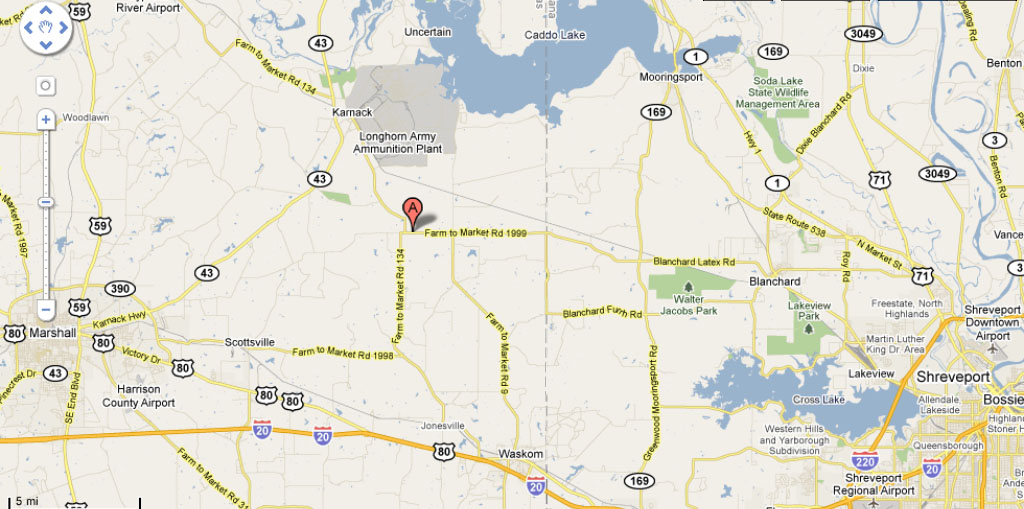
The teardrop-shaped, red "A" pointer above shows the location of Leigh, Texas. (This map was generated by www.maps.google.com .)
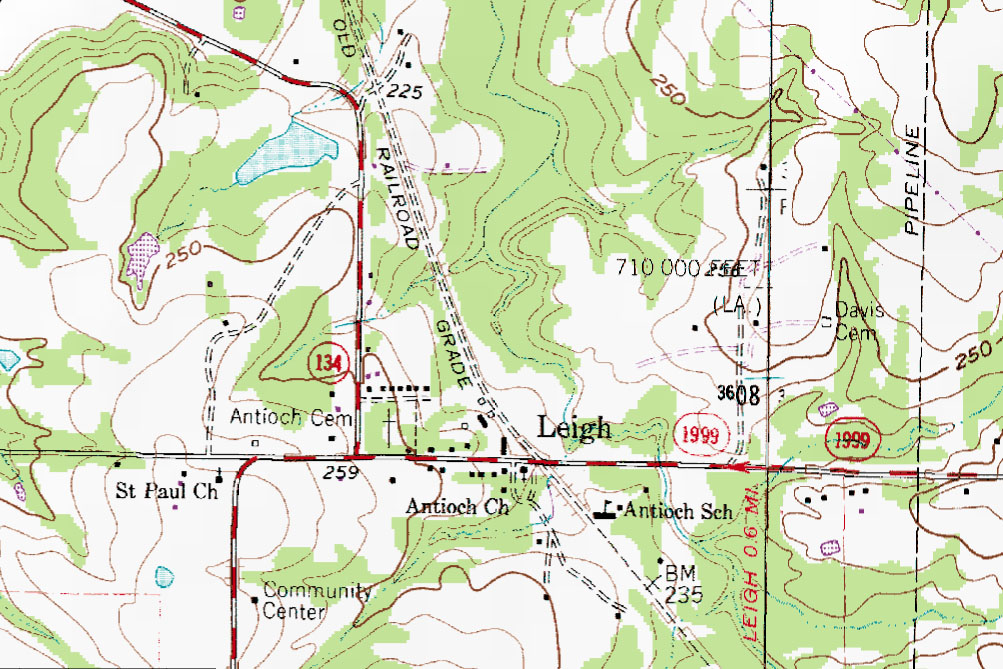
The map showing Leigh, Texas above is a detail from a USGS map.
Since the Ledbetter family lived in Harrison County when Lead Belly was growing up, the majority of Lead Belly's earliest gigs would have probably been in Harrison County, Texas, such as his regular documented gig in Leigh, Texas. These venues, including the saloon in or near Leigh, Texas, could have easily had pianos, and thus Lead Belly might have heard Boogie Woogie at these locations in Harrison County, even if these venues did not include the site where Lead Belly first heard Boogie Woogie in 1899. Moreover, Lead Belly might very well have heard Boogie Woogie after 1899 at one of the venues where he performed, but still prior to the time that he learned to play Boogie Woogie bass figures on his guitar by observing Boogie Woogie players at Fannin Street venues after having moved to Shreveport.
One thing is for certain: The Arklatex region was culturally unified and the state boundary was defined only by a line of longitude, not by a barrier such as a river. Regardless of where Lead Belly first heard Boogie Woogie in 1899, Boogie Woogie was almost certainly being played on both sides of the Texas-Louisiana state border at that time. Moreover, since there would have been multiple Boogie Woogie players in the Arklatex at the time, the specific site and specific musician from whom Lead Belly first heard Boogie Woogie in 1899 was not likely to have been the same musician or specific site where Lead Belly later stood by the piano to learn Boogie Woogie bass figures, which he then emulated on his 6-string guitar.
Lead Belly's Adaptation of Boogie Woogie Bass Figures from Piano to Guitar

Leadbelly was among the first to adapt the rolling bass of Boogie Woogie to a guitar. According to census records reviewed by Charles Wolfe and Kip Lornell, Lead Belly was born in 188825 (not 1889 as is printed on Lead Belly's gravestone) and died in 1949.
According to "The Story of Boogie Woogie: A Left Hand Like God,"9 by Peter J. Silvester, with a special contribution from Denis Harbinson,
"....between 1872 and 1876, the Texas & Pacific Railroad had been laying track to the west of Shreveport at Marshall and to the north of Shreveport at Texarkana. In this general area, or in Caddo County, or in Shreveport itself, is where the blues singer and guitarist, Huddie 'Leadbelly' Ledbetter, first heard barrelhouse pianists playing boogie-woogie walking basses in 189935 (or 1901, depending on source)."9
On page 17 in his chapter on Boogie Woogie in Just Jazz35, Ernest Borneman notes:
"About 1900, Leadbelly heard an old-time Louisiana pianist named 'Pine Top' (not Clarence 'Pine Top' Smith) playing Boogie on Fanning Street." (Borneman misspelled "Fannin" as "Fanning.") Leadbelly was so inspired by this piano playing that he imitated Pine Top's rhythmic piano style on his guitar.
Borneman quotes Leadbelly's comments about Fannin Street's Pine Top on page 17 of Just Jazz35:
"He played that Boogie Woogie. That's what I wanted to play on guitar -- that piano bass. I always wanted to play piano tunes. I got it out of the barrelhouses on Fannin Street."35
Note: The "Pine Top" to which Leadbelly refers was not Clarence
"Pine Top" Smith from Alabama who first used the word, "Boogie Woogie" in the
title of his Boogie Woogie sound recording. Clarence "Pine Top" Smith was not
born until June 11, 1904. The "Pine Top" to which Borneman is referring
could have been "Pine Top Williams." However, Borneman might very well have
been referring to still another "Pine Top," as there was at least one other
piano-playing musician in Shreveport named "Pine Top."
Specifically, on page 32 of his book, Louisiana Hayride: Radio and Roots
Music Along the Red River88,
Tracey E. W. Laird has written:
"Much of the music that existed in Shreveport brothels and bars came from
musicians like Pine Top Hill and Sycamore Slim, who played piano in the
style that came to be known as "barrelhouse." In barrelhouse style, the left
hand typically carried an emphatic bass beat while the right syncopated
improvised melodic strains alongside dissonant chords. The overall effect was a
rolling, rollicking sound that was of great formative influence on Leadbelly,
the legendary folk musician from the Shreveport area."88
And as Leadbelly has stated, "Boogie Woogie was called barrelhouse in those
days."87
Another "Pine Top" that Lead Belly might have encountered was Pine Top Burks of Texas. Burks was a member of the so-called Santa Fe Group of itinerant Texas pianists who played Boogie Woogie, and other styles as well. Burks was born until August 7, 190789, so it is virtually certain that Burks was not the first "Pine Top" who Lead Belly observed playing Boogie Woogie bass figures.
Leadbelly met fellow blues player, Blind Lemon Jefferson, in the Deep Ellum area of Dallas. For an uncertain period of time, they played together in Dallas. Deep Ellum developed as a Mecca for original music in Dallas as a direct consequence of being at the crossroads of the Texas & Pacific Railroad and the Houston & Texas Central Railroad. This crossroads was important to the development of blues music in Texas. Leadbelly relied on the Texas & Pacific Railroad to transport him to Dallas. Moreover, he has stated that he and Blind Lemon used the T&P to travel to locations where they would perform together. Specifically, on page 22 of the chapter, “Blind Lemon Jefferson: That Black Snake Moan: The Music and Mystery of Blind Lemon Jefferson,” in the book, "Bluesland: Portraits of Twelve Major American Blues Masters,"28 Alan Govenar wrote of Leadbelly’s recollections about Leadbelly’s and Blind Lemon’s travels on the Texas & Pacific Railroad: “Leadbelly remarked that they were often able to get free rides on the Texas & Pacific Railroad in exchange for their playing.”28
Leadbelly could be responsible for having taught Blind Lemon Jefferson to play a walking bass line on Jefferson's guitar. According to Sammy Price, Jefferson called his walking bass line his "booga-rooga."40
Lead Belly and Shreveport's Red Light District
Leadbelly has indicated that he heard early Boogie Woogie being played on Fannin Street in Shreveport. Fannin Street was in the red light district and in proximity to the Texas & Pacific Railroad Tracks. For example, when speaking of the existence of prostitution in Shreveport, Charles Wolfe and Kip Lornell write on page 30 in, "The Life and Legend of Leadbelly,"25
“This eventually bothered the city fathers, anxious to move Shreveport forward into the twentieth century and to dispel the image of their town as a collection of frontier saloons. In late 1902 the city council formed a committee to choose a section of the town to serve as a 'red light district for the habitation of women of immoral character.' They settled on an area west of downtown, away from the riverfront, in a triangle bordered by Fannin Street, Common Street, and the Texas and Pacific Railroad tracks.”25This section of the Texas & Pacifc tracks has been removed. However, the track road bed is still easily visible as of January of 2005.
Map of Shreveport's Red Light District
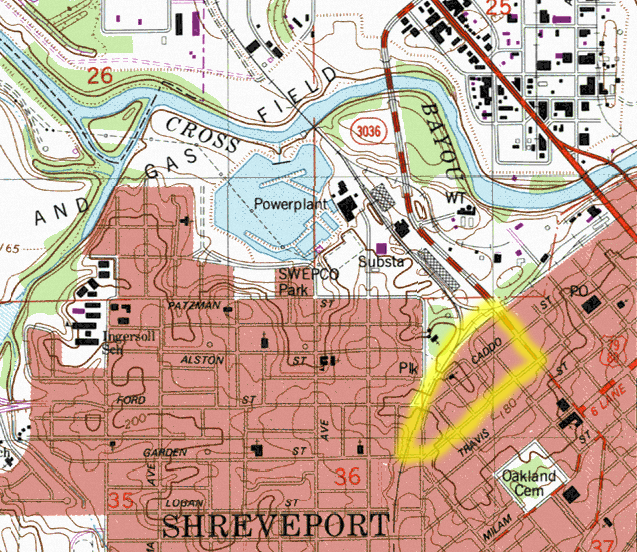
Yellow highlighting indicates the borders of Shreveport's officially recognized Red Light District. The Texas & Pacific tracks that form the northwest border of this approximate triangle are no longer present, but the path over which the track was once located is easily identifiable as of 2005. Although not labeled on the map above, Fannin Street is the street on the southeast border of the highlighted triangle above. Common Street forms the northeast border of the highlighted triangle. The tracks in the map above that lead away to the northwest were the T&P tracks that led to Texarkana's Red Light District. (Map Copyright 2005 by John Tennison)
The Texas & Pacific Railroad tracks connected the Red Light District of Shreveport to the Red Right District of Texarkana. The strong correlation between the Texas & Pacific Tracks and the Red Light Districts of each of these towns is striking and unmistakable. (See "The Prostitution Connection" below for a further discussion of Texarkana's Red Light District.
U. S. Highway 59 from Texarkana to Houston to El Campo - "The Boogie Woogie Highway"
(A.K.A. "The Boogie Woogie Corridor")
The Texas & Pacific tracks between Texarkana and Marshall are still in use by Union Pacific, and parallel Highway 59. South of Marshall, Highway 59 continues to Houston along the route of what was the Houston, East, and West Texas Railroad. This route takes Highway 59 through some of the most prominent lumber towns of the late 1800s (including Lufkin & Diboll) where various barrelhouse existed at the lumber camps. Moreover, lumber baron Arthur Temple (who controlled Diboll) lived in Texarkana and traveled back and forth between Texarkana and Diboll.) Moreover, George W. Thomas, Jr. brought Boogie Woogie to Houston.
From Houston, Highway 59 turns westward towards El Campo, Texas. As Highway 59 exits Harris County and enters Fort Bend County, it passes by Stafford, the birthplace of Boogie Woogie pianist, Robert Shaw (born 1908). Stafford is historically important because it was an initial west terminus of the very first railroad in Texas, The Buffalo Bayou, Brazos and Colorado Railroad. According to the Texas Handbook of History in George C. Werner's article on "Railroads":
"Work on this railroad began in 1851, and the first locomotive, named for Sherman [General Sidney Sherman], arrived in late 1852. The initial twenty-mile segment from Harrisburg (now a part of Houston) and Stafford's Point (now Stafford) opened by September 7, 1853. The Buffalo Bayou, Brazos and Colorado was not only the first railroad to operate in Texas, it was the second railroad west of the Mississippi River and the oldest component of the present Southern Pacific."47
Since slavery had not been abolished at the time the Buffalo Bayou, Brazos and Colorado Railroad was built, this earliest stretch of Texas railroad was built largely by slave labor. Moreover, prior to the end of the Civil War, slaves' access to pianos was limited. Consequently, piano music at slave-populated railroad camps associated with the construction of this track would have been limited, if present at all. However, the sound of the early steam locomotives on this line no doubt served as auditory inspiration for music that followed. Also, even as late as 1910, Fort Bend County had an African American population that rivaled that of Harrison County in Northeast Texas.
After traversing Fort Bend County, Highway 59 reaches El Campo, the birthplace of Boogie Woogie great, Little Willie Littlefield, who (along with Amos Milburn of Houston) had a profound influence on Fats Domino, Little Richard, and Jerry Lee Lewis. Moreover, El Campo is located in Wharton County, which, although not as high as Fort Bend County, has historically had one of the highest African American populations in Texas.
Thus, for all of these reasons, I call Highway 59 from Texarkana to Houston to El Campo "The Boogie Woogie Highway" or "The Boogie Woogie Corridor." It might make sense to include stretches of Highway 59 north of Texarkana or west of El Campo as part of "The Boogie Woogie Corridor." However, to do so, I would want to support such a designation by knowledge of Boogie Woogie players or sources of influence north of Texarkana or west of El Campo. For example, Lee Ree Sullivan of Texarkana reported to me in a1986 interview that his Boogie Woogie mentors had told him that Boogie Woogie was being played at logging and construction camps along the Texarkana and Northern Railroad (later known as the Kansas City Southern Railroad)68. The first 10 miles of the Texarkana and Northern were constructed in 1885, and run northward from Texarkana to the Red River along present-day Highway 59.
Moreover, since Robert Johnson and others made their first recordings in San Antonio, Texas, and since Louis Jordan was inspired by the Texas and Pacific Railroad presence in El Paso, Texas, I would not want to rule out possible Blues and Boogie Woogie influences on Highway 59 west of El Campo. However, in general, one can visualize a "Boogie Woogie and Blues Gradient" that becomes more intense as one travels from West to East Texas. (The fact that parts of U. S. Highway 59 are going to become the new Interstate Highway 69 is a fitting metaphor for the libidinal energy associated with Boogie Woogie.)
The Earliest Sound Recording Containing a Boogie Woogie Bass Figure
The earliest audio recording of which I know that contained an unequivocal Boogie Woogie bass figure is the recording of the "Weary Blues" by Artie Matthews, as performed by the "Louisiana Five" in December of 1919 in New York City. According to page 1059 of "Jazz and Ragtime Records (1897-1942)" by Brian Rust91, the Louisiana Five recorded two takes of the "Weary Blues" for the Emerson label, with ID numbers being Emerson 10116 4738-1, and Emerson 10116 4738-2. I presume these recordings were made on the same day, but obviously, one of the recordings was made first. Consequently, if the recording with the ID ending in "1" was made first, then technically, it would be the "first" recording with a Boogie Woogie bass figure of which I am aware.
The piano in these recordings is presumably being played by Joe Cawley, who was the pianist for The Louisiana Five. These recordings can be heard online at the Red Hot Jazz Archive. Although the sound of the piano is somewhat buried in the mix of these recordings, the Boogie Woogie bass figure known both as "The Texas & Pacific" bass and "The Cows" can be clearly heard in the recordings, and appears to be the same Boogie Woogie bass figure that was published in the 1915 sheet music, "Weary Blues," by Artie Matthews.
Other Early Sound Recordings Containing Boogie Woogie Bass Figures
"The Rocks" by George & Hersal Thomas (recorded February, 1923) and "The Fives," (performed by Joseph Samuel's Tampa Blue Jazz Band) and also written by George & Hersal Thomas (and also recorded February, 1923) contain Boogie Woogie bass figures. Moreover, Fletcher Henderson's recording of "Chime Blues" on Black Swan Records was recorded at a similar time (circa March,1923) and also contains a Boogie Woogie bass figure.
Thus, the February 1923 recordings of "The Rocks" and "The Fives" should be regarded as a chronological tie for their use of a Boogie Woogie bass figure.
The first sound recording of which I know of George W. Thomas's "New Orleans Hop Scop Blues" was also made in 1923 on OKeh Records.
The February 1923 recording of "The Rocks" lists "Clay Custer" as the piano player. While this person is commonly regarded as having been George Thomas, Jr., this conclusion is still uncertain. Although some have written that "Custer" was the maiden name of George Thomas's mother, "Blues and Gospel Records: 1890-1943"92 disputes this claim, stating that Custer was not George's mother's maiden name.
Okeh Records - The Record Label that Recorded George Thomas's "New Orleans Hop Scop Blues" & George and Hersal Thomas's "The Rocks"
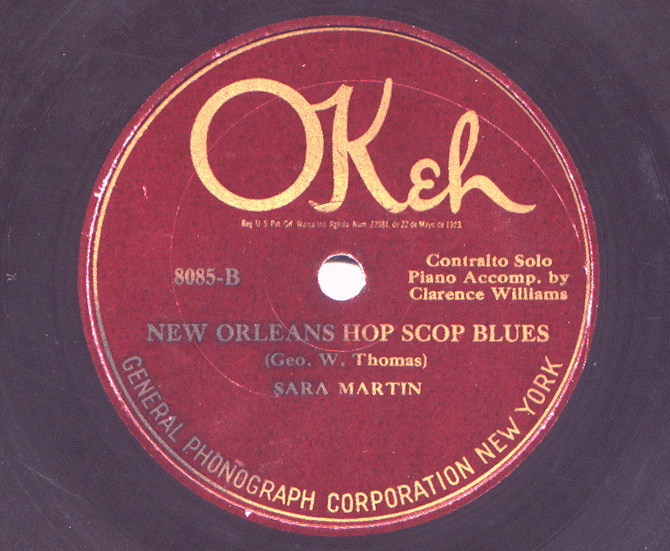
(Scanned from John Tennison's Early Phonographs Collection)
Fletcher Henderson's "Chime Blues" is an Early Boogie Woogie Recording

According to one website (http://www.redhotjazz.com/fletcher.html) Henderson's "Chime Blues" was recorded in "January of 1921" on Black Swan Records. However, according to historical accounts, Black Swan Records did not make its first recordings until April, 1921. Moreover, these historical accounts indicate that the first recordings of Black Swan Records did not include Fletcher Henderson's "Chime Blues." Moreover, the most authoritative document on the history of Fletcher Henderson and his music ("Hendersonia", Jazz Monographs Number 4, 1973, Walter C. Allen) indicates that he recorded "Chime Blues" in "early 1923." On Page 44, Hendersonia states"
"In early 1923, Fletcher Henderson recorded a pair of piano solos for Black Swan, which were issued on their rare 2100 series. Chime Blues features a walking bass, and although Henderson was never known as a boogie-woogie pianist, this must be one of the earliest such solos on record (with the possible exception of the mysterious Clay Custer's [A.K.A. George Thomas] 'The Rocks' on OKeh 4809, recorded about this same time). It would be interesting to know where Henderson picked up this style!"
Moreover, on page 548, Hendersonia states, "....one of the earliest known examples of boogie-woogie bass takes place on Fletcher's rare piano solo of Chime Blues."
Bryan Rust's authoritative three-volume set titled, "JAZZ AND RAGTIME RECORDS (1897-1942)," Malcolm Shaw, editor, indicates "circa March 1923" as the recording date for Henderson's "Chime Blues." Thus, this authoritative sources places the recording of "Chime Blues" in the month following the recording of "The Rocks," not in 1921 as the Red Hot Jazz website had indicated. Of course, the word, "circa," allows for wiggle room, in that it represents an approximation. Regardless of the dates of audio recordings, an indisputable fact is that Henderson's circa March 1923 recording of "Chime Blues" occurred about 8 years after Artie Matthews' 1915 sheet-music publication of "The Weary Blues, " and about 7 years after the 1916 sheet-music publication of George W. Thomas's "New Orleans Hop Scop Blues."
Regardless of exact recording dates, both "The Rocks" and "Chime Blues" deserve recognition as being among the first audio recordings to use Boogie Woogie broken-octave walking bass lines containing an intrinsic swing-pulse in the left hand part. Moreover, these broken-octave, swung bass lines are qualitatively distinct from the duple-meter feel of the broken-octave bass lines in Joplin's "Pine Apple Rag" and in Boone's "Southern Rag Medley 2."
Since Henderson was a demonstrator of the African American sheet music of his day, Henderson could easily have picked up the idea for the Boogie Woogie swinging broken-octave walking bass line either from this previously published sheet music of Artie Matthews or George Thomas, or by rushing out to emulate the bass line in "The Rocks" shortly after hearing the studio performance or recording of "The Rocks," as recorded in February of 1923. However, since George Thomas notated the swing pulse of his 1916 music with grace notes rather than with eighth-note triplets or doted eighth-notes, it seems more likely that Henderson would have modeled a witnessed performance by someone who was playing with an swing-pulse intrinsic to the left hand. Else Henderson could have ended up with an interpretation that sounded more like Eubie Blake's grace-noted (AKA "reverse Boogie Woogie") broken octave bassline as Blake used in his 1917 piano roll recording of Blake's "Charleston Rag."
Another feature that suggests that Henderson was emulating either "The Weary Blues" or "New Orleans Hop Scop Blues" comes from comes from the fact that "Chime Blues" clearly copies the structure of "The Weary Blues" and "New Orleans Hop Scop Blues." Specifically, "Chime Blues" begins with a Ragtime oom-pah pulse, transitions into a Boogie Woogie swinging broken-octave walking bass, and then returns to a Ragtime oom-pah pulse, making the resemblance of "Chime Blues" to the structure of "The Weary Blues" and "New Orleans Hop Scop Blues" unmistakable.
Also, both "The Rocks" and "Chime Blues" have rudimentary polyrhythmic interplay between the right and left hands. Both "Chime Blues" and "The Rocks" pre-date Meade Lux Lewis's "Honky Tonk Train" and Clarence "Pine-Top" Smiths "Boogie Woogie" recordings.
If you are curious to hear "Chime Blues," go to http://www.redhotjazz.com/fletcher.html. (I cannot guarantee that this link will always be active.)
Black Swan Records - The Record Label that Recorded Fletcher Henderson's "Chime Blues"
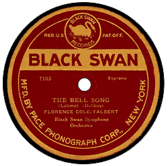
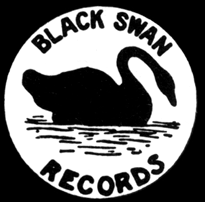

Black Swan Records was the first back-owned record label. The label was founded by Harry Pace, who was from Georgia. Before moving to New York to start his record label, Pace had run a music publishing company in Memphis with W. C. Handy. Fletcher Henderson had worked as a pianist and demonstrator for Handy and Pace's publishing company. Thus, Henderson's exposure to the published African American music of the day would have almost certainly brought Henderson into contact with Artie Matthews' 1915 sheet music for "The Weary Blues" and with George W. Thomas Jr.'s 1916 sheet music for "New Orleans Hop Scop Blues." This experience would have exposed Fletcher Henderson to the use of the Boogie Woogie broken-octave walking bass line approximately 8 years before Henderson recorded his "Chime Blues" circa March, 1923 on Swan Records. Thus, the distribution of sheet music to Memphis, Chicago, and New York is a plausible explanation for how Fletcher Henderson came to use such a bass figure in his "Chime Blues."
Jimmy Blythe's "Chicago Stomp:" The First "Completely Boogie Woogie" Recording
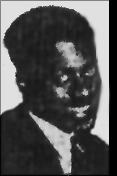
Unlike other early recordings of Boogie Woogie, Blythe's "Chicago Stomp" is significant in that, after its short introduction, it maintains a Boogie Woogie feel and pulse to the end with no intermittent use of the 2/4 oom-pah pulse heard throughout most Ragtime music. Interestingly, unlike many other Ragtime pieces (such as Eubie Blake's "Charleston Rag"), Jimmy Blythe's piano teacher, Clarence M. Jones played his "Daddy Blues" and his "Doggone Blues" with a distinctive swing pulse that could have influenced Blythe to impart more of a swing to Blythe's own music. Blythe recorded "Chicago Stomp" in April of 1924 in Chicago, Illinois, on the Paramount Label, #12207. Blythe's "Chicago Stomp" can be regarded as an important contribution to the maturation of Boogie Woogie that occurred in Chicago well before Meade Lux Lews or Pine Top Smith made their recordings, and well before Boogie Woogie became publicly associated with Lewis, Smith, Ammons, Johnson, and Yancey.
The First Recording to Use a 12-Bar Blues Harmonic Progression with a Boogie Woogie Bass Figures
In addition to using Boogie-Woogie bass figures with some degree of inherent swing, George W. Thomas Jr.'s "The Rocks," recorded in February 1923, is said to be the first Boogie Woogie recording to employ a 12-bar blues structure.
Eubie Blake is Not a Reliable Historian and His Claims about Boogie Woogie are Unbelievable.
Historian Peter Hanley (See Hanley's excellent web article) discovered in 2003 that Eubie Blake had been untruthful about his age.36 Documents uncovered by Hanley in 2003 revealed that Blake was born on February 7, 1887, not in 1883 as Blake had claimed.36 Hanley's solid evidence as well as the evidence and reasoning in my discussion below bolster the position that Blake was not a reliable historian and that Blake's claims about Boogie Woogie are unbelievable.
Despite the early contributions of George W. Thomas, Jr. to bringing Boogie Woogie out of East Texas5, ragtime pianist Eubie Blake alleged that a Ragtime pianist named "William Turk" was playing "Boogie Woogie" in Baltimore in 1896. Although it is theoretically possible that a Ragtime pianist in Baltimore could have developed Boogie Woogie independently of the barrelhouse origin in East Texas corroborated by multiple sources, Eubie Blake's claim flies in the face of the preponderance of evidence, and thus, deserves our skepticism. The relative geographic discontinuity of Baltimore, MD with the other accounts of the location of early performances of Boogie Woogie is reason to be suspicious. In particular, Blake's claim is geographically inconsistent with the preponderance of evidence that points towards an East Texas origin for Boogie Woogie. Moreover, and perhaps most suspicious, is that there appears to be no witness other than Eubie Blake who recalls having known or heard of a man named "William Turk." Moreover, Blake's recollection of "William Turk" didn't occur until 54 years after Blake claims to have heard "Turk." These are the earliest comments that I know of by Blake about "William Turk." Blake's comments appear in "They All Played Ragtime,"8 a book on the history of Ragtime published in 1950 by Rudi Blesh and Harriet Janis. Based on Peter Hanley's evidence, Blake would have been 63 years old at this time. This book is known to have other questionable claims, such as claiming that Scott Joplin was born in Texarkana, when in fact, the exact birthplace of Scott Joplin is unknown. The earliest reference to a "William Turk" that I have found point back to this 1950 book by Blesh and Janis.8 A later reference to "William Turk" can be found in the liner notes of the 1969 Columbia LP album, “The Eighty-Six Years of Eubie Blake.”26
(If anyone knows of any other primary references to or information about William Turk, I would love to hear from them at nonjohn@nonjohn.com.)
In a 1970 interview (on file at Michigan State University Voice Library) with Max Morath, Eubie Blake stated the following:
Blake: "I played . . . I have never changed my style of playing in my life, see."
Morath: "Oh now, come on, because you've studied music ever since 1900."
Blake: "All right but, but when I play
ragtime I have never changed my style. You know people say, "Today, you
take . . .The pianist today . . . you say, who's that playing? You can't tell
because they all play alike. Whoever makes a big hit, then the guy follows that
guy, see."
Morath: "Mmhmm."
Blake: "I'll play like him, see? So they have no style, very few have a style of their own. Now I've been playing . . . look. Look now, the "Charleston Rag," you take the "Charleston Rag."
[Could Blake's saying, "I'll play like him, see?" have been a Freudian slip? That is, does Blake know at some level know that it is he who is playing like someone else to whom he has not given credit? Moreover, Blake's comment of that "Whoever makes a big hit, then the guy follows that guy, see" is interesting in that in the previous year of 1969, Blake had released his "Eubie's Boogie," clearly following the success of Boogie Woogie and Rock & Roll that, by then, had easily eclipsed the popularity of Ragtime. Psychiatrically speaking, Blake appears to be "projecting." Shakespeare's "The lady doth protest too much" comes to mind. That is, why would Blake be so invested in convincing the skeptical Morath that Blake's style has not changed? Moreover, was Blake's using the word "see" at the end of so many of his sentences consistent with the way people from Baltimore talked in Blake's generation? When, I hear Blake's use of "see" at the end of some of his sentences, I cannot help but think of comedic gangster characters in sketch comedies and the movies who say something like, "That's the ticket, see?" as they are telling a lie. Who knows, maybe people in Baltimore once really used "see?" at the end of their sentences. It should not be too hard to determine if "see?" occurs frequently at the end of sentences in people from Baltimore in Blake's generation. If not, then the occurrence of "see?" at the end of Blake's sentences could be an indicator of deception, of making it up as he went.]
Blake then closes by saying: "Ladies and Gentlemen, that's Ragtime!"
Max Morath was obviously skeptical of the claim that Blake's style had not changed, yet, probably out of respect, Morath did not press the issue with Blake. Yet, Blake had released his "Eubie's Boogie" in the album, “The Eighty-Six Years of Eubie Blake,”26 in 1969, many years after Boogie Woogie had been assimilated into popular culture. The style of "Eubie's Boogie" (Track 5 on Side 1 of 'The Eighty-Six Years of Eubie Blake'26) was different from the Ragtime that Blake had been known to have played before. Moreover, Blake (to my knowledge) had never recorded a piece with the word "Boogie" in the title before. Thus, there is evidence that Blake had changed his style.
A very suggestive photograph from 1977 appears in the autobiography of Sammy Price, "What do They Want?"40 In this photograph, Sammy Price has been crowned the "King of Boogie Woogie." Sammy, wearing a robe and crown, is being honored with a large cake in front of him. To Sammy's right is Eubie Blake looking away from Sammy Price with a disgusted look on his face. To Eubie's right, and appropriate to the occasion, Monty Irvine is smiling and looking toward Sammy Price and the large cake. Could Eubie Blake be reliving the same upstaging that he had previously experienced when Boogie Woogie became more popular as the popularity of Ragtime had declined?
Another way that Eubie Blake brings his credibility into question is by claiming in 1969 (in his spoken words during the performance of "Charleston Rag" on the album, "The Eighty-Six Years of Eubie Blake"26 that he composed the "Charleston Rag" in 1899. In the spoken words of this album, Blake indicates that he did not write it down because he did not start writing music until he was 15 years old. Yet, based on his claimed year of birth (1883 - now known to be false) he would have been 15 years old in 1998, the YEAR BEFORE he says he composed "Charleston Rag!" Thus, he contradicts himself! Moreover, his claim of not knowing how to write music until he was 15 years old calls into question his claim (at age 9 in 1896 - based on Hanley's evidence) of having knowledge that William Turk could play in every key. IF Blake knew how to write music in 1898, as he claims, then why did it take him 19 years to write down what is perhaps his signature rag, "The Charleston Rag." Isn't it a bit suspicious that the walking bass line of the Charleston Rag sounds like a literal reading of the grace-note notation (not suggesting a swing pulse) for what was actually meant to be a swinging, broken-octave walking bass line of George Thomas's sheet music for "New Orleans Hop Scop Blues?" This is analogous to when someone plays straight eighth notes for notes that those "in the know" knew were supposed to be swung, or in some other way that was not a literal reading of the notation.
Also, in the spoken words of Blake's 1969 album26, Blake refers to another contemporary piano player as having been a "competitor." Blake's use of the word, "competitor" reveals that Blake was in competition with at least this pianist, and likely others. Such competition could easily form the basis to take credit or exaggerate Blake's own contributions.
Eubie Blake Coins the Expression, "A Left Hand Like God"
Blake's claims about William Turk are suspect. Specifically, a close analysis of Blake's comments indicate that whatever Turk was playing was not "Boogie Woogie" as we know it. This conclusion results from a careful analysis of Blake's comments about Turk. Specifically, Blake is quoted in "They All Played Ragtime" as saying the following about "William Turk":
"He had a left hand like God. He didn't even know what key he was playing in, but he played them all. He would play the ragtime stride bass, but it bothered him because his stomach got in the way of his arm, so he used a walking bass instead. I can remember when I was thirteen--this was 1896--how Turk would play one note with his right hand and at the same time four with his left. We called it 'sixteen'--they call it boogie-woogie now."8
Besides Blake's quotation in
"They All Played Ragtime,"8
the only other mention of William (Will) Turk of which I know comes from the
liner notes of
“The
Eighty-Six Years of Eubie Blake,”26
by Robert E. Kimball of Yale University, who writes:
As a physician familiar with the anatomy and function of the human body, I find it hard to believe that Turk (said to be over 300 pounds8) was so fat that his stomach prevented him from playing a stride bass or not swinging. I have not yet surveyed a significant number of markedly obese piano players to confirm this, but consideration of a few examples is persuasive. When someone extends their arms, they can put considerable distance between themselves and their "stomach." To think that Turk's stomach protruded so much that he could not play stride bass is hard to believe. Despite their weight, Fats Waller and Oscar Peterson were able to play stride bass figures extremely well. Moreover, Meade Lux Lewis, who was very rotund, at only 5 foot, 2 inches tall and up to 300 pounds, played both stride and Boogie Woogie bass figures. Surely there are numerous other examples of obese piano players who have had no problem playing stride bass.
When referring to the keys in which Turk was able to play, what does Blake mean by saying that Turk "played them all?"8 Of course, any skilled pianist can play at least something in every key. Yet, given that the unschooled ragtime pianists (like most unschooled pianists) tended to prefer certain keys over others, how is it that Turk would have demonstrated playing in all keys to Blake, who was 13 years old at the time? Obviously, such ability is possible, but Blake's comments could also have been a superlative romanticization of Turk.
With regard to whether Turk was playing Boogie Woogie or not, we must remember that Turk was said to weigh over 300 pounds. If Turk was uncomfortable playing 'ragtime stride bass,' (generally defined as an oom-pah bass with the "oom" being a single note or octave with the "pah" being a chord above it) as Blake indicated, then Turk would have been uncomfortable playing any other bass line that occupied a similar width of the keyboard. Consequently, unless Turk was lowering his left hand part by an octave, Turk was likely not playing a shuffled-octave walking bass line that involved a width of two octaves. If Turk was able to play an octave lower than the stride bass would have normally been played, then we must wonder why he didn't simply play the stride bass in that register. One reason could be that the chords on the "pah" of the "oom-pah" would sound rather muddy in that register. Consequently, a monophonic walking bass line would have would have been more intelligible in the lowest end of the keyboard. Yet, even if we assume that Turk was playing "a walking bass" that occupied a two-octave width, Blake's comments reveal that Turk could not have been playing Boogie Woogie as we know it. Specifically, Blake alleges that Turk "would play one note with his right hand and at the same time four with his left." If we assume that Turk's "walking bass" was monophonic instead of being a 4-note chord played against 1 note in the right hand, such an assumption would mean that, for every four notes that went by in the left hand, Turk only played 1 note with his right hand. Thus for each cycle of 16 left-hand notes in Turks "walking bass," he would have only have played 4 notes in his right hand. Such a limited number of notes in the right hand could not possibly have produced the rhythmic complexity in the right hand or the polyrhythmic interplay between right and left hands that is much of the essence of Boogie Woogie.
Consequently, even if Turk did have a "left hand like God," Blake's comments indicate that Turk's right hand was very elementary, not very impressive, and did not resemble the complex right-handed parts that define Boogie Woogie. Nonetheless, Blake's phrase, "A left hand like God" has persisted to this day and underscores the "juggernaut" of a left hand that all Boogie Woogie players must have to play Boogie Woogie well. Of course, it is best to have both a right AND left hand like God!
Moreover, IF Blake, at age 9 (based on Hanley's evidence), observed Turk in 1996 when Blake said Turk was too obese (over 300 lbs.8) to play stride bass, and IF Turk "was thin when Eubie first knew him,"26 over what span of time does Blake expect us to believe that Turk went from being "thin" to over 300 lbs? Normally, such a change in weight does not take place over the span of just a few years. Moreover, human memory for factual events is frequently inaccurate for "memories" under 4 years of age. So, it seems that Blake's claims would require us to believe that he met Turk when Blake was between ages 4 and 9, and that in this 5 year span of time, Turk underwent an amazing weight gain from being "thin" to over 300 lbs. Such a weight change is possible, but highly unlikely. Moreover, Blake would have had to have met Turk when Blake was pre-pubescent boy, and thus not very likely to be in brothels or the kinds of places where Blake could have closely scrutinized a "thin" Turk playing "stride" Ragtime music, a music that was largely forbidden in places other than brothels, including homes and churches. For example, considering the following excerpt from 1970 interview with Eubie Blake and Max Morath:
Blake: "So one day I was playing my mother'd gone out to work, see and what she was doing home that time in the morning, I don't know. She came in, says and heard me playing:
'Take that ragtime out of my house!' That's the first time I ever heard the word
'ragtime.' And she made me; she made me stop."
Morath: "She really made you stop."
Blake: "Yes, wouldn't let me play."
Morath: "Well, why did she . . . ? I mean why did she think it was . . .?"
Blake: "Because ragtime was supposed . . . See it was out of the houses of ill repute, or bordellos, I guess that's a better word, and it was low, low, low. It was considered low music, see. It wasn't, it wasn't art, see."
Morath: "You think it was simply because it was played in this sporting district . . . "
Blake: "In the sporting district . . ."
Morath: "Or because they thought there was something wrong with the music itself?"
Blake: "No, not the music, because from whence it came. See?"
This interview excerpt above suggests that it would have been difficult for Blake to have been exposed to strided-bass Ragtime of the sort Blake says Turk was playing when Turk was "thin." That is, assuming Turk really did go from being "thin" to being over 300 lbs, Blake would be been 9 years old or younger, and not a likely candidate to be hanging out in the whore house, especially in such close visual and auditory proximity that he could have known that Turk was playing in every key. And I hope that someone can tell me anything more they might know about the early life of Eubie Blake that might help clarify these matters. (Email: nonjohn@nonjohn.com.)
In the 1970 interview with Max Morath, Blake indicates that he first started playing Ragtime in brothels "around nineteen hundred." Specifically, Blake says:
"Now you see when I first start to play in these houses, see, it must have been around nineteen hundred."
If this is true, and since he was born in 1887, Blake would have turned 13 years old that same year (1900). Yet Blake says he heard the obese William Turk playing a walking bass in 1896 (when Blake was 9 years old). And in the liner notes to his 1969 album, Blake is described as having met Turk when Turk was "thin" and still able to play a Ragtime stride bass. Given Blake's claim of Turk's weight change from "thin" to over 300 lbs., Blake would have to have met Turk at least a few years before Blake was age 9. Unless children were allowed in Baltimore brothels, such witnessing of Turk by Blake at ages of 9 and under would have seemingly been difficult to come by. Thus, for these reasons and as a result of my analysis of Blake's description of Turk's playing, Blake's account of Turk is highly suspicious.
Blake's descriptions of Turk's left hand bass figures might be a deliberate attempt at deception by Blake. Perhaps Blake was intentionally attempting to deny giving credit for the broken-octave walking bass line to George W. Thomas, someone Blake would have likely considered as a "competitor," a word Blake himself used in his 1969 album to describe another pianist. Moreover, creating an account of Turk that no one else seems to have witnessed or can corroborate would be harder to refute. Indeed, if not for the geographical discontinuity of Blake's account of Turk's Boogie Woogie with that of other early accounts of Boogie Woogie performances, there might have never been a reason to be suspicious of Blake's claims. But given Blake's contradictions of himself, unusual use of "see" at the end of his sentences, and his 1917 piano roll performance of "Charleston Rag" that sounds like an imitation of Thomas's 1916 sheet music, the possibility of intentional deception on Blake's part is a plausible explanation.
In summary, based on the analysis above, I believe that Blake's claims about Boogie Woogie and walking bass lines are unbelievable. Moreover, what Blake says Turk was playing did not meet the threshold of what historians should regard as Boogie Woogie. However, I invite skepticism of my analysis from anyone and encourage them to contact me at nonjohn@nonjohn.com.
(Note: In addition to my claims, some historians might argue that Turk's music would also need to be in a 12-bar blues form to qualify for being Boogie Woogie. However, I would argue that we should not limit the definition of Boogie Woogie to include only 12-bar forms. For example, one can play in many harmonic progressions involving the I, IV, and V that are not 12 bars, while still having the feel of Boogie Woogie.)
Four Boogie Woogie Pianists & One Blues Guitarist Die Young After Moving Northward to Chicago
It is fascinating that at least five early musicians to bring Boogie Woogie and blues to Chicago died from unnatural causes at a young age. The four Boogie Woogie players were George W. Thomas, Jr., Hersal Thomas (George's younger brother), and Clarence "Pine Top" Smith, and James "Jimmy" Blythe. I have no evidence that any of these four individuals died from pre-meditated murder. However, potential motives do exist. For example, Albert Ammons has mentioned that Hersal Thomas's piano playing intimidated other Chicago pianists to the degree that they were afraid to play after Hersal had played. Moreover, Ammons mentioned that, as a result, Hersal got all the women. Indeed, competition for women, as in Helen of Troy, should never be underestimated as a potential incentive for aggression, and even murder.
A discussion of the details of the deaths of the Five musicians is as follows:
Ryan Hertz, an ethnomusicologist with The American Music Research Foundation in Detroit tells me in an email that Sippie Wallace (George Thomas's sister) told her manager, Ron Harwood, that George W. Thomas "was running after a departing street car in the winter and slipped on the ice while reaching for the grab bar and broke his back. While recovering at home, there was a fire and he fell while trying to make it down the stairs and died in the hospital." According to Ryan Hertz, Sippie Wallace did not specify whether George Thomas died from this final fall, from being burned, or both. As far as I know, It is not clear how the fire started.
At only 20 years old, Hersal Thomas died mysteriously from food poisoning in 1926 in Detroit, indicating a low probability that anyone in Chicago was responsible. However, there was at east one other musician, Charlie Spand, who was known to have spent time with Hersal, and who was known for playing Boogie Woogie in both Chicago and Detroit. Given the competitiveness of Hersal (as documented by Sammy Price), it is not all hard to imagine that Spand could have been upstaged by Hersal at a Detroit venue. According to Ryan Hertz, Sippie Wallace told Ron Harwood that Hersal died "likely of food poisoning thanks to a can of pork and beans." I wonder: Did someone intentionally serve these pork and beans to Hersal? How common was it to die from this cause? (Interestingly, some have theorized that blues guitarist Robert Johnson died from poisoning that might have been related to conflicts over women.)
Clarence "Pine Top" Smith was said to have been accidentally shot by witnesses at the trial following Pine Top's death (see article by Sharon Pease, Down Beat, October 1, 1939). William Russell's account in Jazzmen1 indicates that Pine Top Smith "was shot down in a brawl over 'some ol' gal in a cheap West Side dance hall,' according to Mayo Williams. [according to witnesses, Pine Top was not a party to the brawl, but had been pushed toward the two brawling persons by the woman with whom Pine Top was dancing.] And Pine Top died as he had lived. Probably the most erratic and flighty character of Chicago's jazzmen, he kept everyone guessing what he would do next. He slept all day, wandered from one club to another all night, and was apt to drive up to a friend's house at 5:00 A.M. in a taxi, and get the friend out of bed to pay his fare. Like Yancey, Pine Top had traveled the Theatrical Owners' Booking Agency circuit as a tap dancer in vaudeville. He was one of Maddy Dorsey's pickaninnies. When he outgrew the part, he settled in Chicago in the early twenties. Even then he didn't stay put and, at certain periods, was a well-known figure around the red-light districts of Omaha and St. Louis." (In contrast to Russell's account, Sharon Pease learned directly from Sarah Smith that she and Pine Top Smith did not move to Chicago until 1928.) In fact in his story from the October 15, 1939 issue of Down Beat, Sharon Pease indicates that Pine Top was involved with and had a daughter with a woman other than Pine Top's wife, Sarah Smith. Sarah indicates to Sharon Pease that she did not find out about this infidelity until after Pine Top had died. Moreover, on the night of Pine Top's shooting, he was at a party dancing with a woman other than his wife. Clearly, Pease's and Russell's description of Pine Top Smith reveal a character that could easily have resulted in violent disputes over women.
According to http://www.redhotjazz.com/Blythe.html, Jimmy Blythe - (b. 1901, d. 1931) "died suddenly of epidemic meningitis in 1931." According to Peter Silvester, Blythe "took up residence" in Chicago in 1916 (page 15)9. Questions remain here, also. Was there a widespread epidemic? Or was Jimmy's case more isolated, and thus, possibly more suspicious? (For example, people can get meningitis from poisoning.)
According to Robert Uzzel in Chapter 5, page 45, in his book, "Blind Lemon Jefferson: His Life, His Death, and His Legacy,"22
“Blind Lemon Jefferson’s life and career came to an abrupt end in December 1929. Details regarding his death are uncertain, although most accounts agree that he died on the streets of Chicago. At that time, he was still employed by Paramount and singing at a lot of parties on the South Side of Chicago. According to reports from Paramount staff received by John Steiner, the Chicago jazz historian who bought the Paramount property in the 1940s, Lemon left the studios late in the afternoon to play for a house party and was found dead on the street early the next morning, with snow drifting over his body.”
According to Robert Uzzel, "The exact date of his death is unknown. There was no death certificate found at the Cook County Courthouse in Chicago when a search was made in 1967."22 In the Book, "Tolbert's Texas"23 by Frank X. Tolbert, Blind Lemon's friend and Texan blues singer, Mance Lipscomb, stated (page 24):
and (page 25)
"But the way I heard it, Blind Lemon had just been paid off a lot of money in cash by two big record companies and he wanted to go to the depot there in Chicago and catch a train home. Being a blind man he needed someone to guide him to the depot. Whoever started out guiding him didn't finish the job. Anyway somebody knocked him in the head and took his poke with all that record money in it and left my friend on the cold, cold street to freeze to death."23
In light of such a climate as described by Lipscomb, it would not be surprising if the circumstances surrounding the death of George Thomas, Hersal Thomas, Jimmy Blythe, and Clarence "Pine Top" Smith had also been distorted, obscured, or even lost altogether. At least in Pine Top Smith's case, there was a trial after his death. Sippie's Wallace's interview with Ron Harwood sheds some light on the death of George and Hersal Thomas, but does not rule out the possibility of foul play.
Like the George and Hersal Thomas, Blind Lemon Jefferson had migrated from Texas to Chicago. Blind Lemon had been discovered playing by the Texas & Pacific & Houston & Texas Central Tracks in the Deep Ellum area of Dallas by a talent scout for Paramount Records. Although he is generally not regarded as a "Boogie Woogie" artist, Blind Lemon Jefferson was important in the history of Boogie Woogie in that he was using the term "Booger Rooger" in the title of his "Booger Rooger Blues" no later than 1917-1820. Blind Lemon recorded this piece in 1926 in Chicago, two years before Pine Top Smith became the first to use the term "Boogie Woogie" in the title of a Boogie Woogie sound recording. Moreover, Sammy Price indicates that Blind Lemon Jefferson used the term "booga-rooga" to refer to bass figures that Jefferson played on his guitar, and which Price said were the same bass figures that Clarence "Pine Top" Smith later used in his 1928 Vocalion piano recording, "Pine Top's Boogie Woogie." (page 30)40
The untimely death of these five music pioneers who migrated from the south to Chicago is noteworthy for the following reasons:
1. At least three of the four Boogie Woogie players who died knew each other and played in the same house-party circuit. Jimmy Blythe and Blind Lemon likely played in the same house-party circuit.
2. At least three of the four Boogie Woogie players who died were known by name by other aspiring Boogie Woogie players, such as Albert Ammons, Meade "Lux" Lewis, and others. (Jimmy Blythe was almost certainly well known also.)
3. All five of those who died had migrated to Chicago from elsewhere: Three from Texas (George Thomas, Hersal Thomas, & Blind Lemon Jefferson), one from Alabama (Clarence "Pine Top" Smith), and one from Kentucky (Jimmy Blythe). Thus, all five could have been seen as threatening outsiders and competitors. However, since Hersal's death occurred in Detroit, it seems improbably that someone from Chicago had a causal role. However, to the extent that Hersal intimidated the other piano players and impressed the girls in Chicago, he probably had the same effect in Detroit.
4. All five died from unnatural and/or mysterious causes at a young age. So whether foul play was involved or not, at the very least, it must be acknowledged that a string of unfortunate events killed off some of the most important of the early Boogie Woogie players. Other than coincidence, another possible explanation for their untimely deaths is that whatever causes someone to be a good Boogie Woogie player also causes them to seek novelty and take other risks (including but not limited to competition for women) that might predispose them to dangerous situations with potentially deadly outcomes. For example, to the extent that Boogie Woogie was associated with sexual behavior, some piano players in brothels might contract sexually transmitted diseases. For example, Scott Joplin contracted syphilis, most likely in a brothel where he played Ragtime. Fortunately, these days, it is possible to have safe sex, and still play Boogie Woogie!
Could there have been motives or pre-meditation involved in causing the untimely deaths of George, Hersal, Jimmy, Pine Top, or Blind Lemon? Perhaps jealously and/or competition between men and/or women had some role in the untimely deaths of these early musicians who came to Chicago from elsewhere. However, given the number of witnesses at the trial following Pine Top's death, it seems unlikely that Pine Top's death resulted from a pre-meditated conspiracy. Yet, it is ironic that Ammons reported that Pine Top wanted Ammons to learn to play Pine Top's Boogie Woogie shortly before Pine Top was shot. Since Boogie Woogie players were often very competitive, and since demonstrating Boogie Woogie prowess often had a role in competing for women, it is noteworthy that Ammons alleged that Pine Top wanted to teach his Boogie Woogie to Ammons. Moreover, after his death, Pine Top's marital infidelity was revealed to Sharon Pease by Pine Top's widow, Sarah. Sarah indicates that, besides her two sons for which Pine Top was the father, he also apparently had a daughter by another woman. This infidelity certainly provides a motive for potential crimes of passion from Sarah or from the other woman.
However, some or even all of these untimely deaths could be the result of the overall poor public health conditions and dangerous environments of urban-dwelling African American males in the early 20th century. Indeed, to this this day, life expectancy for African American males in the inner cities of the United States remains lower than life expectancy in less dangerous areas. Thus, when considering early 20th-century Chicago, one would first want to know the average life expectancy for African American males at that time. This value could then compared to the ages of the musicians who died. If there were significant disparities in these comparisons, such disparities would beg for other explanations than normal life expectancy. Of course, the untimely deaths of the musicians might also be due to bad luck over and beyond the average risk to the average African American male in early 20th-cetruy Chicago.
If any of my readers have thoughts on these matters, please email me at nonjohn@nonjohn.com.
(Thanks to Ryan Hertz of the www.amrf.net for helping to clarify circumstances and locations of George and Hersal Thomas's death, as derived from interviews with Sippie Wallace by Ron Harwood.)
Origin of the Term "Boogie Woogie"
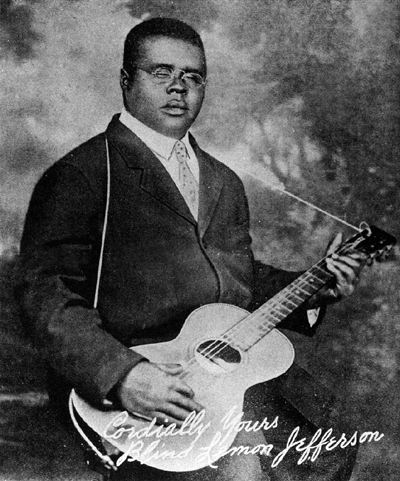
Above is the only photograph of Blind Lemon Jefferson of which I know.
Although I have yet to document the earliest evidence of its usage, the Bantu word, "Mbuki Mvuki," might be the earliest precursor to "Boogie Woogie," "Booger Rooger," and "booga-rooga." In his book, "They Have a Word for It : A Lighthearted Lexicon of Untranslatable Words and Phrases," Howard Rheingold describes "Mbuki Mvuki" as a verb that means to shuck off ones clothes in order to be able to better dance. Thus, the meaning of Mbuki Mvuki is fully consistent with the role of Boogie Woogie as dance music and with the spontaneity and sensuality implied from being naked.
Lee Ree Sullivan of Texarkana indicated that "Boogie Woogie" had been verbally used as a descriptor for Boogie Woogie piano music played in the Texarkana area prior to 1900.68
The earliest instance that I have seen of the word "Boogie" appearing as a word in the title of published music is from 1880. In this instances, the word "Boogie" does not appear in isolation, but rather, occurs within the title, "The Boogie Man" in the 1880 sheet music with music and lyrics by Joseph P. Skelly.
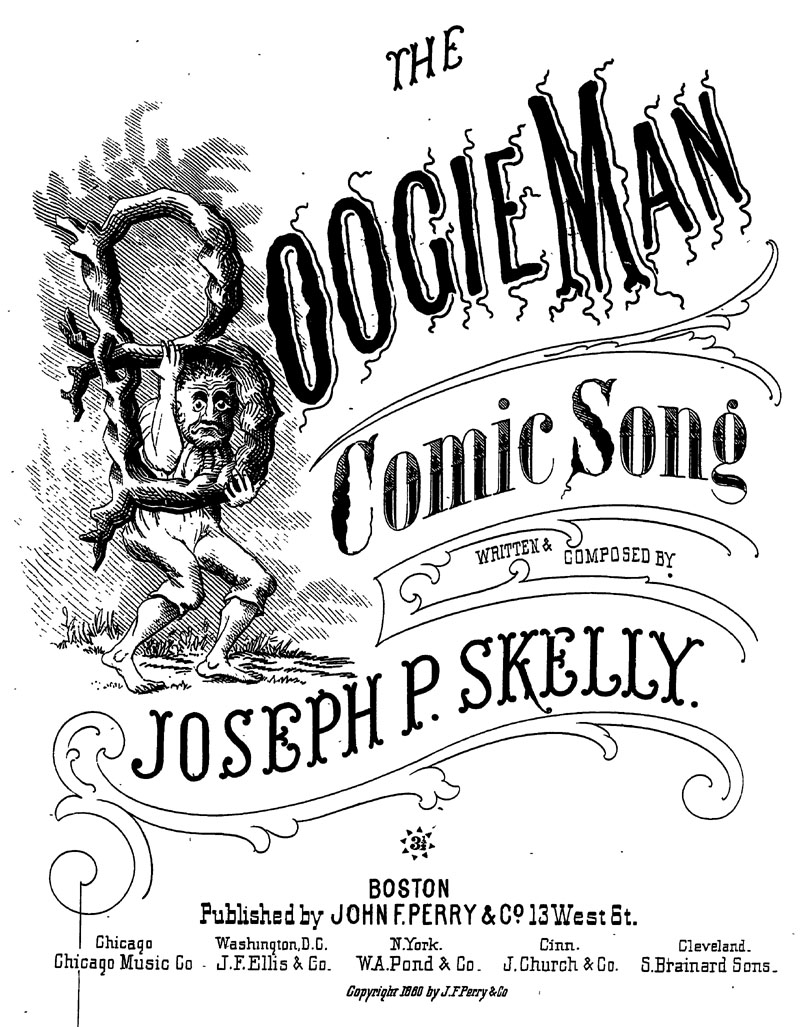
Above is the cover from "The Boogie Man," the 1880 sheet music with music and lyrics by Joseph P. Skelly.
Reference is made to Skelly's "The Boogie Man" in the Saturday, May, 15, 1880, issue of The Evening Gazette, Port Jervis, New York, in the "Literary News Section,"95 where the following text appears:
"In the morning by the bright light" This popular melody arranged as a march—Lithuanian song, Chopin—Children's ball and Cheerful mind, Kullak—Gift of flowers, Gounod — Sweet rememberance, Schmdt—The watermill, Delhi,—and The boogie man, Skelley—comprise the musical numbers in the Score for May, which we have just received. These eight complete pieces, together with nine pages of bright, fresh reading matter from the pen of Louis C. Elson, make this number of the Score the best yet seen. The paper may be obtained by sending 10 cents in money or stamps to the publishers, John F. Perry & company, 18 West street, Boston, Mass.95
Based on these words, it appears that this collection of music was being sold for 10 cents, which among other titles, included one titled "Boogie Man." It would not at all be surprising if there are still earlier instances of "Boogie," in the titles or lyrics of performed songs prior to 1880.
"Bogie," which is a variation of the word "Boogie," appears in the title of another example of published music from 1880. In this case, the title is "Whist! The Bogie Man," with words by Edward Harrigan and music by David Braham.
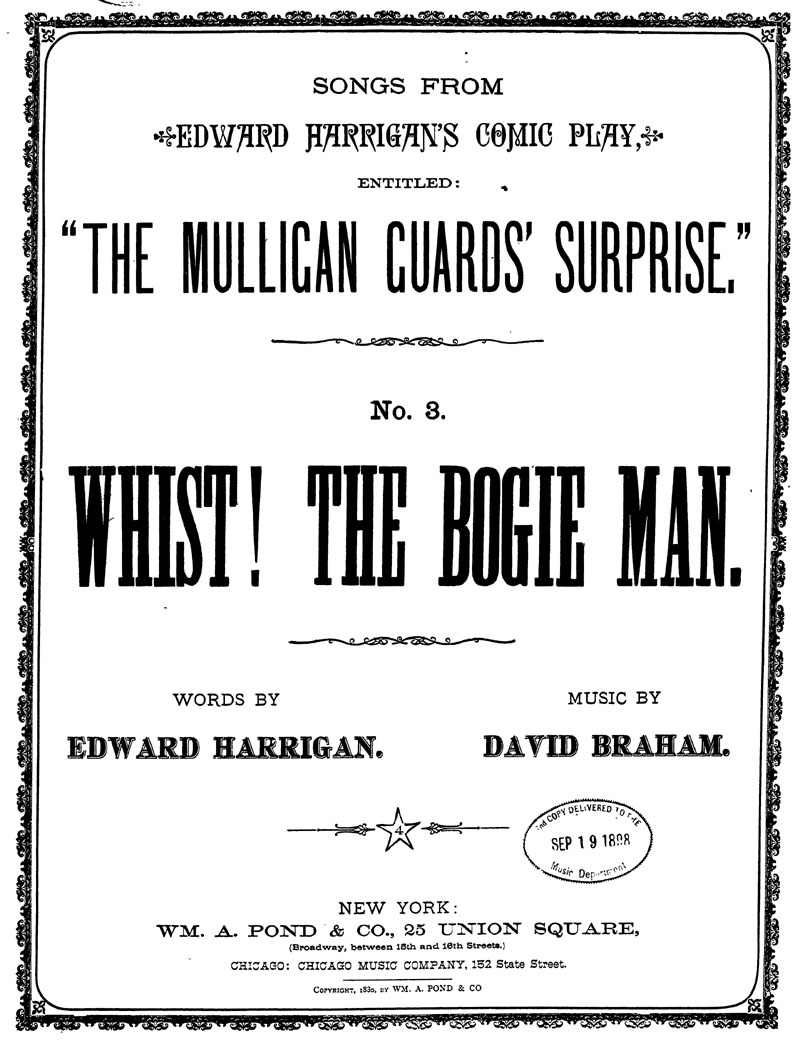
Above is the cover from "Whist! The Bogie Man," the 1880 sheet music with words by Edward Harrigan and music by David Braham.
Another meaning of the word "bogie," is in reference to the wheel assembly or wheel "trucks" that support railroad cars or support the front and/or back of some steam locomotives. On April 12, 2011, Jack and Nancy Canson (from Marshall, Texas) told me that a woman from Kenya, Africa who was living in Marshall, Texas told them that the word "bogie" was used to refer to the train itself in Kenya, Africa. For example, when train was approaching a depot in Kenya, someone might say, "Here comes the bogie." I am not sure when such usage of "bogie" to refer to the whole train first occurred, but the fact that the word "bogie" is being used in this way in Africa begs an etymological investigation. Indeed, if there is a long-standing African tradition of using the word "bogie" to refer to the train itself, (rather than just a wheel truck assembly), then such usage is semantically closer and possibly etymologically related to the musical term, "Boogie Woogie," which is also frequently identified with the steam locomotive.
An Isolated Bogie
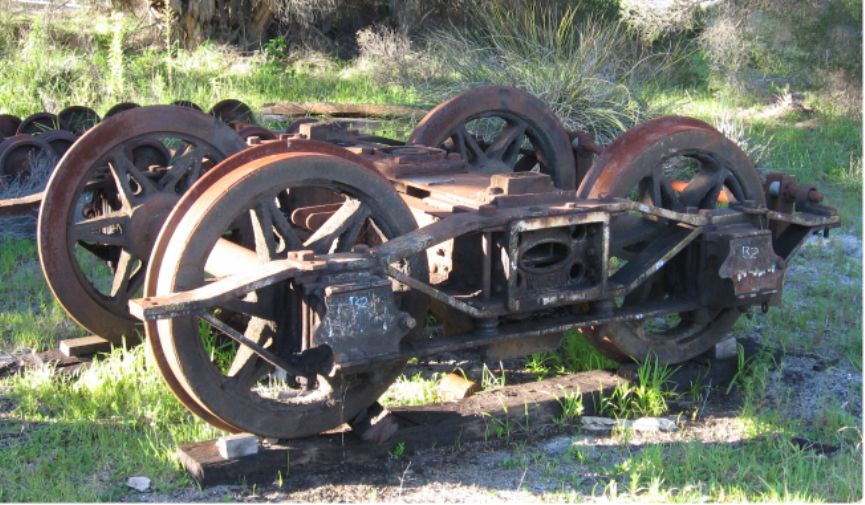
A Bogie Supporting the Front of a Steam Locomotive
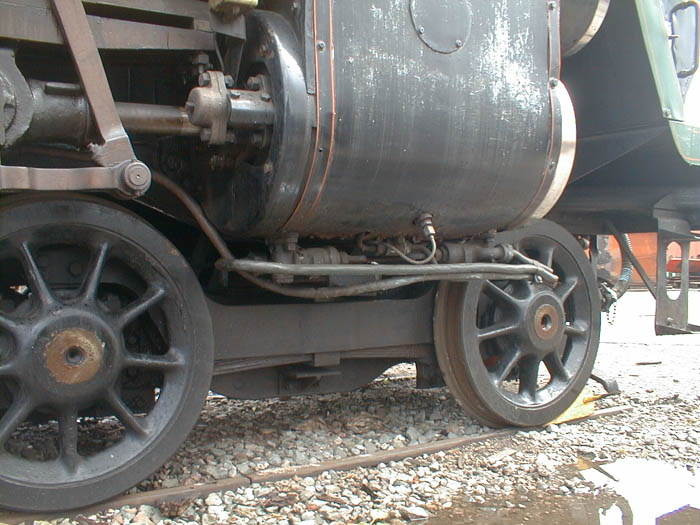
A bogie used in this position is also called the "front truck," as opposed to the "back truck," which supports the firebox of locomotives.
Despite the word "Boogie" and "Bogie" occurring in the titles of published music as early as 1880, not until 1901 have I found an example of published music that shows a reduplication or redoubling of either the word "Boogie" or "Bogie." Specifically, the earliest instance of reduplication or redoubling of either "Boogie" or "Bogie" of which I am aware occurs in the title of the 1901 sheet music, "The Hoogie Boogie Dance" by Mose Gumble. Thus, this 1901 reduplication or redoubling of "Boogie" by use of the word "Hoogie," popularized in print what was phonetically very similar to "Boogie Woogie." Although the word "Boogie" appears in its title, this piece is not musically "Boogie Woogie" as the term is understood today.
"Dance of the Bogie," a piece from 1892, might be the first instance of a juxtaposition in a song title of the words "Dance" and "Bogie." (I have not examined sheet music for this title.)
"The Bogie Dance," a piece from 1898, is another piece prior to 1900 which juxtaposes "Dance" and "Bogie." (I have not examined sheet music for this title.)
Although "Boogie" and "Boogie Woogie" have been reported as in use prior to 1900 to refer to dance, "The Hoogie Boogie Dance" from 1901 might be the first instance where this association was made in print by having juxtaposed the word "Boogie" with the word "Dance." Although the word "Bogie" had been juxtaposed with the word "Dance" in the titles of music prior to 1900, it is possible that "The Hoogie Boogie Dance" from 1901 might be the first instance of a juxtaposition of "Boogie" with "Dance" in print.
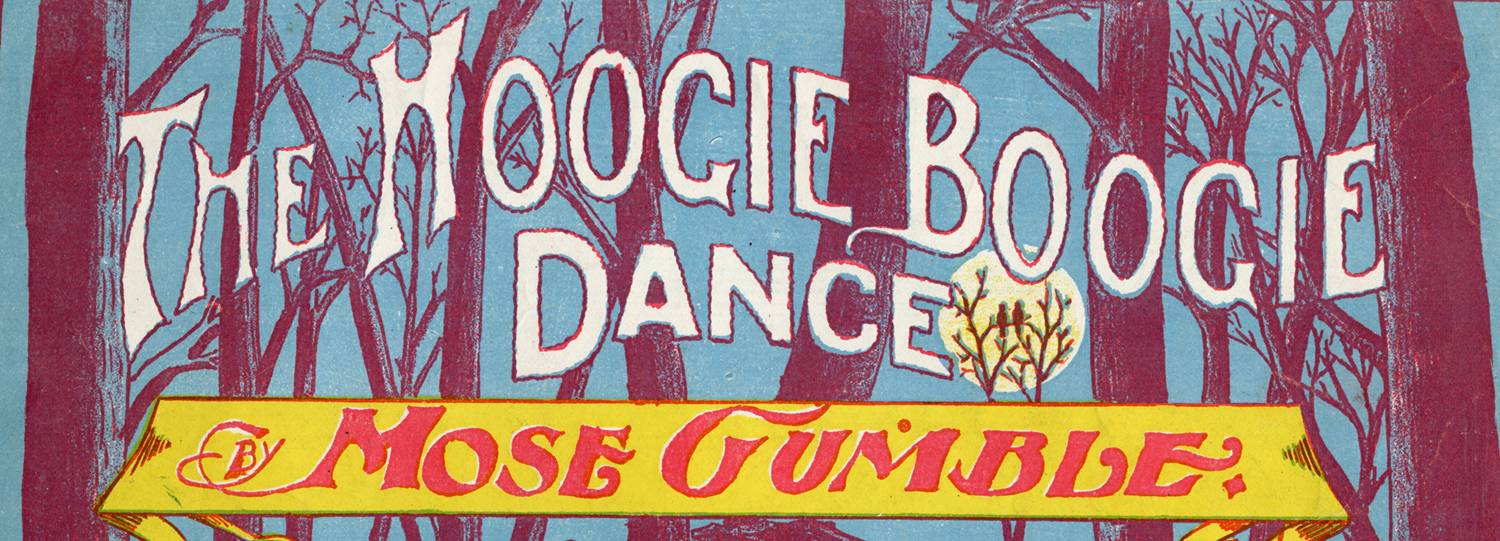
"The Hoogie Boogie Dance" is the earliest example of a reduplication or redoubling of the word "Boogie" in the title of published music of which I am aware. If anyone knows of prior published instances of reduplication or redoubling of the word "Boogie," or related words, please contact me at nonjohn@yahoo.com.
Prior to 1910, “Boogie Boo” appears in the title of published sheet music.93
Although it was not stylistically what would be thought of as Boogie Woogie, the audio recording of "That Syncopated Boogie Boo" by the American Quartet in 1913 on the Edison Blue Amberol label is the earliest use of the word "Boogie" of which I know of in a title of an audio recording. See the Syracuse Digital Library to hear this recording.
Although it is also not stylistically what would be thought of as Boogie Woogie, "Boogie Rag," recording by Wilbur Sweatman and his Jazz Band in April of 1917 is another early example of the word "Boogie" in a title of an audio recording. See http://redhotjazz.com/wswjssbnd.html to hear a recording of "Boogie Rag."
Another obvious pre-cursor to the term, "Boogie Woogie," was "Booger Rooger," as used in the song title, "Booger Rooger Blues" by Texan Blind Lemon Jefferson, and which he was performing in Dallas at least as early as 1917-18.20 Jefferson later recorded this piece in 1926 (circa December). Thus, the term "Booger Rooger" pre-dated the use of "Boogie Woogie" as the title for recorded music. "Booger Rooger Blues" is described as a "hymn to the singer's sexual prowess" by Drew Kent in the liner notes to the CD Box set, "Blind Lemon Jefferson: The Complete Classic Sides Remastered," JSP Records, 2003.65 Thus, the relatedness of "Booger Rooger Blues" to sexuality is consistent with Boogie Woogie's own relatedness to sexuality as discussed by Wilfrid Mellers and others. Blind Lemon Jefferson was also a collaborator with Lead Belly, who reported that both he and Blind Lemon utilized the Texas & Pacific Railroad to travel to locations where they performed their music.
Sammy Price indicates that
Blind Lemon Jefferson used the term "booga-rooga" to refer to bass
figures that Jefferson played on his guitar, and which Price reports were the
same bass figures that Clarence "Pine Top" Smith later used in Smith's 1928 Vocalion piano recording, "Pine
Top's Boogie Woogie" (page 30).40
On page 151 of his 1995 book, "The History of the Blues,"7
Francis Davis writes:
"You'll notice that practically every title mentioned in this
and the previous chapter end with the word "blues." This was the record
companies' way of targeting releases to black audiences. The word seems to
have been routinely added to the titles the performers themselves gave their
songs. That is, Robert Johnson probably wrote a song called "Crossroads,"
Leroy Carr a song called "How Long," and Mead Lux Lewis a song called "Honky
Tonk Train."7
By this logic, Blind Lemon Jefferson's "Booger Rooger Blues" was probably
originally titled, "Booger Rooger."
In 1985, Texarkana historian, Wilbur Smith (born October 5, 1902; died January 20, 2001) told me that his father, who was an engineer on the Texas & Pacific Railroad, recalled the terms “Boogie” and “Boogie Woogie” being used by African Americans to refer to piano music that Smith's father heard played by African Americans in the community of Buchanan in Bowie County in the early 1890s, not far from the Buchanan Depot. With regard to the specific musical elements of the piano music played near the Buchanan depot, Smith said his father did not say anything more specific than describing the music played near the Buchanan Depot as "piano" music. Besides this knowledge from his father, Wilbur Smith was intimately familiar with the musicians and the music performed at the various brothels, as his first job as a teenager was to ride his bike from brothel to brothel to collect coins from player pianos at each of the brothels. Wilbur Smith told me that, during this job, he had personally witnessed the words "Boogie" and "Boogie Woogie" being used to refer to piano music played in Texarkana's red Light district (AKA "Swamp Poodle") prior to 1915, and said that the piano music he heard "sounded similar to Pine Top's Boogie Woogie." However, Smith was not able to be more specific with regard to specific bass figures or other elements used in the piano music he had heard.
Location of the Texas & Pacific Buchanan Depot in the 1890s
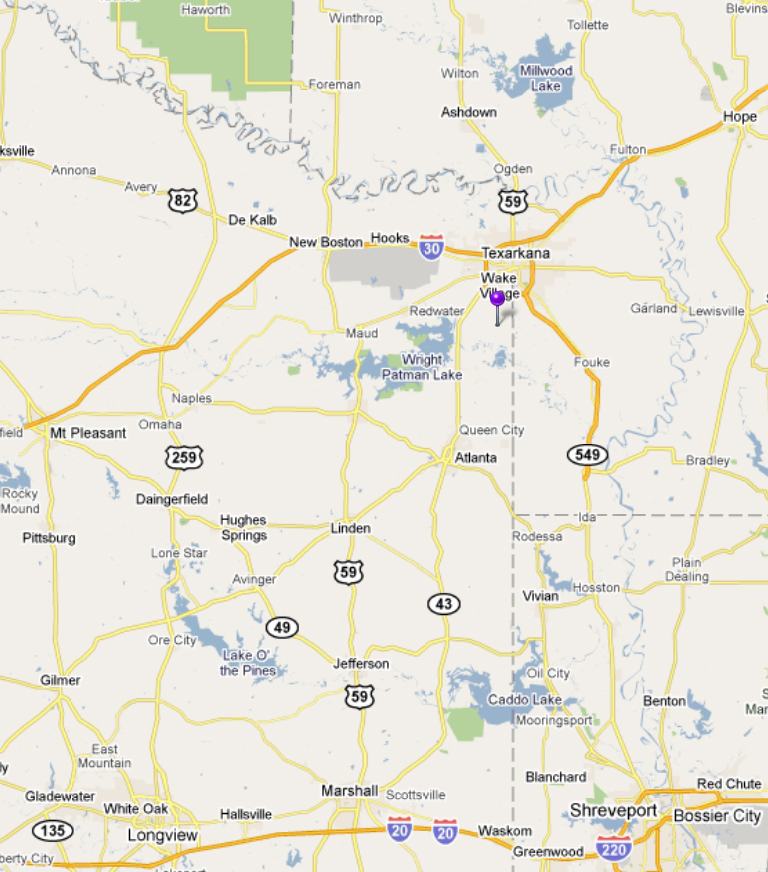
The Texas & Pacific Depot at the Buchanan community was located at approximately where the purple pin is located above.
Detail of the Location of the Texas & Pacific Buchanan Depot in the 1890s
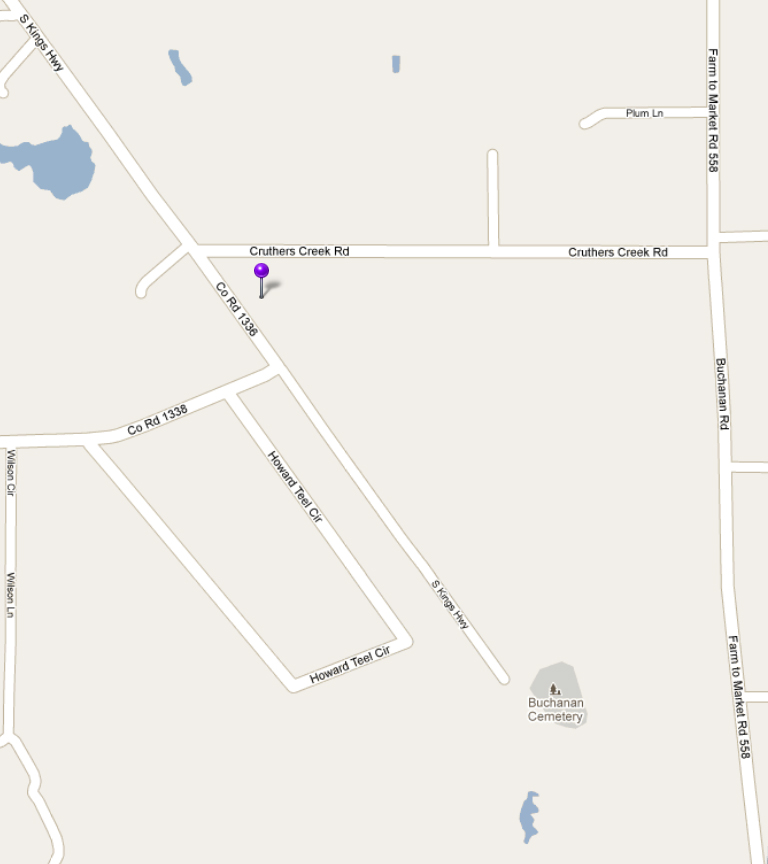
The Texas & Pacific Depot at the Buchanan community was located at approximately where the purple pin is located above. As can be seen, the depot was southeast of the intersection of South Kings Highway (the original Texas & Pacific Railroad route into Texarkana from Marshall) and Cruthers Creek Road. "Cruthers Creek" is a modern-day misspelling of what was originally spelled "Crutchers Creek." The land owner for whom the creek was named was William Crutcher. At the southern terminus of modern-day South Kings Highway can be seen the African-American Buchanan Cemetery.
In 1984, Texarkana Arkansas High School band director, George Gamble, told me that he had heard that "Boogie Woogie" had been used as a term for dancing in the Texarkana area before having been used as a descriptor for a piano style. Moreover, Gamble also told me that he had heard that "Boogie Woogie" started being used as a descriptor for left-handed ostinato piano blues prior to 1900 in the Texarkana area.
Another early account of the use of "Boogie Woogie" comes from a 1986 interview that my father (Alfred Tennison, Jr.) and I conducted of African American Texarkana Boogie Woogie player, Lee Ree Sullivan.68 Sullivan said that African American piano players who performed at a "juke joint" in the Liberty-Eylau area just outside of Texarkana told him that swinging piano-based and guitar-based ostinato Boogie Woogie bass lines (distinctive from the oom-pah ragtime bass lines) were being played in Texarkana-area logging and railroad construction camps prior to 1900 and that the word "Boogie" and "Boogie Woogie" were being used to describe both these types of musical figures, as well as the dancing and sexual behaviors associated with the music before 1900.
In 1986, Lee Ree Sullivan also demonstrated twelve specific Boogie Woogie bass figures that his mentors told him were in use in Texarkana prior to 1900. Sullivan also indicated that he had been told that these bass figures had been developed at and were known for specific logging and railroad construction camps in the Texarkana area, and in locales around Texarkana in the area generally known as the "Arklatex." ("Arklatex" is an acronym for the geographical area at the confluence of Arkansas, Texas, and Louisiana. It includes Texarkana, Shreveport, Atlanta [Texas not Georgia], Jefferson, Marshall, and Longview, as well as many other smaller communities.)68
(See section below titled "Boogie Woogie Bass-Figure Nomenclature in Use in the Liberty-Eylau Community of Bowie County, Texas, in the 1950s" .)
If Smith's, Gamble's, and Sullivan's accounts are accurate, usage of the term "Boogie" and "Boogie Woogie" as terms associated with piano music occurred at least as early as the early 1890s, and thus, would pre-date Blind Lemon Jefferson's use of the terms, "booga rooga" or "booger rooger."
Prior to the public presentation of my research, the only published account indicating a Texarkana-area origin for the term "Boogie" that I found was in the form of a card from a 1980s Texarkana trivia board game published by the Texarkana Kiwanis Chapter and the Texarkana Work Center. The game had a similar design to the popular Trivial Pursuit game. Upon speaking with a member of the Kiwanis Club in 2003 to try to determine the sources used for the trivia questions on the cards, l learned that the historical database for the game had drawn upon various sources, including knowledge of Texarkana historians, including Wilbur Smith. However, the comment on the trivia game card was less specific than what Wilbur Smith had already told me in 1985. That is, the card from the Texarkana Trivia game indicates that the word "boogie" originated in Texarkana during the "1890 to 1930 era of music." Yet, Wilbur Smith had already told me in 1985 that his father had heard both "Boogie" and "Boogie Woogie" used by African Americans to refer to piano music they played in the Buchanan Community of Bowie County, Texas, which is south of Texarkana on the Texas and Pacific line.
Trivia Game Card Indicating a Texarkana-Area Origin for the Word "Boogie"
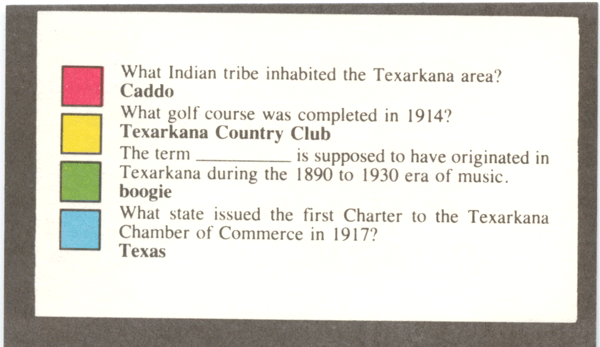
(The image above was scanned from John Tennison's Archives)
Since Pine Top Smith and Cow Cow Davenport were performers from the south on the T.O.B.A. circuit, they would have travelled to the Deep Ellum area of Dallas, where Blind Lemon Jefferson was known to give frequent public performances. Smith and Davenport could have easily heard and copied Jefferson's bass figures while touring on the T.O.B.A. circuit in Dallas. Sammy Price confirms Dallas as being on the T.O.B.A. circuit (page 19)40:
"The TOBA shows that toured in the South always stopped over in Dallas."
Moreover, Sammy Price confirms the presence of Cow Cow Davenport on the T.O.B.A. circuit in Dallas at least as early as 1925.40
On page 131 in Chapter 3 (titled "Mojo Hand") of the book, Deep Blues20, music historian Robert Palmer wrote:
"Blind Lemon Jefferson was using the term 'booger rooger,' apparently slang referring to a particularly wild party, at least as early as 1917-18, and the New Orleans pianist and songwriter Clarence Williams remembered hearing Texas pianist George W. Thomas play a tune with a boogie-woogie bass part [later published as 'New Orleans Hop Scop Blues'] in Houston in 1911."20
Moreover, when speaking of Boogie Woogie as played in the late 1920s, music historian Giles Oakley wrote in his book, “The Devil’s Music: A History of the Blues:”24
“Both the music and the word boogie had been around for years; brothels were called boogie houses, and to ‘pitch a boogie’ could mean to throw a party, or something more sexual, but it was the 1928 recording of Pine Top’s Boogie-Woogie by Pine Top Smith which pinned the name to this rough, driving piano style.”24
Charles "Cow Cow" Davenport claims to have coined the term, "Boogie Woogie" in 1924 when referring to Boogie Woogie as played by Clarence "Pine Top" Smith. However, the terms "Boogie," "Booger Rooger," and "Booga-Rooga" were in existence prior to 1924, as used at "boogie parties," where Hersal Thomas and others played; and by Blind Lemon Jefferson when referring to his "Booga-Rooga" guitar bass figures. Thus, the transformation from these pre-existing terms to "Boogie Woogie" was a minor phonetic leap. Thus, there appears to be absolutely no reason to credit Cow Cow Davenport with having coined "Boogie Woogie."
Davenport claims that he met Pine Top Smith on the T.O.B.A. circuit
in Pittsburgh, PA. Davenport says he heard Pine Top Smith playing what we
now know as "Pine Top's Boogie Woogie" during this meeting. In the April
15, 1943 issue of Jazz Record, (edited by Art Hodes, promoter of Davenport)43
Cow Cow Davenport claims to have said the following to Pine Top Smith in 1924:
“Boy, look here, you sure have got a mean Boogie Woogie."43
In another account, Clarence "Pine Top" Smith takes credit for first applying the term, "Boogie Woogie" to piano music while Smith was in St. Louis.
In 1991 Biograph Records released the album, "Boogie Woogie Blues," which consisted of digital recordings of piano rolls as played by player piano. Although the album contains a piece by Jimmy Blythe dated 1927 and titled "Boogie Woogie Blues", Frank Himpsl of Valley Forge Piano Roll Company tells me that "Boogie Woogie Blues" actually came from a 1929 piano roll on which the piece had been originally titled "Pine Top Boogie Woogie Blues." Thus the piece appears to be a derivative of and to have taken its name from Pine Top Smith's Boogie Woogie. Frank Himpsl told me that Richard Riley contracted the piano roll title, "Pine Top Boogie Woogie Blues" to "Boogie Woogie Blues" in a 1974 re-cut of the piano roll. Without this clarification, the Biograph album liner notes mistakenly suggest that Jimmy Blythe used "Boogie Woogie" in a title for a 1927 piano roll, which would pre-date Pine Top Smith's December 1928 audio recording of "Pine Top's Boogie Woogie." Thus, assuming Himpsl's account is correct, it appears that not until December of 1928 did the words "Boogie Woogie" first appear in the title of a published sound recording, namely "Pine Top's Boogie Woogie."
Boogie Woogie Bass-Figure Nomenclature in Use in the Liberty-Eylau Community of Bowie County, Texas, in the 1950s
Given that Boogie Woogie
resulted from musical expression by untrained individuals in relatively isolated
settings, a great deal of regional specificity in musical expression occurred.
This fact was documented at least as early as 1939, in "Jazzmen: The Story of
Hot Jazz Told in the Lives of the Men Who Created It," when E. Simms Cambell
wrote the following:
“At these gatherings the ragtime and blues boys could
easily tell from what section of the country a man came, even going so far as to
name the town, by his interpretation of a piece.”1
There were even playing styles that varied within the same municipality. For
example, Houston’s 3rd, 4th, and 5th Wards were each associated with distinctive
playing techniques and repertoire. In the Arkalatex, a similar magnitude
of regional specificity was also present.
A regional nomenclature of the Arklatex, used by Lee Ree Sullivan68, and later corroborated by Artis Brewster, suggests a maturation of Boogie Woogie that began with relatively simple bass figures in the Marshall area, and became increasingly complex in locations where the Texas & Pacific railroad tracks were being constructed radially away from Marshall to the east, west, and north. According to Sullivan, he was taught these Boogie Woogie bass figures by piano players who played Boogie Woogie at "a juke joint" in the Liberty-Eylau community of Bowie County in the 1950s. Sullivan did not give a name for the juke joint, but said that it was near where the Cotton Belt Railroad tracks crossed King's Highway. Modern-day King's Highway occupies the same path taken by the very first Texas & Pacific locomotives when they first chuffed into Texarkana from Marshall in the early 1870s. Thus, the juke joint described by Sullivan was near the location where the Texas & Pacific and Cotton Belt tracks once crossed. However, the Texas & Pacific tracks that occupied the length of modern-day Kings Highway have been removed. Thus, only the Cotton Belt tracks remain near the location of the juke joint described by Sullivan.
Approximate Location of the Liberty-Eylau Juke Joint as Described by Lee Ree Sullivan
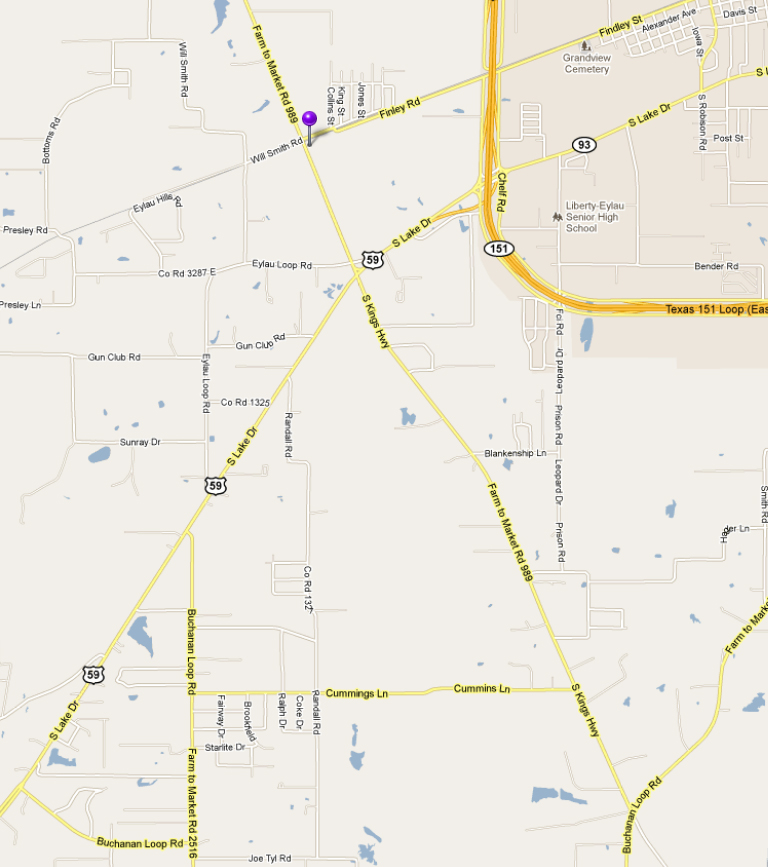
The purple pin above indicates the approximate location of the Liberty-Eylau juke joint as described by Lee Ree Sullivan.
Detail of the Approximate Location of the Liberty-Eylau Juke Joint as Described by Lee Ree Sullivan

The purple pin above indicates the approximate location of the Liberty-Eylau juke joint as described by Lee Ree Sullivan. South Kings Highway (Farm to Market Road 989) was the original route of the Texas & Pacific Railroad from Marshall, Texas into Texarkana, Texas.
Both Sullivan and Brewster believed the following 12 bass figures and their respective names to have been in use prior to 1900. According to Sullivan and Brewster, the names of these bass figures correspond to locations where they were developed. In every case the names for these 12 bass figures correspond to locations served by the Texas and Pacific, or railroad lines that were geographically associated with the Texas and Pacific.
The following 12 Boogie Woogie bass figures were described by Lee Ree Sullivan68. The musical-notation graphics for the 12 figures below have been standardized to a 12-bar form in the key of C, without a swing pulse (i.e. "straight"). However, Sullivan indicated that these bass figures were performed in cycles of improvised numbers of bars and with improvised swing ratios. For example, for a given bass figure, piano players improvised the number of bars such that a given progression might contain any number of bars, the most common being 8, 9, 10, 11, 12, 13, 14, 15, or 16 bars. Because of the improvised and thus, unpredictable chord changes that resulted, other musicians who played pitched instruments typically found it hard to follow the chord changes of the pianist. Thus, the pianists of the Liberty-Eylau school typically played solo piano or with accompaniment by non-pitched instruments, such as drums, washboard, or other non-pitched percussive instrumentation. Each of the bass figures was played with improvised degree of swing, so that, even though a single bass figure might be in use, the pianist would improvise the swing ratio anywhere from straight to a hard swing.
“Marshall” Bass Figure
This is a 4-beats-to-the-bar bass figure. It is probably the most primitive of all Boogie Woogie bass figures. If so, it would have been first played in the early 1870s.
“Jefferson” Bass Figure
This is a 4-beats-to-the-bar bass figure. After the Marshall bass figure, the Jefferson bass figure is probably the 2nd most primitive of all Boogie Woogie bass figures. The fact that the last note in each of the 4-beat cycles goes down in pitch suggests a possible New Orleans influence.
“Hoxie” Bass Figure
This is a 4-beats-to-the-bar bass figure. It was probably developed after the Marshall and Jefferson bass figures as the Texas & Pacific track was constructed northward in the early 1870s. The Hoxie bass figure appears to be a pre-cursor to the 8-beat Texas & Pacific bass figure, in that the Hoxie bass figure can be conceptualized as the first 4 beats of each 8-beat cycle of the Texas & Pacific bass figure. “Hoxie” was a stop on the Texas & Pacific route in the 1870s, and was near Atlanta, Texas.
“Texas & Pacific” Bass Figure
“Swamp Poodle” Bass Figure
“Texarkana & Northern” Bass Figure
“Black Diamond” Bass Figure
“Waskom” Bass Figure
“Greenwood” Bass Figure
“Shreveport” Bass Figure
“Big Sandy” Bass Figure
“Tyler Tap” Bass Figure
“The Cows” & The Texas & Pacific Railroad
The problems caused by cows were legendary during the construction of the Texas & Pacific railroad. According to Lee Ree Sullivan, the right-handed figure used in Boogie Woogie was inspired by these problems.68
“The Million
Dollar Cow That Changed History”
“Because of a cow, or cows, the railroad was
lost to many towns west of Dallas. Further,
it is possible that cow or cows cost the
Texas and Pacific $1,000,000. A glance
at the map shows the route of the T&P as
almost a straight line from Marshall west to
Weatherford and in one tier of counties. But
beyond Weatherford it suddenly dips
southward into the tier below. That
cow or cows caused that. The engineering
parties surveying the route, according toe
Curtis Hancock, a rancher, who was in
Abilene when the road reached there, had
instructions to kill cows for food, send in
the hide and from the brand the road would
pay ranchers who had already been contacted.
In Palo Pinto County the surveyors killed a
cow or cows according to Hancock and he is
borne out by Mrs. Mary Whatley Clarke,
Editor of the Palo Pinto County Star, and
John W. Everman, T&P Official for many
years. But the owner hadn’t been
contacted. With his guns on he went to
see the surveyors. But the railroad
men were armed too. The cowman went
back for help. He got it. Others
rallied to him. They didn’t want cows
being killed either by engineers or the
railway trains, that would follow them.
They didn’t want any dang railroads cutting
up their range. The was cow country.
It looked, said Hancock, like a massacre, a
pitched battle. But the engineers had
seen much of the West reclaimed from savages
by the Union Pacific, climate changed by
farming, towns spring up where stations were
located. Well, if the cowman didn’t
want civilization…the engineers reported the
situation to headquarters. And back came
word to build around the troublemakers even
if it cost $1,000,000. They did.
And that deep swing southward probably cost
more than a million. As for the cost to Palo
Pinto, in the 1940 census it had a
population of 482.”80
-- Page 35-36, Texas & Pacific Railway: From
Oxteams to Eagles, 1978, by Don Watson &
Steve Brown.80 (This text was a re-print
from a pamphlet published by the Texas &
Pacific Railroad published in 1946.)
Conflation of
“The Cows” with the “Texas & Pacific” Bass
Figure
According to Lee Ree Sullivan, “the Cows”
was originally a right-handed figure played
as an onomatopoeia in Boogie Woogie for the
sound of cows being swept off the tracks by
the pointed “cow catcher” grills at the
front of Texas & Pacific steam locomotives.
As a right-handed figure, “The Cows” was
played on top of the left-handed “Texas &
Pacific” bass figure. However, in the
early 20th century, a process of conflation
occurred whereby “The Cows” came to refer to
the “Texas & Pacific” bass figure.68
Cow Cow Davenport Based His "Cow Cow Blues" on "The Cows" Bass Figure He Heard in Texas

Cow Cow Davenport is pictured above.
Both Charles "Cow Cow" Davenport and Clarence "Pine Top" Smith were both born in Alabama. Charles Davenport was born in Anniston, Alabama in April of 1894. Davenport reports having contact with Clarence “Pine Top” Smith in Pittsburgh on the T.O.B.A. circuit. Smith was born in Troy, Alabama, in January of 1904, and later became a traveling performer on the T.O.B.A. circuit.
Davenport spent time in Texas and based his "Cow Cow Blues" on music that he had heard
being played in Texas. In the book, "The Story of the Blues,"
in the chapter, "Struttin' that Thing," (page 89)5
Paul Oliver writes:
“Davenport made his way to Texas where he picked up a theme call The Cows which later he considerably altered to develop a train imitation, the Cow Cow Blues. He worked in mining camps and brothels playing his theme, which earned for him the nickname of ‘Cow Cow’ Davenport.”5
The grace-noted right-hand figures of "Cow Cow Blues" are clearly similar to right hand figures of pieces composed by Hersal and George Thomas. However, the left-hand figures of Cow Cow Blues are the classic Boogie Woogie bass figure known as "the cows." "The cows" represent one of the oldest Boogie Woogie bass figures, and according to Lee Ree Sullivan of Texarkana, "the cows" were also known as "Texas and Pacific Bass."68 Davenport does not swing "the cows" any, if at all. However, Lee Ree Sullivan indicates that "the cows" were being played with inherent swing prior to 1900.68
Davenport's nickname, "Cow Cow," and "the cows" bass figure comes from the "cow catcher," the pointed grill located at the front of steam locomotives. Being named after this part of the steam locomotive creates a powerful metaphor that says, "Get out of the Way! Boogie Woogie coming through!"
A Cow Catcher
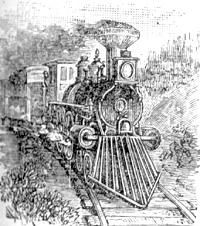
The pointed angular grill seen sticking out in front of the steam locomotive above was known as "Cow Catcher," and was intended to prevent cows from derailing trains.
Sammy Price Played Boogie Woogie in the 1920s
One false account that has been propagated in the published history of Boogie Woogie is the claim that Sammy Price did not start playing Boogie Woogie until 1941. This claim is simply false. Despite the valuable contribution that Peter Silvester made in "The Story of Boogie Woogie: A Left Hand Like God,"9 Silvester erroneously writes of Sammy Price on page 1949:
"He could read music well and was an all-around musician who first began playing in the boogie style in 1941 when he was engaged to appear at Cafe Society Downtown."9
Instead, Sammy Price (born October 6, 1908, in Honey Grove, Texas) had early exposure to Boogie Woogie, and was playing Boogie Woogie in the 1920s, well before his engagement with the Cafe Society Downtown in 1941.
For example, Price describes competing with Hersal Thomas by playing Hersal's own "Suitcase Blues" [containing a shuffled-chord Boogie Woogie bass figure] (page 28-30)40:
Moreover, prior to that, in 1921, Price wrote of playing the piano in church while church pianist Fannie Gibbs was away (page 18):
"While the other children watched, we would play some real low-down blues in church."40
Moreover, Sammy Price's mother bought him his own piano for Christmas in 1921. According to the folio, "5 Famous Boogie Woogie and Blues Solos by Sammy Price" (page 3):
"Sammy Price began playing piano at the age of eleven."59
Therefore, Price began playing the piano no later than 1919, two years prior to his mother's buying him a piano for Christmas.
Incidentally, the town of Price's birth, Honey Grove, Texas, was served by the Texas & Pacific Railroad (see maps in this article), providing still another instance of an association between Boogie Woogie and the Texas & Pacific Railroad.
Itinerant Texas Pianists Bring Boogie Woogie to Kansas City
On page 16 of his book, "Jazz Style in Kansas City and the Southwest,"84 Ross Russell states:
"Pete Johnson was a Kansas City man, born there in 1904, a former drummer in the Lincoln High School band, who had taught himself to play blues and boogie-woogie piano. His experience on drums and liking for eight-to-the-bar rhythm brought to Kansas City by itinerant Texas pianists led to a percussive style. Fellow musicians said of Pete Johnson that his left hand was so strong and so distinct in marking the beats, and so percussive in quality, that the band at the Sunset Club didn't really need a bass player. With Pete Johnson on the piano and a good drummer, the two pieces were a whole rhythm section in themselves."84
Sammy Price & Robert Shaw Further Popularize Boogie Woogie in Kansas City
Sammy Price (born 1908, Honey Grove, Texas, died 1992) played a role in spreading the influence of Boogie Woogie from Texas to Kansas City.40
According to the Texas Handbook of History, Robert Shaw (born August 9, 1908 in Stafford, Texas, died 1985), and who picked up his style in Texas, was performing in Kansas City at the Black Orange Cafe by 1932.
In her column in Record Research, Issue #81, January 1967, Victoria Spivey indicated that there was a piano player named "Houston," who played and sang lyrics to Joe Pullum's piece, "Black Gal," in the Houston & Galveston. Although it is unclear from her text as quoted in the CD release of Texas Barrelhouse Piano, Spivey indicates that either "Houston" or Robert Shaw moved to Kansas City in 1925 or 1926.45
The T.O.B.A. Circuit: Clarence "Pine Top" Smith, Cow Cow Davenport, & Jimmy Yancey
On page 9 of the chapter, "Dallas & Fort Worth," in his book, “Meeting the Blues,”30 Alan Govenar wrote:
“The major blues and jazz performers of the day, from Bessie Smith and Ma Rainey to Alphonso Trent and Benny Moten, always stopped in Dallas on the black T.O.B.A. (Theatre Owners Booking Association) tours, and played in the Central Tracks area.”30
When discussing Jimmy Yancey and Clarence Pine Top Smith in 1939, William Russell wrote:
"Like Yancey, Pine Top had traveled the Theatrical Owners' Booking Agency circuit as a tap dancer in vaudeville."1
If it is indeed true that T.O.B.A. performers "always stopped in Dallas," (corroborated by Sammy Price)40 and since Smith, Davenport, and Yancey were touring members of the T.O.B.A., they almost certainly performed in Dallas. Sammy Price documents that Cow Cow Davenport came to Dallas at least as early as 1925 on the T.O.B.A. circuit (page 23)40.
Smith could have easily heard and emulated Boogie Woogie players in Texas even before he moved to Chicago, and (based on Sammy Price's account)40 prior to Cow Cow Davenport's claim to have heard Smith perform in Pittsburgh on the T.O.B.A. circuit in 1924. Yancey and Davenport could have easily heard Boogie Woogie in Texas before further developing this style in Chicago and elsewhere. Moreover, because other cities in Texas hosted T.O.B.A. performers, witnessing of Boogie Woogie could have occurred in Houston and Galveston as well.
Since the Central Tracks area of Deep Ellum was in proximity to the Texas & Pacific depot, Smith, Davenport, and Yancey could have also easily encountered styles of music, such as Boogie Woogie, played by itinerant musician travelers on the Texas & Pacific and other lines.
Stavin Chain Plays Boogie Woogie in 1904 at Bully Reynolds' Texas & Pacific Saloon in Donaldsonville, LA
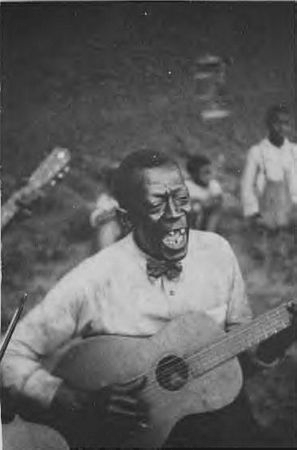
Wilson Jones (A.KA. Stavin' Chain) Plays Guitar above. Is this the same man who was reported be playing Boogie Woogie in 1904 in Donaldsonville, LA?
On page 22 of the July 1939 issue of Down Beat, Onah L. Spencer wrote that songwriter Richard M. Jones witnessed Stavin Chain (possibly A.K.A. Wilson Jones) playing Boogie Woogie in 1904 at Bully Reynolds' T P Saloon in Donaldsonville, Louisiana adjacent to Texas & Pacific Railroad camps 21. Moreover, Richard M. Jones indicated that Stavin Chain had traveled from Arkansas. Since Stavin Chain was heard in Donaldsonville performing for Texas & Pacific railroad workers, he likely had traveled from Shreveport on the Texas & Pacific line. Prior to Shreveport, Stavin Chain could have come from Texarkana directly, or from Texarkana by way of Marshall. Prior to Texarkana, Stavin Chain could have arrived via the St. Louis, Iron Mountain, and Southern Railroad.
Since the Texas & Pacific Railroad had built eastward from Marshall, TX to Shreveport, LA, and then to Donaldsonville, and then to New Orleans, it is plausible that the T&P railroad was responsible for bringing Boogie Woogie out of Texas to from Marshall to Shreveport, then to Donaldsonville, and then to New Orleans. (Since 1871, the New Orleans, Mobile, and Chattanooga Railroad had an operational line between Donaldsonville and New Orleans. Thus, upon T & P's reaching Donaldsonville, Boogie Woogie could have spread quickly to New Orleans. Thus, if we were able to go back in time, following T&P's railroad route from Donaldsonville towards Texas points back to Shreveport, and from there, back to Marshall. Thus, this is still another line of thought that causes me to regard the Texas & Pacific Railroad as The Boogie Woogie Railroad.
Claims of Jelly Roll Morton about Boogie Woogie
Jelly Roll Morton (born in Gulfport, Louisiana on October 20, 1890) claims that when he was a teenager, he heard a piano player by the name of "Lost John" from Birmingham, Alabama playing "that rolling bass" in New Orleans around 1900. If he was a "teenager," as he claims, the year would have been at least 1903, the year in which he left New Orleans and worked various townships in Texas, among other places.5 Moreover, it is difficult to know exactly what Morton means by "that rolling bass." Lastly, Morton was known to be prone to boast and exaggerate, such as claiming that he had invented jazz.
Some of the early Boogie Woogie that Morton reports having heard could have been in Texas, as Paul Oliver documents that Morton spent time in Texas after leaving New Orleans in 1903. In his travels to Texas, Morton likely utilized the Texas & Pacific Railroad, as suggested by his having written "Shreveport Stomp." That is, Morton's "Shreveport Stomp," although not Boogie Woogie (It has an Oom-Pah pulse like Ragtime.), implies that Morton had some familiarity with Shreveport, a town significantly served by the Texas & Pacific Railroad.
Of Jelly Roll Morton, Paul Oliver writes (page 84)5:
“His recollections of the Gulf Coast
pianists, many of whom would have been older than himself, give an indication of
the popularity of the instrument for the blues, what he remembered as the blues,
at this time. He left New Orleans
in 1903 and after working in various townships in Texas, Mississippi and
along the Gulf Coast through Alabama, he made his way up the river via Helena,
Arkansas, to Memphis Tennessee.”5
Therefore, Jelly Roll Morton would have been exposed to the fast piano blues that E. Simms Campbell in 19391 said distinguished the Texas style of fast piano blues (A.K.A. “Boogie Woogie”) from the slower style being played in New Orleans.
Other Claims of Early Performances in the Boogie Woogie Style
Charlie Mills was said to have been playing Boogie Woogie on the riverboats around New Orleans.18
In 1909, W. C. Handy claims to have heard Boogie Woogie in the Monarch saloon on Beale St. in Memphis, TN.18
Even though the Texas & Pacific Railroad did not have its own line to St. Louis, St. Louis nonetheless was emphasized strongly in advertisements for the Texas & Pacific Railroad, because St. Louis was served by the Jay Gould system of railroads.
Tennison's Ten Boogie Woogie Elements
The following ten elements create the Boogie Woogie feel. The first 3 of these Ten Boogie Woogie Elements are formal elements that MUST be present for a piece to be formally Boogie Woogie. However, the influence of Boogie Woogie has often occurred when any one or more of these elements is used, even if the end result is not formally Boogie Woogie.
1. Perpetual Motion (AKA Continual Movement) -- This element is usually present as a result of using an ostinato in the left hand. The perpetual motion usualy occurs in the bass line, often as a monophonic walking bass, or often using broken-octave intervals. Although there are no specific melodic intervals required to create an a sense of perpetual motion, Boogie Woogie walking basses have often used (referenced to the key of C) an 8-note ostinato of (ascending) C, E, G, A, B-flat, (then descending) A, G, E, and then repeating this 8-note sequence. Often the B-flat is replaced with the octave a step above the B-flat. Another popular variant is that of a shuffled pattern involving two-notes played at once, such as the tonic and the perfect fifth, alternating with simultaneous sounding of the major third and the major sixth.
2. Polyrhythm of the Cross-Rhythm Sub-Type -- There is an interplay between the right and left hand parts in Boogie Woogie such that polyrhythm of the cross-rhythm sub-type occurs. That is, these cross-rhythms are created by the relationship between the left and right hand parts. To qualify as a cross-rhythm, there must be two different metric pulses, or frames of reference, which have an irrational-number ratio to each other. So, 3-on-2 would create cross-rhythms. If either time-division (2 or 3) when used in the numerator and divided by the other number results in an irrational number, then a cross-rhythm is generated. So even though 3 divided by 2 is not an irrational number, 2 divided 3 is, and thus, playing 3-on-2 or 2-on-3 would generate cross rhythms. Although such divisions as 2-on-8, or 4-on-8, or 16-on-8 can allow for different rhythms at the same time (technically "polyrhythm"), ratios between these two time frames are not irrational numbers, and do not give the same feel or the sense of as great of a magnitude of independence of hands as experienced when cross-rhythms are being used. If a bass line is not shuffled in and of itself, a shuffled feel is frequently present from the polyrhythmic interplay between the right and left hands, ("Interactional Swing Pulse"). In addition to interactional swing pulse, many other cross-rhythms occur from the infinite number of possible interactions between the right and left hand.
3. Piano-Like Timbral Dynamics -- Boogie Woogie players take advantage of the large range of timbral differences that occur from hitting a string with a hammer over a wide range of striking forces. A highly percussive, and often melodic, right-hand part is frequently present. This part is often staccato, often ostinato, and often rhythmically complex in and of itself. Although instruments such as brass and woodwinds can duplicate the melodic intervals used in Boogie Woogie, such instruments cannot duplicate the range of timbral dynamism that comes from hitting a string with a hammer.
4. Swing Pulse -- The presence of a swing pulse will contribute to a Boogie Woogie feel, such as when a Boogie Woogie bass line is shuffled, i.e. swung. An overall swing pulse can result from an "Intrinsic Swing Pulse" in the left or right hand. However, if it is only present in one hand's part, Intrinsic Swing Pulse has traditionally occurred in the left hand part. An overall swing pulse can also result from an interaction between a right hand part and a left hand part that, when isolated, might have no intrinsic swing of their own (what I call an "Interactional Swing Pulse"). This way of creating a swing feel is one of the most basic forms of polyrhythmic interplay. Since skillful players can swing the right and left hand parts independently of each other, a dimension of infinite variability is created by the interaction between the two hands. That is, the greatest polyrhythmic heights are reached when a performer can independently vary the amount intrinsic swing in the left right hand parts, which are then freed to interact with each other, yielding extreme polyrhythmic complexity, as heard in Boogie Woogie. Consequently, this "Poly-Swinging" is not nearly as fatiguing to the ears as the incessant, non-varying, straight, 2/4 "oop-pah" patterns heard in much of Ragtime. (Ragtime bass parts can be intrinsically swung, but given the width of Ragtime bass "strides", swinging a wide oom-pah stride bass is very difficult. Thus, if a swing pulse is present in Ragtime, it is usually intrinsic to the right hand, or comes from an Interactional Swing Pulse between right and left hand parts.)
5. Syncopation -- Syncopation occurs in either or both hands. Syncopation is the process of placing musical events in locations that are not suggested or occupied by a pre-existing musical pulse, rhythm, or other structure.
6. Counterpoint – The left-hand part is frequently melodic and contrapuntal to the right-hand part. This quality distinguishes left hand parts in Boogie Woogie from the Oom-pah left hand parts of Ragtime, which are usually subservient to the harmonic demands of the right hand, and, unlike Boogie Woogie, are usually not heard as melodic counterpoint to the right hand parts. The sense of independence of the left hand from the right hand is a direct consequence of the left hand not being overly-sensitive to "correctly" harmonizing with whatever the right hand might be improvising at any moment. This contrapuntal quality (i.e. "independence of hands") between the right and left-hand parts of Boogie Woogie can give the effect that more than one person is playing at the same time. However, in Ragtime, the left hand has traditionally been synchronized harmonically with the right hand part, and thus is not experienced as being as independent or contrapuntal as in Boogie Woogie. (The principle of harmonically-related notes sounding less contrapuntal is easily most simply demonstrated by playing two notes in unison one octave apart. Although a trained ear can hear two notes, untrained ears will often experience a "fused," single event as a direct consequence of the two notes having their overtones in common. As two simultaneously-sounded noted became less harmonically related, it becomes easier for human perceptual systems to experience two events as a direct consequence of having progressively fewer overtones in common.)
7. Tonality -- There is a strong sense of tonality (i.e. a sense of musical key) and tonicity (frequent emphasis of the tonic) that is usually present. This process can occur even when an explicit melody is not identifiable. Cues of tonality will often be interspersed with improvised, atonal explorations into dissonance, such as in Meade Lux Lewis's Honky Tonk Train. However, these temporary atonal dissonances are usually not of a magnitude strong enough and typically do not last long enough to overcome the overall sense of tonality.
8. Chord Usage -- There is an emphasis of I, IV, and V chords in harmonic progressions, often in a 12-Bar, or so-called "12-Bar Blues" progression. However, a 12-bar cycle is not intrinsically any more powerful at creating a Boogie Woogie than progressions of any other length of bars. However, the habitual use of 12 bar progressions has created a sense of public expectancy that can be delightfully and pleasingly defied by an improvisatory Boogie Woogie performer. Relative to the potential use of other chords, emphasis of the I, IV, and V chords increase the resolutional power (i.e. tonality) of the tonic of the I chord, and thus Element 8 (Chord Usage) is related to Element 7 (Tonality).
9. Tempo – In terms of its function as dance music, Boogie Woogie tends to use a certain range of tempos (typically considered "fast") that are more sonically analogous with the mechanics of human bodily movement than other tempos, and thus more likely to illicit dancing.
10. Use of Specific Intervallic Sequences – Certain intervallic sequences, especially bass figures, are identified so strongly with Boogie Woogie that, even when not played as ostinato, the presence of such sequences convey a sense of Boogie Woogie, and are universally recognizable throughout the world. (The most well-known of these sequences are variants of the T&P bass figure, also known as “the Cows.”)
The pieces that will be most intensely felt as Boogie Woogie will be those that have all ten of these elements present.
Although some writers have described Boogie Woogie as being 8-to-the-bar or in 12-bar cycles, these features do not necessarily enhance the magnitude of Boogie Woogie feel. For example, it would be easy to write a piece in 7/8 time signature with a 7-to-the-bar feel, all in a repeating 7-bar progression using I, IV, and V chords that had a very strong Boogie Woogie feel. However, being "8-to-the-bar" or utilizing 12-bar cycles might create a sense of familiarity or satisfaction in some listeners who have a sense of expectancy because of having heard other Boogie Woogie pieces in an 8-to-the-bar and/or 12-bar-cycle forms. However, the delight of having this expectancy defied is delightful to many in the same way that syncopated events are delightful precisely because they can occur in places where they might not otherwise be expected.
The "Texas & Pacific" and "Houston & Texas Central" Railroads
Helped Deep Ellum Develop as a Mecca for Original Music.
According to the Age of Steam Railroad Museum in Dallas, TX,
"By 1873, several North Texas towns were keeping up with Dallas’ growth, but that would change before the year’s end. The Texas & Pacific Railway crossed the Houston & Texas Central Railroad line near Browder Springs as it built westward towards Ft. Worth and El Paso. This junction of two major rail lines, would draw people and businesses from all over the U.S. as well as the neighboring communities, which were suddenly at a disadvantage."
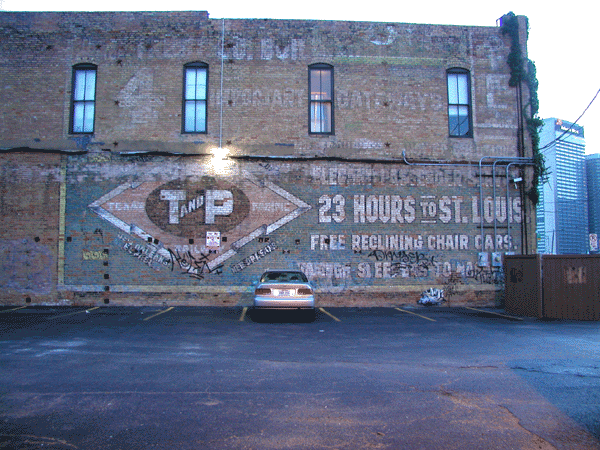
The photograph above was taken by John Tennison at dusk in June of 2004. The street address of the building on which this sign is painted is 2528 Elm Street, Dallas, Texas. The building is on the south side of Elm Street.
On page 9 in the Chapter, "Dallas & Fort Worth," in his book, “Meeting the Blues,”30 Alan Govenar wrote:
“Probably the most well known and widely imitated of the Deep Ellum blues singers was Blind Lemon Jefferson, who followed Central Tracks to Elm Street with a walking stick and a guitar slung over his shoulder. The area of Dallas known as Central Tracks was a stretch of railroad near the Texas and Pacific depot and crossed by the H&TC line. Lying east of the downtown business district and north Deep Ellum, Central Tracks was the heart of the black community.”30
Recollections by Clarence Williams about George Washington Thomas, Jr. (A.K.A. "Clay Custer")
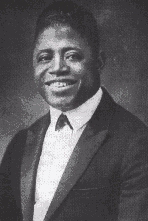
Clarence Williams
On page 2 of his 1940 "Boogie Woogie and Blues Folio,"63 in his annotation to the reprint of the 1923 sheet music of George W. Thomas, Jr.'s "New Orleans Hop Scop Blues," (first published in 1916 by George W. Thomas) Clarence Williams states:
"The 'Boogie Woogie' originated in Texas many years ago. It wasn't called the 'Boogie Woogie' then. George Thomas was the fellow who used this style and first wrote it down."63
and
"I met Thomas in 1911, in Houston, Texas. Although I was in my teens and Thomas was old enough to be my father, we became staunch friends.
We used to like to get together after our work was finished for "jam sessions".
At that time I was playing vaudeville with the Benbow Stock Company. The orchestra consisted of a drum and piano.
Sometimes a trombone was added. Many times I had to play the piano in the pit and double on the stage.
Thomas played during pictures and the intermissions. Later we played in various places in Houston and were brought together in the 'wee' hours of the morning, for our much loved
'jam sessions'."63
and
"Thomas composed "NEW ORLEANS HOP SCOP BLUES" which was the first tune with the "Boogie
Woogie" bass movement. I first heard him play it in the theatre in 1911. At that time he called it the "Hop Scop Blues" because of the rolling, hopping bass.
It was an instrumental tune."63
and
"In 1913 I went back to New Orleans and established a publishing company under the name "WILLIAMS &
PIRON". My friend, Thomas, joined me in New Orleans in 1914. Inspired by my success, he opened a music publishing house and in 1916, published "NEW ORLEANS HOP SCOP BLUES", which was originally his "HOP SCOP BLUES." He wrote lyrics to it and named it after New Orleans because the Crescent City was the music center of the south. Therefore he wanted to get the good will of the music buying public and increase the sales value."63
and
"It was funny how George followed me around. We went around plugging our songs and even sold them from door-to-door together.
In 1918 I moved to Chicago and opened a publishing house in the Chicago loop, and three music stores on the south side.
George came to Chicago too. In 1923 I bought "NEW ORLEANS HOP SCOP BLUES" from him.
A few years later he died."63
Williams does not say that Thomas "invented" Boogie Woogie, only that Thomas was the first to "write it down" in his "New Orleans Hop Scop Blues," first published in 1916. This account is consistent with that of Paul Oliver, who has reported that Thomas based his "Hop Scop Blues" on music he heard in East Texas.5
Even if George Thomas was the first to write down a Boogie Woogie bass figure, Artie Matthews used "the cows" Boogie Woogie bass figure in his "The Weary Blues," published in 1915.
The Influence of Texas Climate & Dilapidated Pianos on Boogie Woogie
The 2003 “Texas State Parks Guide” from the Texas Parks and Wildlife Department,
(page 95), stated:
“Deep in the heart of East Texas is an area of plentiful rainfall and tall trees that some like to call “Wet Texas.” This dense woodland of pines and hardwoods known as the Pineywoods encompasses the wetlands of the Big Thicket to the rolling hills that stretch north to the Red River. Here, you can picnic under lush green wooded canopies, paddle along quiet, shaded creeks and mossy cypress sloughs, or steer your boat into the open waters of some of the state’s largest lakes, which offer some of the state’s most diverse fishing. Take your family for a ride on a vintage steam train or follow the roads along the Texas Forest Trail, where you’ll find some fine examples of period Texas architecture as well as ancient ceremonial mounds built by the Caddo Indians.”
These ceremonial mounds in Texas are essentially a more primitive form of pyramids, which occur throughout the world.
The Boogie Woogie Beat: Rompin' Stompin' Rhythm, Broadcast the week of 1/17/02, Based on Riverwalk script ©2001 by Margaret Moos Pic stated:
"The inventors of the boogie woogie beat coaxed music out of honky tonk pianos: old uprights mildewed from perpetual humidity and the occasional Saturday night beer bath."
The thick, "chorused" sound of Boogie Woogie resulted from out-of-tune pianos in these environments. Moreover, the rickety, rattling sound of these dilapidated upright pianos was PART OF the Boogie Woogie sound. These unpredictable rattling sounds were not unlike the result of the traditional practice of intentionally attaching rattles to the edges of West African djembe drums, so that each time the drum is hit, both the sound of the membrane (A.K.A. "head") of the drum drum and the rattles are heard.
Present-Day Piney Woods of East Texas

As can be seen in the map above, the pine/hardwood forests (depicted by the light green color labeled #42 in the legend above) were the primary areas where logging communities in Texas were located. Thus, if you correlate early railroad track locations, railroad camp locations, logging camp locations, turpentine camp locations, and the areas of highest African American population density, you will derive what I call the "Boogie Woogie Circuit," the paths along which musical ideas and performances were shared and along which Boogie Woogie evolved.
Destruction of Virgin Forests in the United States
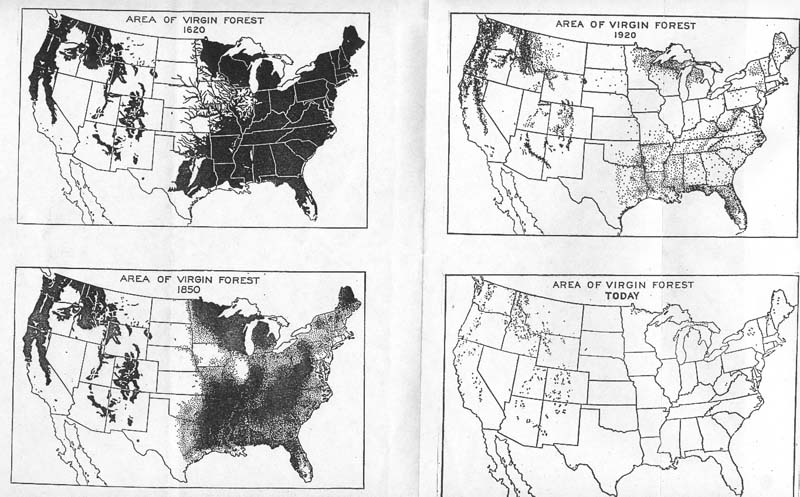
The 1620, 1850, and 1920 maps above were taken from the 1925 publication, "The Relation of Geography to Timber Supply," Economic Geography, vol.1, pp 11-11 (1925) These maps suggest that the Virgin Forests of far East Texas did not extend all the way to the shore. For example, present-day Jefferson County (on the coast) appears to have had less Virgin trees than counties that were further northward. Thus, the earliest lumber and turpentine camps would almost certainly have been a number of miles inland.
Texas & Pacific: The Boogie Woogie Railroad
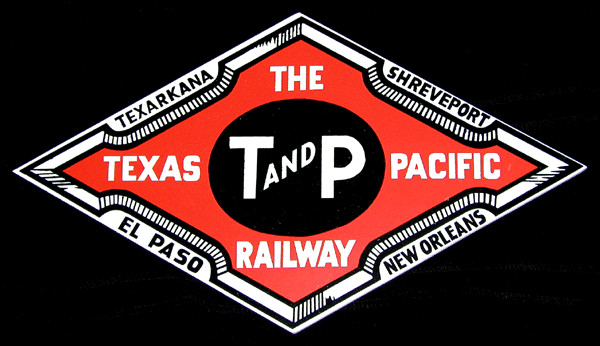
The Texas and Pacific Railroad logo above was featured on the front of T & P steam locomotives, including the 2-10-4 "Texas" type. Three cities named along the edges of the logo -- Texarkana, Shreveport, and New Orleans -- played vital roles in the formation and early evolution of Boogie Woogie, Ragtime, and Jazz. Later, El Paso figured prominently in inspiring Boogie Woogie pieces by Louis Jordan, such as "Choo Choo Ch'Boogie" (inspired by steam-locomotive sounds from T&P and other trains at the El Paso Depot) and "Texas & Pacific." Prior to Jordan, the T&P had inspired other pieces such as "Texas & Pacific Blues" by Frenchy's String Band, and "Railroadin' Some" by Henry "Ragtime Texas" Thomas, a itinerant musician who used the T&P between Dallas and Texarkana.
The Texas & Pacific Railway had its headquarters in Marshall, Texas. The first railroad of the Texas & Pacific consisted of 66 miles of pre-existing track that the Texas & Pacific purchased in 1872 from the Texas-based Southern Pacific (not the Southern Pacific originating in California) that had Longview at its western terminus and Waskom at its eastern terminus. Marshall was the hub of this east-west running line. By 1873, prominent East Texas towns served included Dallas and Texarkana.
The Texas-based Southern Pacific was the earliest instance of a site deep within the Piney Woods of East Texas that involved both logging and railroad construction. This Texas-based Southern Pacific Railroad in Harrison County ran from Swanson's Landing on the south shore of Caddo Lake to Marshall, Texas. This Texas-based Southern Pacific had originally been charted on February 16, 1852, as the "Texas Western Railroad," but had changed its name to "Southern Pacific" on August 15, 1856. In 1857, this Texas-based Southern Pacific constructed 23 miles of track between Swanson's Landing and Marshall.54 Although this was not the first railroad to be constructed in Texas, it was the first one to be deep within the Piney Woods of East Texas. The prior Buffalo Bayou, Brazos and Colorado Railroad in Harris and Fort Bend Counties was on the edge of the Piney Woods, and ran over a terrain composed mostly of grassy planes that are common near the coast of Texas (See maps of virgin forests of Texas elsewhere in this article).
The early tracks that began at Swanson's landing were attached to ties (the wooden cross planks) that came directly from local logging operations in the immediate vicinity of this track construction in Harrison County. The rails, steam locomotive, and rail cars were transported up the Red River by steamboat on their way to arriving at Swanson's Landing in Harrison County. This early Texas railroad that began at Swanson's Landing was originally called the Texas Western Railroad Company (Chartered on February 16, 1852). However, the Texas Western Railroad Company changed its name to Southern Pacific on August 16, 1856. This Southern Pacific was a completely different company from the more well-known Southern Pacific that originated in California.51 This Texas-based Southern Pacific existed for 17 years (from August 16, 1856 to March 21, 1872), at which time it was absorbed by the Texas & Pacific Railroad Company.
Some of the tracks of the Texas-based Southern Pacific were taken up and rerouted during the Civil War to create a continuous line between Marshall and Waskom, which lies on the Texas border. According to the Texas Handbook Online article on the "Civil War:"
Several miles of track of the Texas-based Southern Pacific between Swanson's Landing (on the south shore of Caddo Lake) and Jonesville (between Swanson's Landing and Marshall in Harrison County) were taken up and re-laid eastward to create a continuous track between Marshall to Waskom for military purposes.52
At Waskom, the re-routed Texas-based Southern Pacific line connected with the Vicksburg, Shreveport and Texas Railway Company tracks,54 which connected to Shreveport. Thus, during the Civil War, men working under General Magruder created a railroad line between Marshall, Texas and Shreveport, Louisiana.54 This was the first interstate railroad between Texas and another state, in this case Louisiana. This created the first route whereby Boogie Woogie could spread out of Texas by way of railroad travel. At this time, Shreveport did not have connecting lines back to New Orleans. Thus, this remained a isolated system of railroads that was not yet connected to the national network of rails. The Texas-based Southern Pacific expanded its line 23 miles westward to Longview, in Gregg County, in 1869, resulting in a total of 66 miles of track.54 Thus, Marshall, Texas had become the hub of the first Texas railroad to be deep within the Piney Woods of East Texas. Marshall would become the earliest Hub of Boogie Woogie.51
In 1871, the Texas Legislature recognized a federal charter that created the Texas & Pacific Railroad Company The Texas & Pacific absorbed the Texas-based Southern Pacific Railroad on March 21, 1872. At this time the Texas-based Southern Pacific still consisted only of 66 miles of track between Longview and Waskom. Moreover, at this time, the Texas and Pacific had not yet built any tracks of its own. Thus, the Texas-based Southern Pacific is the predecessor of the Texas & Pacific. Crews of the Texas & Pacific quickly expanded this railroad line to Dallas and built a new spoke from Marshall to Texarkana. The 125-mile stretch between Longview and Dallas began service on July 1, 1873. The newly-constructed 74-mile line from Marshall to Texarkana began service on December 28, 1873.51 By the late 1870s, this hub, or center of gravity of Boogie Woogie, would move northward to Texarkana. By the 1920s, the hub of Boogie Woogie had moved all the way to Chicago, the largest railroad hub in the United States.
Although other railroads came into play later in transporting Boogie Woogie and itinerant musicians to big cities such as New Orleans, St. Louis, Kansas City, Chicago, and New York, such dispersion occurred after Boogie Woogie had developed in barrelhouses, brothels, railroad camps, and lumber camps within Texas, the earliest of which were along the routes of the Texas & Pacific (T&P) Railroad, or which occurred in association with "tap-line" railroads that were spurs from Texas and Pacific tracks. One such tap line that assisted in the spread of Boogie Woogie out of Texas northward towards Kansas City was the Texarkana and Northern Railroad.
Construction of the Kansas City Southern Railroad Created a Fast Track for the Spread of Boogie Woogie from Northeast Texas to Kansas City
Although the name "Kansas City Southern" Railroad suggests an origin in Kansas City, the Kansas City Southern Railroad main line actually has its origins in Texarkana, Texas in 1885 as the Texarkana and Northern Railroad, a logging railroad, built as a tap-line from the Texas & Pacific tracks in Texarkana, Texas. After tracks built from Texarkana, Texas, met up with in tracks in Mena, Arkansas, that had been built southward from Kansas City, the quickest and shortest route from the Texas to Kansas City was created. The fact that this line exited northeastern Texas meant that musical styles present in the northeastern part of Texas would be easily and efficiently exported to Kansas City. Moreover, the KCS also extended its line southward from Texarkana through western Louisiana before terminating at Port Arthur, thereby exporting northeast Texas styles southward to the large-scale turpentine camps that occurred later in De Quincy and De Ridder in Western Louisiana.
The Logging Connection
With regard to the lumber industry in Texas, recall the comments of E. Simms Campbell:
“Boogie Woogie piano playing originated in the lumber and turpentine camps of Texas and in the sporting houses of that state. A fast, rolling bass—giving the piece an undercurrent of tremendous power—power piano playing."1
In general, the Texas railroads had a symbiotic relationship with the lumber industry. In the Piney Woods of Northeast Texas, the Texas & Pacific Railroad facilitated pre-existing logging, and spawned smaller railroads ("Tap Lines") that were built out from the main lines of the Texas and Pacific. These railroads were involved in not only logging, but also in the transport of people and products, such as cotton. One such line was the Tyler Tap Railroad that connected with the Texas and Pacific at Big Sandy by 1877. (Big Sandy was the hometown of Henry "Ragtime Texas" Thomas.) The Tyler Tap Railroad was the earliest-constructed track to later became the Texas and St. Louis Railroad, which was later renamed as the St. Louis and Southwestern (AKA the Cottonbelt Railroad), despite not having originated in St. Louis.
In similar fashion, what later became the Kansas City Southern (KCS) Railroad originated in 1885 as a logging railroad that was a tap-line built off of the Texas & Pacific in Texarkana, Texas. This logging railroad was first known as the Texarkana and Northern Railroad, when it constructed 10 miles of track from Texarkana, Texas northward through Bowie Country to the Red River at the Arkansas border.
The North-South Tracks of the Sante Fe in the Piney Woods of Eastern Texas Began as a Logging Tap-Line Railroad Built Out From the Texas & Pacific at Longview.
Another tap-line railroad from the T&P was the narrow-gauge Longview and Sabine Valley Railway Company (L&SV) that built out from the T&P at Longview, Texas. By 1878 the L&SV had built 11 miles of track that reached the Sabine River at Walling's ferry crossing. Although one reference describes this first 11 miles as having reached "Camden," this same reference mistakenly suggests that "Camden" was synonymous with "Tallys."79 In actuality, Tallys (also known as "Tally") was a logging community which was 8 miles southwest of Hallsville, and was on the north shore of the Sabine River in Harrison County, while Camden (also known as "Walling's Ferry") was a logging community on the south shore of the Sabine River in Gregg County (near present-day Easton).81, 82 Walling ran the ferry that crossed between Tallys in Harrison County and Camden in Gregg County.82 Camden is significant in that it has been described as the most upstream point for which the Sabine River was navigable by steamboats.82
Although I have yet to confirm this fact, it is possible that the L&SV had only reached Tallys (not Camden) in the first 11 miles constructed by the L&SV in 1878. Indeed, rivers, such as the Sabine River, frequently formed the barrier which resulted in a terminus for a railroad with a limited budget. (If anyone has a 1878 map of the Sabine River at Walling's ferry crossing, I would be most appreciative if they could help shed light on the question of whether or not a railroad bridge existed over the Sabine River at Walling's Ferry by end of 1878. My email is nonjohn@yahoo.com )
The founder of the L&SV, Brad Barner, "planned to extend the mileage on the basis of demands of the lumber industry."79 According to the Texas Handbook of History, "timber products constituted more than 90 percent" of the Longview and Sabine Valley Railway Company's freight in 1880.50 Other logging railroads in Northeast Texas at that time had similar statistics. Thus, itinerant musicians could travel to towns such as Longview on the Texas & Pacific, and then take a connecting train to the lumber camps of the of logging railroads, such as the Longview & Sabine Valley Railway. If they did not have a way to get permission to be on a train, such itinerant travelers would sometimes hide under the cars on the structured called the "rods," known as "Riding the Rods."
In 1883, the L&SV was sold to the Galveston, Sabine, & St. Louis Railway, which had been formed on December 18, 1882. Five more miles of track were added in 1884 and six more miles in 1885, to reach a point near Martin's Creek (Tatum, Texas). Thus, by 1884 at the latest, there would have to have been a railroad bridge over the Sabine River at Walling's ferry crossing between Tallys and Camden. By 1885, there was a 22-mile tap-line from the T&P at Longview which ran to Tatum, Texas. The railroad was converted from narrow to standard gauge by May 23, 1887. Then, the Galveston, Sabine, & St. Louis Railway was absorbed by the Texas, Sabine Valley & Northwestern Railway later in 1887, after which, the track was extended southward to a junction with the Houston East and West Texas Railroad (HEWT) at Timpson, Texas. In 1905, the Texas, Sabine Valley & Northwestern Railway was reorganized as the Texas & Gulf Railway. In 1910 the Texas & Gulf Railway was absorbed into the Atchison, Topeka & Santa Fe (AKA Santa Fe) system. Thus, the north-south corridor of tracks of the Santa Fe in the Piney Woods of eastern-most Texas began as a logging tap-line railroad built out from the Texas & Pacific at Longview.79
Besides the Texas, Sabine Valley & Northwestern Railway having connected with the mainline of the Houston East and West Texas Railroad (HEWT) in 1887 at Timpson, other tap-line railroads owned by lumber companies also connected with the Houston East and West Texas Railroad (HEWT) mainline. One such railroad was the Southern Pine Lumber Company's Texas-Southeastern Railroad, which fed into the HEWT at Diboll, Texas.
Two Texarkana-Based Lumber Barons Established Logging Camps Where Boogie Woogie Thrived
1. William Buchanan (Bowie County Sawmill community of Buchanan)
2. Thomas Lewis Latane Temple (Southern Pine Lumber Company)
The Buchanan Sawmill Community in Bowie County Texas
The Buchanan sawmill community in Southeast Bowie County, Texas was served by the Texas and Pacific Railroad and has been reported by Lee Ree Sullivan as a sight where significant developments in the evolution of Boogie Woogie bass lines and nomenclature took place in the 1870s.68 [I will elaborate on the legacy of William Buchanan in my upcoming book on Boogie Woogie.]
The Southern Pine Lumber Company and Diboll, Texas
The Southern Pine Lumber
Company had its headquarters in Texarkana, Arkansas on the Arkansas-Texas border
(at Broad Street and State Line Avenue) in the same building where William
Buchanan had his lumber company's offices. (Buchanan's offices were on the
5th floor and Southern Pine Lumber Company's offices were on the 2nd floor of
the same building.) The company was founded by Thomas
Lewis Latane Temple (AKA Tom Temple) in 1894. Tom Temple also had his
primary residence in Texarkana. However, the earliest primary lumbering
operations of the Southern Pine Lumber Company were in the company town of
Diboll, Texas, which lies between Texarkana and Houston on present-day Highway
59, and which was served by the Houston East and West Texas Railroad.
According to the book, "Nameless Towns: Texas Sawmill Communities, 1880-1942,"60
by Thad Sitton and James H. Conrad (page 88):
Tom
Temple "....often was in his mill town, poking into every nook and cranny of the
operation in an endless quest for greater efficiency. Temple came into
Diboll by train, and he traveled light; even toothbrush and toothpaste were
purchased anew at the commissary drugstore on every visit."60
and (page 110)
"Black resident of Diboll Carey Smith remembered a ruder
visit of the Klan [Ku Klux Klan] to the quarter and
its church, focused on white line-crossers and their black associates: 'Old man
Burris, he was the law. He would get in there and dance with those niggers in
that [barrel] house all night, dead drunk. Those white men were coming over here
and laying around with the Negro women -- men with white wives over there. They
came over to the church house one night. You remember Buleah? They were coming
looking for her to kill her, white men come in the church. That ain't getting on
record, is it? I don't think I should of said that.'"60
and (page 177)
"Companies sometimes provided blacks with formal social centers in the large mill towns, but in many cases the community centers grew up informally in association with the black sub-commissaries, boardinghouses, or dance halls, often called 'barrel houses.' At the big Southern Pine woods camp of Fastrill, black social life centered around the boardinghouse, which had dance-hall facilities (or at least a piano) on the premises."60
The social influence of piano playing in the early mornings at Diboll was recalled by Horace Warren (page 177):
"As Horace Warren remembered, this area was in use 'all time, day and night.' He recalled: 'They had to go there and tell the man to quit getting up and playing that piano before daylight, before the folks would go to work. He would get everybody up, nearly. That place would be full of folks before daylight.'"60
"In Diboll and many other places, private enterprise filled the entertainment gap at the quarters. The Diboll quarters had "domino parlors" and various "outdoor stands," which peaked in numbers during the warmer seasons. The 'Foggy Bottom Cafe' served as a focus for social life, and Mr. Lignon, the owner, often arranged for special events, such as prize fights and visiting bands. Diboll had its own black band, led by trumpet player 'Professor' Jackson, which sometimes played at dances and marched in the streets."60
Professor Jackson was also a conductor on the Southern Pine Company's own Texas-Southeastern Railroad.60 If you visit the immaculate History Center in Diboll today, you can climb aboard a beautifully preserved steam locomotive on display and, because of an air compressor hookup, even blow its steam whistle.
Some Southeast Texas Lumber Company Towns: Wiergate, Kirbyville, and Silsbee
Wiergate was a company town of the R. W. Wier Lumber Company, while Kirbyville and Silsbee were company towns of the Kirby Lumber Company.
A company hotel called "Badders Hotel" (a fitting name) was located in Silsbee. According to historians Sitton and Conrad (page 182):
"Besides the circus people, traveling whores -- 'railroad ladies' -- commonly got off the train and set up shop in the company hotel...."60
and (page 183)
"Whoremongering, gambling, drinking and other off-color male recreations peaked on Saturday nights...."60
The Prostitution Connection
As discussed earlier in this article, there is a strong historical connection between sexuality and Boogie Woogie. Recall the comments of E. Simms Campbell:
“Boogie Woogie piano playing originated in the lumber and turpentine camps of Texas and in the sporting houses of that state. A fast, rolling bass—giving the piece an undercurrent of tremendous power—power piano playing."1
Where there was prostitution and railroads, there was almost certainly barrelhouses and Boogie Woogie. Thus, in ascertaining the origins of Boogie Woogie, it makes sense to search for evidence for where prostitution and railroads co-occurred in Texas.
According to the article on "Prostitution" in the Texas Handbook of History,
"Prostitution has long been a feature of the Texas social landscape."31
This article notes that between 1870 and 1910, "prostitution flourished in fast-growing communities" in Texas. This source also notes:
"In Denison, Texarkana, Palestine, and Laredo, an upsurge in prostitution accompanied the economic boom triggered in each town by the coming of the railroad during the 1870s and 1880s."31
The First Union Station in Texarkana
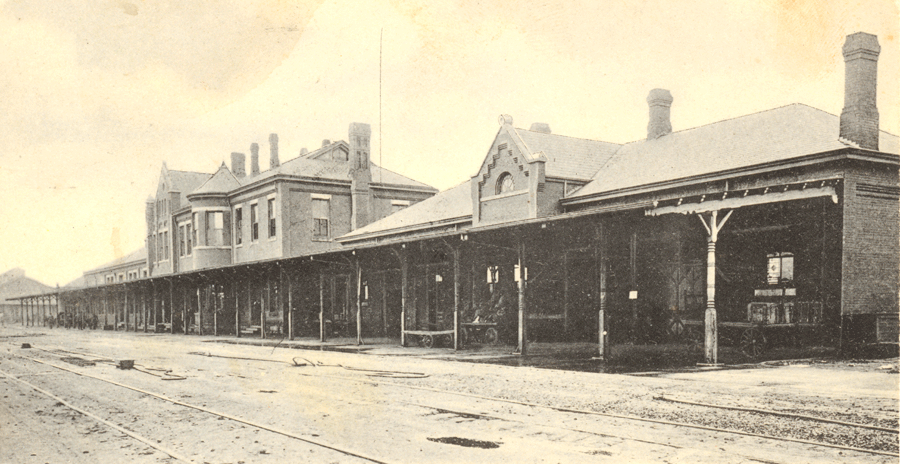
Texarkana's first Union Station (above) was torn down to make way for the present-day Union Station in Texarkana. Union Station faces Front Street, which parallels Broad Street in Texarkana.
(from the John Tennison Postcard Collection)
My grandfather, Alfred Tennison, Sr., told me that his uncle (his father's brother), Henry Booker Tennison (A.K.A. "Uncle Jack"), who traveled extensively on Texas railroads, jokingly referred to the Texas & Pacific Railroad as the "Tits and Pussy Railroad" because of the large numbers of brothels near T&P tracks, and because prostitutes (A.K.A. "Railroad Ladies") often hitched rides on the T&P. The high prevalence of prostitution in such places as Texarkana, Dallas, and Shreveport made "Tits and Pussy Railroad" a fitting name.
Jack Tennison coins "Tits and Pussy Railroad" as Humorous Name for the Texas and Pacific Railroad
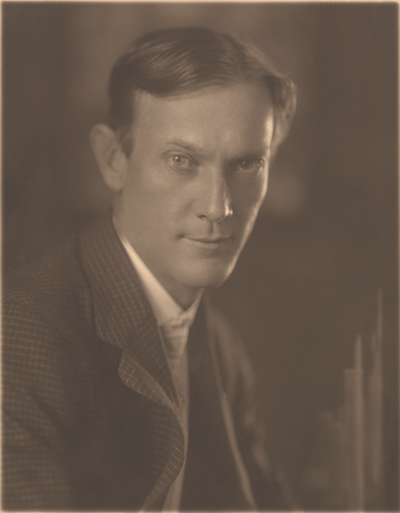
(photo from John Tennison Archives)
Inspired by Uncle Jack's humor, I decided to slightly modify his phrase by allowing the "A" of the "And" in "Texas And Pacific" to refer to "ass," thus deriving "Tits Ass Pussy Railroad." In doing so, this name takes into account the all the booty shaking that has figured so prominently in association with Boogie Woogie dancing and musical performance.
In the 1870s, and 1880s, the Texas & Pacific (T&P) was the railroad that precipitated the growth of Texarkana and Shreveport, while the International & Great Northern (I&GN) railroad precipitated the growth of Palestine. Both the T&P and the Houston & Texas Central caused the population of Dallas to skyrocket. Since Texarkana, Shreveport, and Palestine were deep within the piney woods, all three locales also had prominent lumber industries with associated lumber camps at which there was a demand for prostitution. These lumber camps usually built small railroads that connected to the larger lines, such as the T&P and the I&GN.
Beverly J. Rowe corroborates the geographical correlation
between the railroad and "dozens of barrooms, gambling halls, and brothels" in
Texarkana in the Foreword to her book "Women's Status in Texarkana, Texas in the
Progressive Era, 1880-1920,"34
when she writes on page iii of her Foreword:
"By the early 1870s this area was experiencing railroad
construction. In December of 1873 and January of 1874, the Texas and
Pacific Railroad began to sell town lots along Broad and Front Streets.
From 1873 to 1930, Texarkana experienced rapid growth fueled by a booming lumber
industry and the completion of nine railroad lines that made Texarkana the hub
of their systems extending north, south, east, and west of this point."34
and on page iv of Rowe's Foreword:
"At least as early as 1880, Texarkana had a red-light district called 'Swamppoodle.' Located on Broad and Front Streets initially, the district contained dozens of barrooms, gambling halls, and brothels."34 (Other sources use the spelling, "Swampoodle," with one "p.") Cultural historian, Mack McCormick, has clarified to me that "Poodle" was a slang term for the female genitalia. Moreover, in addition to being nestled in the Piney Woods of East Texas, Texarkana's location between the swampy Red River and swampy Sulphur River place Texarkana in the vicinity of substantial swamp lands. Historian, Beverly Rowe, has also told me that there was once a grandiose plan to dig a canal from Texarkana's Swampoodle Creek to the Sulphur River, so as to create an inland steamboat port in Texarkana. Although work on the canal commenced, the plan never materialized. This plan for a canal through the swamps and the slang meaning of "Poodle" indicate that "Swampoodle" can be taken as a very fitting description of the offerings of Texarkana's Red Light District.
Texarkana's Red Light District: Swampoodle
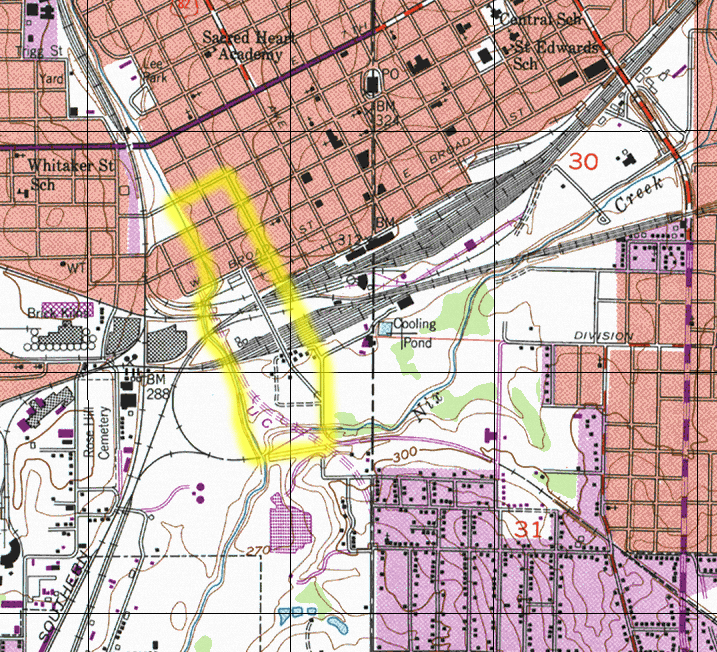
The yellow highlighted area above represents the approximate boundary containing locations of Texarkana brothels. Texarkana earliest brothels were directly beside the Texas and Pacific tracks on Front Street, and included madam Zolie Ray's brothel on Front Street. After being driven away from Front Street by puritanical Texarkana housewives, later brothel locations included 711, 712, 714, and 822 West Fourth Street. Thus, if one includes the earliest brothel locations with the later ones on 4th street, Texarkana's Red Light district, called "Swampoodle," was bounded on the west by Swampoodle Creek, and on the South by the Texas & Pacific tracks leading to Shreveport. This same Texas & Pacific track lead directly to Shreveport's Red Light District. (Copyright 2005 by John Tennison).
In his book, "This is Ragtime,"57 Terry Waldo confirms that secular venues existed at least as early as the 1880s in Texarkana where "low down" transient musicians performed:
"While still a youngster Joplin began actively to pursue a musical career. His talent attracted the attention of several local music teachers, who acquainted him with the classical music literature of the day, and it wasn't long before he was playing at various church functions and socials. But Joplin was also exploring the secular music of the Texarkana area. He visited and began playing at the various honky-tonks, clubs, and eating places where the 'low down' transient musicians were entertaining. And it wasn't long before Joplin was joining them."57
and
"While still a teenager he [Scott Joplin] organized the Texas Medley Quartet, which toured the Texas-Arkansas-Missouri area."57
Since Joplin organized his Texas Medley Quartet "while still a teenager,"57 the quartet would have been formed no later than 1887 (given Joplin's birth year of 1868). Moreover, Waldo's description indicates that Joplin's first performances at secular venues in Texarkana occurred at a still earlier date.
Joplin later settled in Sedalia, Missouri, which, like Texarkana, "....had a large red-light district, which could provide work and contact with the underground world of Negro folk music."57
![]()
Broad Street Looking East in Texarkana from a Postcard Dated June 7, 1906
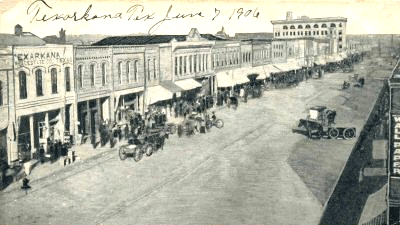
(from the John Tennison Postcard Collection)
![]()
In Texarkana, Front Street runs directly parallel to the tracks constructed by the Texas & Pacific. Broad Street (the main "downtown" street of Texarkana) is only one more street to the north from Front Street. Thus, the "dozens of barrooms, gambling halls, and brothels" of which Rowe writes could not have been any closer to the railroads. Moreover, these establishments were of a large enough scale to support regular Boogie Woogie and Ragtime piano players, including Scott Joplin. Consequently, Boogie Woogie and Ragtime were evolving as musical styles in Texarkana, Shreveport, and Palestine in the 1870s and the 1880s. As a reminder of Texarkana's historic Red Light District, there is still a Swampoodle Creek that runs along the east side of the KCS railroad tracks in Texarkana, Texas. (Depending on the source "Swampoodle" has been spelled with either one or two p's.) See the section on Leadbelly for a discussion of Shreveport's Red Light District, which also had a close association with the Texas & Pacific Railroad.
Why Boogie Woogie Is Unlikely to Have Originated in Turpentine Camps
Recall that in 1939, African American historian E. Simms Campbell wrote:
“Boogie Woogie piano playing originated in the lumber and turpentine camps of Texas and in the sporting houses of that state."
Also recall that Elliot Paul wrote the following on page 229 in 1957 (in Chapter 10 "Boogie Woogie ") in his book "That Crazy American Music":
"The first Negroes who played what is called boogie woogie, or house-rent music, and attracted attention in city slums where other Negroes held jam sessions, were from Texas. And all the Old-time Texans, black or white, are agreed that boogie piano players were first heard in the lumber and turpentine camps, where nobody was at home at all. The style dates from the early 1870s. Even before ragtime, with its characteristic syncopation and forward momentum, was picked up by whites in the North, boogie was a necessary factor in Negro existence wherever the struggle for an economic foothold had grouped the ex-slaves in segregated communities (mostly in water-front cities along the gulf, the Mississippi and its tributaries)."
Although there is very good reason to conclude that Boogie Woogie had its origin in logging and railroad-construction camps, there is also very good reason to conclude that Boogie Woogie did not have its origin in the camps where turpentine was being produced in the early 1870s. This is because such turpentine camps were only in the long-leaf Piney Woods of Southeast Texas, rather than being in the Piney-Woods logging camps of Northeast Texas, which, in the early 1870s, were already closely associated with a pre-existing railroad infrastructure, and with the construction of new railroad infrastructure. The opportunity for repetitive, sonic musical inspiration from the sound of multiple steam locomotives appears to not have existed in the turpentine camps of the early 1870s.
Not until the late 1870s does there appear to be railroad tracks laid in close proximity to where a turpentine camp might have existed. Two railroad companies were operating locomotives in proximity to where turpentine camps might have existed in the late 1870s. The first was the Houston East & West Texas Railroad, which had built track from Houston just over the Trinity River to southern Polk County (Goodrich) by 1879; and then to Moscow (in Central Polk County) by 1880. The other railroad company, which was much smaller, was the Yellow Bluff Tram Company in Jasper County. In 1878, The Yellow Bluff Tram Company began running a single locomotive on a short logging or "tram" road from Yellow Bluff on the Neches River to Buna (in Jasper County), where there was a logging camp. Perhaps inspired by knowledge of a steam locomotive having been brought by boat to Swanson's Landing on Caddo Lake in Harrison County about 20 years earlier, the single locomotive used by the Yellow Bluff Tram Company was transported by boat up the Neches River to Yellow Bluff where rails had been constructed to run in a south-easterly direction from Yellow Bluff towards Buna. Since this was a short, isolated railroad which was not connected with any other railroad infrastructure, logs cut along this line were dumped into the Neches River at Yellow Bluff and floated to Beaumont, Texas, for further processing in saw mills, and then distributed by rail and boat from Beaumont to other destinations.
The largest-scale turpentine production in close association with railroad infrastructure did not occur in Southeast Texas until after 1900. Moreover, the Southeastern counties of Texas where this turpentine production occurred had an African American population that was dwarfed by that of Harrison County throughout the 1800s and continuing on at least through 1960.
Thus, the claim that Boogie Woogie "originated," was "created" or "came from" turpentine camps is inconsistent with the above data, and with the fact that the numerous oral histories cited by Elliot Paul indicate the creation of Boogie Woogie in the early 1870s.
Other evidence that supports a Northeast Texas origin for Boogie Woogie comes from the fact that the earliest eyewitness accounts of the performance of Boogie Woogie in Texas or near Texas occur in in the area of the Arklatex, which includes Northeast, not Southeast Texas.
The Piney Woods of East Texas
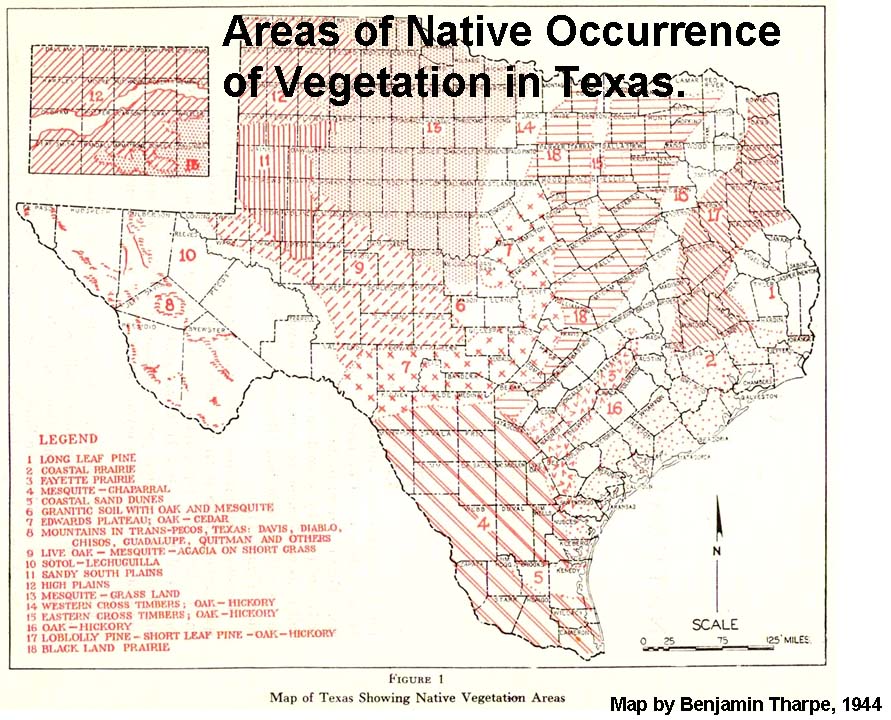
As can be seen in the legend above showing locations of native occurrence of Vegetation in Texas, Area 1 contained Long Leaf Pine, which is the source of turpentine. Area 17 contained Loblolly Pine, Short Leaf Pine (neither of which is typically used for turpentine production), as well as Oak and Hickory.
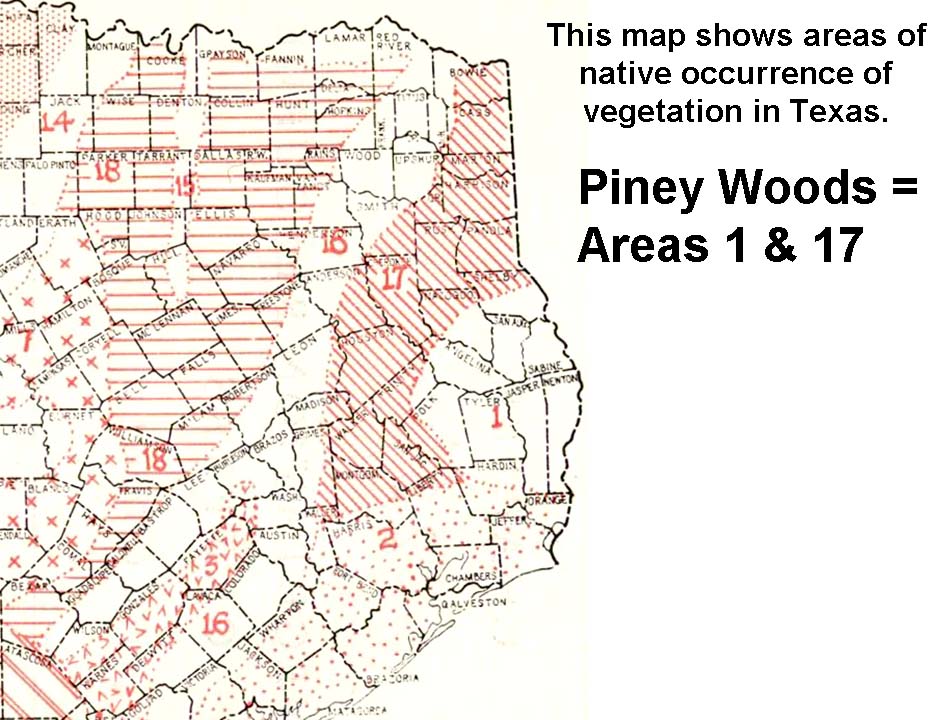
Above is a detail of Benjamin Tharpe's 1944 map, which shows the areas of native occurrence of vegetation in Texas. Areas 1 and 17 are the parts of Texas typically known as "The Piney Woods" of East Texas. As can be seen in the map above, there were 11 Texas Counties with significant Long Leaf Pine forests.
Nonetheless, it does appear that Boogie Woogie continued to undergo significant development in the turpentine camps that were established after 1900 in the Texas and Louisiana counties located in the long-leaf pine forests of Southeast Texas and Southwestern Louisiana. Consequently, based on Campbell's comment, a useful exercise would be to determine the earliest known instances of lumber camps, turpentine camps, and sporting houses in East Texas. Although lumber camps were fairly evenly distributed from north to south in the Piney Woods of East Texas, turpentine production would have been more prominent in the Southern part of the Piney Woods of East Texas because the Longleaf pine species is more common in the Southern part of the Piney Woods of East Texas. So if we were to consider ONLY turpentine production, it would seem make sense to conduct research in the southern half of the Piney Woods of East Texas. Yet, to consider only turpentine production would be to ignore the other earlier correlates of Boogie Woogie that point towards a Northeast Texas origin.
The other potentially important qualifying word in Campbell's account is "camps." Obviously, there could have been small turpentine production operations that did not involve "camps." However, without a sufficient size of operation, there would have been less pressure on owners of such camps to bring pianos for the musical entertainment of a small work force. Consequently, itinerant musicians would have been more likely to have frequented camps with enough critical mass of workers, and would have been more likely to have frequented camps with connections to other camps by way of a rail system.
After searching for references to turpentine production in pre-1900 Texas, the Texas Almanac from 1867 (published by The Galveston News) proved to have some useful information.
In the section on Hardin County (p. 122), the 1867 Texas Almanac states: "We have one turpentine manufactory, and tar is also an article of trade. Our pine and other timber is inexhaustible, and will constitute an important article of trade when our facilities of transportation are improved."
In the section on Trinity County (p. 163), the 1867 Texas Almanac states: "One turpentine manufactory was started during the war; and several steam grist and saw-mills are already in successful operation, and are rapidly making fortunes for their owners." The most likely location of this "turpentine manufactory" was Sebastopol, which was on the Trinity River, downstream from what would later become "Trinity Station" when the International Railroad arrived in Trinity County in 1872.
Another historical account by Bob Bowman indicates the presence of turpentine distilleries in the towns of "Bold Springs" and "Patonia" (in Polk County) on the Trinity River downstream from where Sebastopol was located in Trinity County. Because of the locations of the Polk County turpentine distilleries, they would have been less likely than Sebastopol to have had interaction with a railroad in the early 1870s, specifically the International Railroad at Trinity Station. Not until the Houston East & West Texas Railroad built to Polk County from Houston in the late 1870s would the turpentine distilleries of "Bold Springs" and "Patonia" have been as close to significant railroad infrastructure as was the turpentine distillery at Sebastopol as of 1872.
Trinity Station: The Closest Railroad to East-Texas Turpentine Camps in the Early 1870s
To the extent that turpentine was still in production in Trinity County in 1873, turpentine camps in Trinity County that supported such operations would have seemingly been in closer proximity to those travelling on the Texas & Pacific railroad tracks, as compared to turpentine camps in any of the other 10 counties in Texas with significant Long Leaf Pine forests. This likelihood of this proximity was due to the fact that the "International Railroad" had completed its line between Longview (on the T&P line) and Houston in 1873. The completion of this line occurred in 1873 when tracks that had been built southward from Longview (on the T&P line) met up with tracks in Palestine that had been built northward from Houston. Upon completion of this line, the very first north-south railroad network in East Texas from Texarkana to Houston was established. (From Texarkana to Longview, the tracks were those of the Texas & Pacific, and then from Longview to Houston, the tracks were those of the International Railroad.) With the exception of the area in north Harris County and south Montgomery County, all of this north-south route was contained completely within the Piney Woods of East Texas.
Before reaching the southward-going tracks at Palestine to the north, the International Railroad line had created "Trinity Station" when it built through far western Trinity County in 1872. However, most of Trinity County (see map above) is not composed of Long Leaf Pines. I have not found any records to indicated that turpentine camps in Trinity County in the early 1870s had a rail connection to Trinity Station. Thus travel to turpentine camps from Trinity Station in the early 1870s would have been over land and not by rail. However, the Trinity & Sabine Railroad (established in 1881), built from Trinity (previously "Trinity Station") eastward 38 miles ("Milepost 38") by 1882. Then, the Trinity & Sabine Railroad was absorbed by the Missouri, Kansas & Texas Railroad in 1882. By 1884 the track running eastward from Trinity had been extended from Milepost 38 to Colmesneil (in northern Tyler County). Thus, this eastward-going track from Trinity made possible direct rail travel into the heart of the Long Leaf Pine forests from Trinity. Thus, a railroad network was created where iterant musicians could travel eastward directly by rail from Trinity into close proximity of any turpentine camps that were near that eastward running line.
It should be noted that the word "manufactory" implies an area where distillation of turpentine was taking place, but not necessarily the same location where a turpentine "camp" was located.
In the section on Tyler County (p. 165), the 1867 Texas Almanac states: "The lumber and turpentine business would prove lucrative here." Note that this sentence does not state that turpentine production or camps already existed in Tyler County.
In the section on Jefferson County (p. 165), the 1867 Texas Almanac states: "The exports before the war were about as 4 to 1 since. There have been exported during the year ending August 31st, 1866, cotton, 6500 bales; cattle, 4760 head; rosin, 855 bbls.; spirits turpentine, 100 bbls.; beef hides, 10,000; lumber, 3,000,000 feet; shingles, 1,040,000." Note that this sentence does not state that turpentine specifically was one fourth that of pre-war production, but rather, than overall "exports" were one fourth the amount of pre-war "exports."
In her article (which uses the 1867 Texas Almanac as a reference) on Jefferson County (located in the Southeast corner of Texas), Diana J. Kleiner indicates that there was some turpentine production in Texas prior to the Civil War when she writes the following about the effects of the Civil War on Jefferson County:
"After the war the county population declined to 1,906 by 1870. Although African Americans held a few government offices and blacks and whites were both politically active as voters during the federal election of 1888, blacks were all but totally disfranchised in the federal election of 1892. Recovery from the war was slow. Jefferson County exports in 1867 of cotton, cattle, beef hides, lumber, cypress shingles, and lumber products including resin and turpentine constituted only about one-fourth of their prewar total [appears to be citing the 1867 Texas Almanac]. Sugar production between 1860 and 1880 was limited, and significant agriculture did not develop again until after 1890. By 1876, however, the county was once again a lumber and shipping center, as loggers used the Neches and Sabine rivers to float logs to mills at Orange and Beaumont, where mills manufactured 82,000,000 shingles and 75,000,000 board feet of timber by 1880. Exports, including pine for cross-ties and bridges, made these towns major lumber centers by 1900."
Since current-day Orange County, Texas, was carved from Jefferson County on January 5, 1852, some of the pre-Civil-War production of turpentine attributed to Jefferson County could have been occurring in what is present-day Orange County, Texas. Whether or not turpentine camps in Jefferson County or Orange County contained piano players in the 1860s is uncertain. If anyone knows of any evidence of piano performances at turpentine camps in Southeast Texas prior to 1900, I would love to hear from you at nonjohn@yahoo.com.
Since the largest-scale turpentine camps in Texas occurred after 1900, and since Boogie Woogie appears to have its origin in the early 1870s, I inquired with Bob Bowman about pre-1900 turpentine camps. Bowman wrote the following back to me on July 26, 2005:
"There isn't a lot of history about turpentine camps; I don't think I've ever seen a complete list of the old camps, and I am nearly 70 years old."
and
"Some of the lumber companies were in business in the early 1880s, and those in the longleaf pine forests usually operated turpentine camps before they starting cutting the trees."
Based on this information from Bob Bowman, we could infer the existence of pre-1900 turpentine camps in proximity to, but not necessarily in the exact same locations to wherever longleaf Pine lumber camps existed. Turpentiners first drained longleaf pines of resin from which turpentine was distilled, and then later, loggers moved in to cut the trees down. Since virgin longleaf pines were fairly evenly distributed within the longleaf pine forests, since resin from longleaf pines and felled pines were transported convergently to the camps, present-day areas of smaller-diameter, new-growth longleaf pines, or areas of less density of trees among areas of greater density could potentially be used to predict approximate locations of previously-undocumented turpentine or logging camps. However, given the extensive clear-cutting that has occurred, such an approach might yield highly imprecise results, if at all. With a high-enough resolution, early aerial photos might also be useful in such an inquiry.
Turpentine Camps Were Dangerous Environments
East Texas historian, Bob Bowman provides evidence of dangerous environments at Texas turpentine camps in his book, The 35 Best Ghost Towns In East Texas and 220 Other Towns We Left Behind.39 In the chapter of his book titled, "Turpentine," (page 53-56) Bowman discusses turpentine camps in southeast Texas, with specific emphasis on the turpentine camp established in 1907 and named "Turpentine." Turpentine was located about 20 northwest of Jasper, Texas. In this chapter, Bowman writes about the comments from 1973 by Chester Norris of Broaddus, Texas. Bowman indicates that Norris was a prior turpentine camp boss. Bowman writes the following (Norris' comments in red)39 (page 54):
'They'd kill each other...one or two every Saturday night. If they didn't have gambling and a barrel house to get drunk in, they'd move on to camps where they did have 'em.'
"Norris, whose father was also a turpentiner, remembered that he and others
'had to patrol the camps on Saturday nights, breaking up
fights, trying to keep them from killing each other.'"
"Norris said the outside law 'didn't
pay us any mind...it was turpentine law and we took care of our own camps.'"
"Norris remembered a camp incident when a worker who kept his
money tied around his leg got drunk and fell asleep in a house used to store
wooden barrels). 'A fellow came in with a razer-sharp
apron knife. He chopped off the man's leg at the knee, grabbed the leg and
left.'"
"Another incident occurred, according to Norris, when a
worker named Molasses was shooting craps with several other turpentiners.
'A man came in with a gun to shoot another fellow in the game, but Molasses was
between the two. The fellow with the gun hollered at Molasses to duck, but
he didn't. The bullet went in Molasses' forehead and slid around under the
skin and came out behind his ear. Molasses wrapped his head in a red
handkerchief and went right on shooting craps.'"39
Boogie Woogie Evolved in Dangerous Environments
In addition to the dangerous environments discussed in the section on turpentine camps above, and in 1920s Chicago, Victoria Spivey corroborates other comparably dangerous environments in which early Boogie Woogie evolved:
"In fact, I was there in his house [Joe Pullum's house] in the bloody 5th Ward of Houston, Texas when Joe was making up the words...The Ma Grinder -- these were fighting words that often lead to blood-shed and death."45
The frozen smiles on the faces of some interpreters of Boogie Woogie (who performed on television and in the movies in the 1940s and afterward) created a sterilized, non-threatening visual presentation whereby white audiences could appreciate Boogie Woogie. Although many performers, such as Liberace and Jo Anne Castle (of the Lawrence Welk Show), were technically very proficient at playing Boogie Woogie and other styles, their perpetually-happy faces, and de-sexualized lyrics (when lyrics were present), belied the dangerous environments in which Boogie Woogie evolved. Like much of Blues music, the creation of Boogie Woogie was associated with substantial pain and suffering.
The Maverick Eastward Construction of the Texas & Pacific Railroad, Ferriday, LA, & Jerry Lee Lewis
Unlike other railroads that had been chartered by Congress to build
to the west coast, the Texas & Pacific, while originally chartered in 1870 to build westward to
San Diego, California, ended up building significant portions of its tracks eastward into
Louisiana. In doing so, the Texas & Pacific became a maverick railroad that spread its influences "upstream" in the eastward
direction against the net westward flow of human population migration.
Despite its original charter, the Texas & Pacific never built west of Sierra
Blanca (just east of El Paso, TX). Had it fulfilled its original charter,
Boogie Woogie as we know it today might never have come to be.
Thus, Boogie Woogie came to Louisiana, not from an eastward direction (as had
many other cultural influences), but rather from a westward direction, developing along wherever the Texas &
Pacific built its tracks.
Of course, New Orleans is the largest city in Louisiana to which the Texas & Pacific
spread its Boogie Woogie. However, another striking and important example is the smaller
town of Ferriday, LA. Ferriday is about 5 miles west of the Mississippi River
in Concordia Parish, which borders the western shore of the Mississippi River.
The Texas & Pacific built more track miles in Concordia Parish than any other
railroad company. Moreover, like Texarkana, if it had not been for the Texas & Pacific, Ferriday would probably have never
become a municipality at such an early date, or perhaps not at all.
According to the official website of the town of
Ferriday (courtesy of the
Concordia Sentinel)
"The Texas and Pacific Railroad and the Memphis, Helena and Louisiana Railroad (later Missouri Pacific) set up their workshops in 1903 and 1904.
They asked the Realty Investment Company to survey the land for a town, and this survey was begun in 1903."
and
"A boxcar was placed at a convenient place within the town limits for a depot, and a Mr. Young was appointed depot agent.
A Mr. Harper, employed by the Texas and Pacific as an engineer, built the first house in town."
The presence of the railroad in Ferriday brought railroad laborers, barrelhouses, prostitutes,
and Boogie Woogie. In 1910, the African American population of
Concordia Parish was greater than 75% (See map below.). The influences of the Boogie Woogie style persisted in the Ferriday African American population and came
to be well-represented in a prominent barrelhouse, Haney's Big House. Haney's Big House was "across the tracks" in the so-called "chocolate
quarter" of Ferriday. Haney's Big House was in operation at the time that young
Jerry Lee Lewis (born September 29, 1935) was growing up. Lewis has indicated that the Boogie Woogie musicians he heard
while peeking into Haney's were very
inspirational to him. Thus, the Texas & Pacific Railroad had a role in
bringing Boogie Woogie to Ferriday, which in turn, inspired Jerry Lee Lewis, one of the best-known early
Caucasian exponents of Boogie Woogie.
The significance that the Texas & Pacific Railroad once placed on Ferriday
can be seen in the October 1927 T&P map in this article, in which the town
of Ferriday is printed in all-caps font as large as that used for Texarkana and
Shreveport. However, the T&P map from July 1958 lacks a T&P line
to Ferriday, revealing an abandonment of T&P's ambitions for Ferriday. Although the Texas & Pacific Railroad
originally had high hopes for Ferriday to become a significant
East-Central Louisiana hub, the Texas & Pacific (perhaps because of flooding from the Mississippi?) abandoned its tracks in Concordia Parish, but the Boogie Woogie never went away!
By virtue of its inroads into the Mississippi Delta region in Concordia Parish (only 5 miles from Mississippi), the Texas & Pacific Railroad probably exported musical styles other than just Boogie Woogie. For example, B. B. King (born September 16, 1925) has cited Texan T-Bone Walker, the first electric bluesman, (born in Linden northeast Texas in 1910 to Rance and Movelia Walker) as being one of his significant early influences. Thus, this is still another example of a west-to-east influence that ran counter to the population expansion and other influences that were running from east to west.
Other Railroads That Contributed to the Spread of Boogie Woogie in Texas
Besides the Texas & Pacific, other early Texas railways that contributed to the spread of Boogie Woogie included the International and Great Northern (IGN), the Texas and St. Louis Railway (A.K.A. the "Cotton Belt", and later renamed "St. Louis and Southwestern," despite not having originated in St. Louis), the Texarkana and Northern (a tap-line off of the Texas & Pacific, and the earliest-constructed tracks of what later became the Kansas City Southern main line), the Texarkana, Shreveport, and Natchez Railroad (also originally a tap-line from the Texas & Pacific, and later absorbed into the Texas & Pacific), the Houston, East & West Texas (HE&WT) Railway, the Gulf, Colorado, and Santa Fe (not originally part of the Santa Fe originating in Kansas). The International & Great Northern Railway connected Longview to Houston by way of Palestine. Longview was on the Texas & Pacific route between Marshall and Dallas. The Houston, East & West Texas Railway connected Houston to Shreveport. From Shreveport, Texas and Pacific lines in led to Texarkana, New Orleans, and Marshall.
In my upcoming book, I will discuss specific Boogie Woogie styles that have been reported to have been developed in association with nearby logging and construction of these specific railways.
According to the Texas Handbook of History in its article on the Kansas-based "ATCHISON, TOPEKA AND SANTA FE RAILWAY SYSTEM" (A.K.A. "Santa Fe"):
"The GC&SF had been formed in 1873 by leading citizens of Galveston to build a line around Houston toward the northern and northwestern portions of the state. Aided by a grant of state lands, the company slowly constructed lines from Galveston to Lampasas, Fort Worth, and Dallas, with branches to Houston and Conroe."53
In the 1886 the Santa Fe Railroad arranged to acquire the Gulf, Colorado and Santa Fe Railway. Prior to this time the Santa Fe possessed no tracks within the Piney Woods of East Texas. Prior to the Santa Fe's acquisition of the Gulf, Colorado, and Santa Fe Railway, itinerant Boogie Woogie players had used the Gulf, Colorado, and Santa Fe Railway. Thus, even prior to the 1886 acquisition, there was an association between the term, "Santa Fe" and piano as played in East Texas Barrelhouses (See "Santa Fe" Group below).
After 1887, the track of the GC&SF (while still operating as a subsidiary of the Kansas-based Santa Fe) was extended east and north to Beaumont and Longview and northwest to Brownwood.53
The track from Beaumont to Longview absorbed the track between Carthage and Longview that previously had connected only to the Texas & Pacific at Longview.
Thus, the International & Great Northern, the Houston, East & West Texas Railway and the Gulf, Colorado, and Santa Fe Railway (while still operating as a subsidiary of the Kansas-based Santa Fe) possessed tracks that ran in three north-south cooridors through the Piney Woods of East Texas prior to 1900. GC&SF was the eastern-most, the HEWT ran in the middle, and the IGN was the western-most. The Houston & Texas Central was still west of the IGN, and was important because it was the railroad track that brought Blind Lemon Jefferson to Deep Ellum, where he met Lead Belly, who had arrived by the Texas & Pacific from Marshall. Because the HTC intersected the Texas & Pacific in Deep Ellum, an important railroad intersection was created that caused the population of Dallas to skyrocket, and which caused Deep Ellum to become a crossroads for the performance of Boogie Woogie, Blues, and other Texas music.
The "Santa Fe Group" is a Misleading Term
The Santa Fe Railroad in Texas was used by itinerant Boogie Woogie musicians. However, the tracks associated with the Santa Fe that were first used by Boogie Woogie players were originally not part of the Santa Fe system, but were instead part of the Gulf, Colorado, and Santa Fe Railway. Moreover, the group of 20th-century Texas Boogie Woogie Players known as the Santa Fe Group (including Robert Shaw) did not restrict their performances to locations served only the Santa Fe Railroad. Sometimes the Santa Fe Group simply used the "Santa Fe" label as a simple answer to anyone who asked them the name of the improvised piano music they were playing at the moment. Another evidence of travels to locations other than those served by the Santa Fe Railroad comes from the piece, "Hattie Green," one of the best known pieces of Robert "Fud" Shaw (A.K.A. "the Ma Grinder" and a member of the Santa Fe Group). The piece was named after Hattie Green, a woman in Houston's 1st Ward who Victoria Spivey said "had a 'meeting house' where all the races could get together."45
In his piece, "Hattie Green" Shaw's lyrics state that he is going to Abilene, Texas, a town that was served by the Texas & Pacific Railroad, not the Santa Fe Railroad. Although these lyrics do not prove that Shaw performed in Abilene, he most likely did travel through Abilene, as Chris Strachwitz comments in 1992 (CD Liner Notes from "Texas Barrelhouse Piano," by Robert Shaw, First released on LP in 1963 by Arhoolie Records), Shaw performed his barrelhouse style at various Texas locations, in Oklahoma, and in Kansas City. Robert Shaw was born in 1908.
The Houston, East & West Texas Railway
The Houston, East & West Texas Railway completed its route from Houston to Shreveport by 1886. This narrow-gauge railroad route was significant in that it cut through previously undeveloped areas of the Piney Woods of East Texas. At the Texas-Louisiana state boundary the 191-mile HE&WT connected with the affiliated forty-mile Shreveport and Houston Railway Company in De Soto Parish, forming a through line between Houston and Shreveport.
The creation of the HE&WT created the need for railroad construction camps and spawned lumber camps with tracks that fed into the main HE&WT line. Moreover, the HE&WT pretty much created a longitudinal bisection of the Piney Woods of East Texas, and runs parallel to much of modern-day Highway 59 between Houston and Shreveport. Although the Thomas family probably did not take the HE&WT to first travel to Houston, performances of Boogie Woogie were probably occurring along the HE&WT route before 1900.
By connecting with the Shreveport and Houston Railway Company, which ran through De Soto Parish to Shreveport, the Houston, East & West Texas Railway established a direct link to the Texas & Pacific Railway.
Because of the mismatch resulting from its narrow gauge tracks, the Houston, East & West Texas Railway later rebuilt its tracks to standard gauge so that the transition onto and from the tracks of other railroad companies would be more seamless. This re-gauging started resulted in the continued need for railroad camps along the HE&WT line, places where Boogie Woogie could be played.
According to "Whistle in the Piney Woods: Paul Bremond and the Houston, East and West Railway", 1999, by Robert S. Maxwell, states the following:
"From its beginning in 1875, the Houston, East and West Texas Railway was Paul Bremond’s individualistic and personal enterprise. Many of the railroads in the country were built by local people of limited means and experience. Small independent companies, without significant financial resources and without affiliation with the large trunk lines, frequently sought to build into isolated rural areas, to open new sections to commercial opportunity, and to link inland towns with the larger port cities. Such a man was Paul Bremond, who built his railroad through the Piney Woods of East Texas and opened that region to the outside world."
and
"Whistle in the Piney Woods is the story of the railroad’s symbiotic relationship with the lumber industry and its role in the development of East Texas. The man and his railroad provide a significant case study of the development of short lines in the United States. The story is a worthy addition to the history of American railroads as well as to the history of the East Texas region."
Texas and Pacific Locomotive #610: The Freedom Train

The locomotive with the above wheel configuration (2-10-4) came to be officially designated as a "Texas Class" because the Texas and Pacific Railway company was the first to order this design as a production model from the Lima company in Ohio. This particular locomotive (#610) is on display at Palestine, Texas. Moreover, this locomotive pulled the "Freedom Train" in 1976 to celebrate the bicentennial anniversary of the formation of the United States. As Boogie Woogie, and more generally Jazz, are about "freedom" and not being constrained by musical rules or conventions of the past, and since these musical forms were developed by African Americans recently freed from slavery, "Freedom Train" is an exemplary name. Let Freedom Ring!
October 1897 Map of the Texas & Pacific Railroad
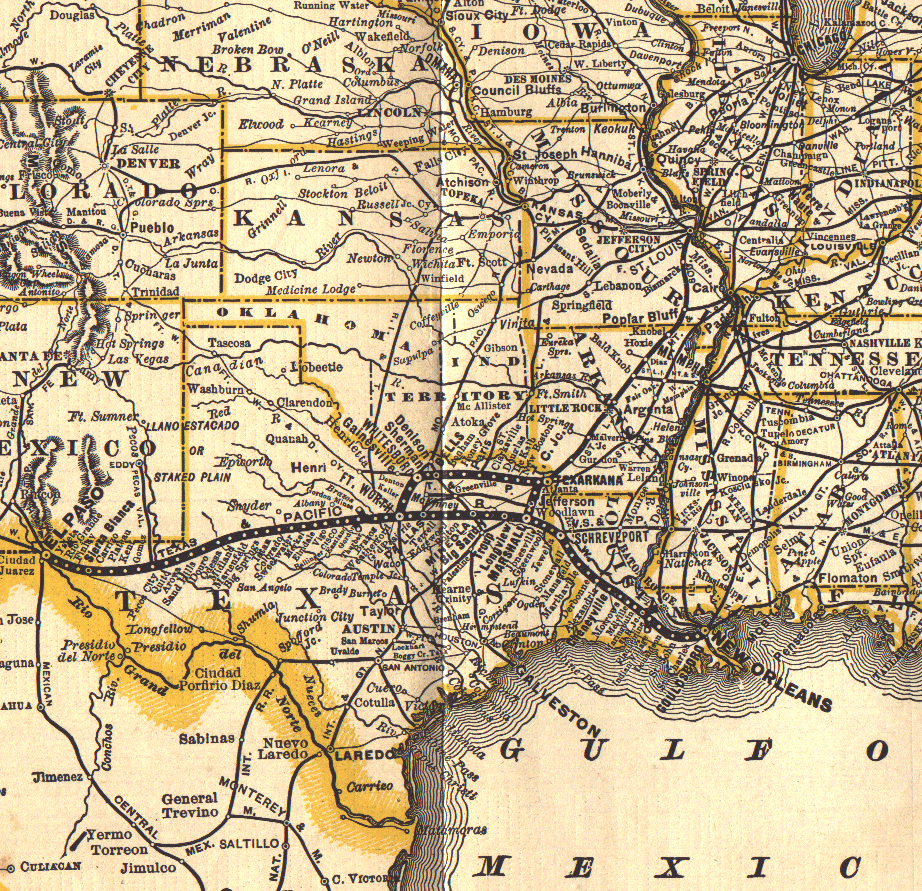
The above map was produced in October of 1897 by the Texas and Pacific (T & P) Railroad. The T&P Railroad lines in Eastern Texas, which spread into Louisiana parallel areas where early eyewitness account of Boogie Woogie were reported. These routes were more historically important than the West Texas T&P routes because the greatest absolute number and greatest percentage of African Americans lived in the northeastern part of Texas (Harrison and Marion Counties in particular). Moreover, the logging communities around which Boogie Woogie was also said to have been invented were predominantly in the eastern "Piney Woods" region of Texas.
Moreover, Scott Joplin was born in Northeast Texas somewhere between Texarkana and Marshall, and thus in the proximity of Marshall (T&P headquarters), Texarkana (where Joplin would move and take his first piano lessons), and Shreveport (a Louisiana town near Mooringsport, the possible birthplace of Blues man Leadbelly.) Moreover, Scott Joplin's family (including father Giles and mother Florence (maiden name Givins) Joplin) moved to Texarkana so Jiles Joplin could take a job as railroad laborer for the Texas & Pacific Railroad. The Texas & Pacific Railroad was likely involved in transporting the Joplin family to Texarkana. If he was not already aware of it, Giles Joplin's work with the railroad in Texarkana would have no doubt familiarized him with the opportunities available for itinerant African American musicians using the Texas & Pacific lines. As he is known to have been a caring father figure, Giles would have likely conveyed this knowledge to Scott early on. Scott Joplin began performing in the Texarkana area as a teenager. Scott is believed to have supported himself as an itinerant pianist working at bars and brothels in such places as Texarkana, St. Louis, Memphis and Dallas. Assuming Scott followed the predominant practices of the day, he would have used the Texas & Pacific, and Missouri & Pacific Lines to transport him to these locales.
Leadbelly has acknowledged using the Texas & Pacific to get him and Blind Lemon Jefferson to and from Dallas. As a result, Leadbelly's migratory pathway not only took him through Marshall, Texas, but Leadbelly continued to use the T&P Railroad as a means of transportation after arriving in Dallas. Even before taking the railroad from Marshall to Dallas, he would have almost certainly have been exposed to music in Marshall because his family lived in Leigh, Texas, which is in the eastern part of Harrison County, of which Marshall is the county seat.
Moreover, George Washington Thomas, Jr., who published the first Boogie Woogie sheet music in 1916, was born in Little Rock, Arkansas in 1883 and made his way (with his parents Fanny and George W. Thomas, Sr.) to Houston, Texas, where in 1911, he was noted to be publicly performing what was unmistakably Boogie Woogie in his "Hop Scop Blues." After moving from Houston to New Orleans, he renamed this piece "New Orleans Hop Scop Blues," which is the title under which it was published in 1916 and under which it was recorded in 1923. The Thomas family migration might have occurred over a number of years, and with limited transportation options, the T & P railroad lines would have been most likely been involved in transporting the Thomas family to Houston. If so, George W. Thomas, Jr. would have had the chance to be exposed to music that was being played in proximity to the railroad lines. Most importantly, the Thomas family's north-to-south migratory pathway would have crossed Leadbelly's east-to-west migratory pathway at Marshall (County Seat of Harrison County), which had the highest concentration of African Americans in Texas at that time. This correspondence suggests that, more than any other municipality, Marshall was the most likely candidate where Leadbelly and George W. Thomas, Jr. heard early Boogie Woogie. Of course, I am not trying to suggest that Boogie Woogie was only played within the city limits of Marshall. Rather, it is helpful to think of Marshall as a locus around which concentrated Boogie Woogie activity was occurring.
(Interestingly, determining the Marshall correspondence from analyzing Leadbelly's and the Thomas's crossed migratory pathways is analogous to the way P.E.T. scanners calculate the location of metabolic activity when imaging the human brain!! As a physician researcher, I used to inject the radioisotopes that would then emit gamma radiation while in the brain. The location of the brain's metabolic activity could be deduced by determining where lines of emitted gamma radiation crossed each other!!)
Texas & Pacific Map from November 27, 1927
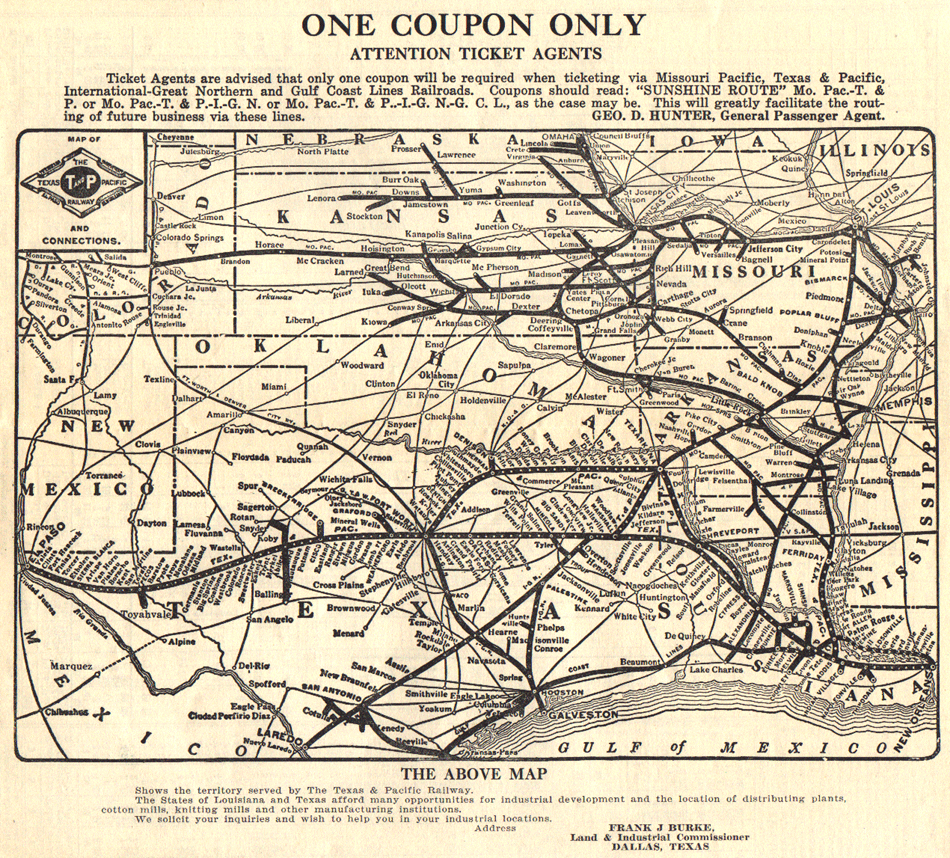
As can be seen from the map above, the Texas & Pacific established a track between Texarkana and Shreveport. This line did not exist as of October of 1997. It has since been removed. This section of T&P track was the only section to traverse any part of Arkansas. Highway 71 parallels this abandoned T&P route and is a beautiful drive still today. The little towns that dot Highway 71 remain mysterious and enchanting. The drive will take you through Fouke, Arkanasas, the locale for a regional legend about a monster (similar to Big Foot) that is said to live in the woods, and about whom the movie, "The Legend of Boggy Creek" was made. My cousin, James Tennison, played the "landlord" in this movie. I regard the Texarkana, Marshall, and Shreveport as being the corners of what I call "The Boogie Woogie Triangle."
July 1958 Map of the Texas & Pacific Railroad

As can be seen from this July 1958 map, the T&P routes reveal a withdrawal from its presence in Ferriday, Louisiana, where it had first set up shop in 1903. Ferriday later spawned Jerry Lee Lewis.
A Modern Map of Texas Railways
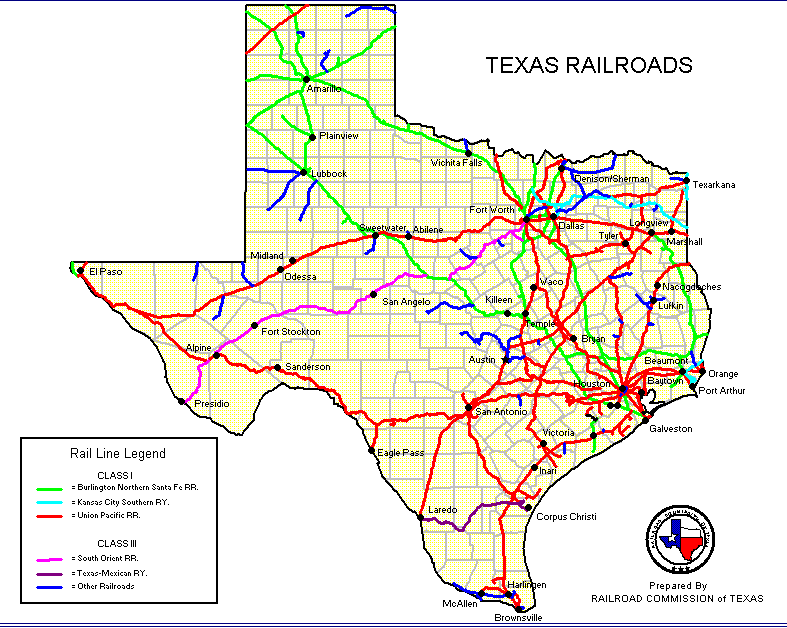
Above is a modern map of the railroads of Texas. The red lines in the eastern part of the state (now owned by Union Pacific RR) were once part of the original Texas and Pacific (T &P) lines. If you compare this map to the 1873 T & P above it, you can see which of the red lines above were part of the T & P lines.
Steam Locomotives Sound Like Boogie Woogie

Pictured above is the 1912 Texas & Pacific Station in Marshall, Texas. The structure now houses a Texas & Pacific Museum.
The identification of the sound Boogie Woogie with the sound of steam locomotives has been recognized over and over by music historians.
On the South Bank Show Video documentary on Boogie Woogie from 1986, historian Paul Oliver commented:
"Boogie Woogie means a great deal to me. It seems to have been with me all of my life. When I was a boy in the early years of the war, I was living in Harrow District, and used to catch the train every day to and from school, and at that time, Boogie Woogie was the music that all of us were listening to and attempting to play. On this station in those days, the London Northeastern Railway trains used to come through a few times a day, and that was the one I always like to catch. I used to catch the 'steams,' we called it. The reason why I liked it is basically because the rhythms of the train going over the points just sounded like Boogie Woogie to me. Boogie Woogie and train music always seemed to go together. I remember some of the records we bought at that time -- records like "Streamline Train" by Cripple Clarence Lofton, and "Honky Tonk Train Blues," which is by Meade Lux Lewis."
Indeed the chugging, choo-choo sound of steam locomotives sounds very similar to the pulse of Boogie Woogie, the back beat of Rock and Roll, and sounds associated with human sexual intercourse, such as breathing, heartbeats, and bodies slapping together. Moreover, I have heard at least one story from the son of a Texas & Pacific employee who himself used to work for Texas railroads, who told me that children would run along and literally dance to the sound of the Texas & Pacific steam locomotives as they accelerated. This dancing with a steam locomotive is understandable, in that it produces the same underlying pulse that makes people want to move or dance to Boogie Woogie.
Boogie Woogie artist Axel Zwingenberger's web page mentions "Rolling bass figures, the dynamics of a roaring steam train."
John Tennison and Axel Zwingenberger at Axel's Bosendorfer Grand Piano in Vienna, Austria, April, 2006
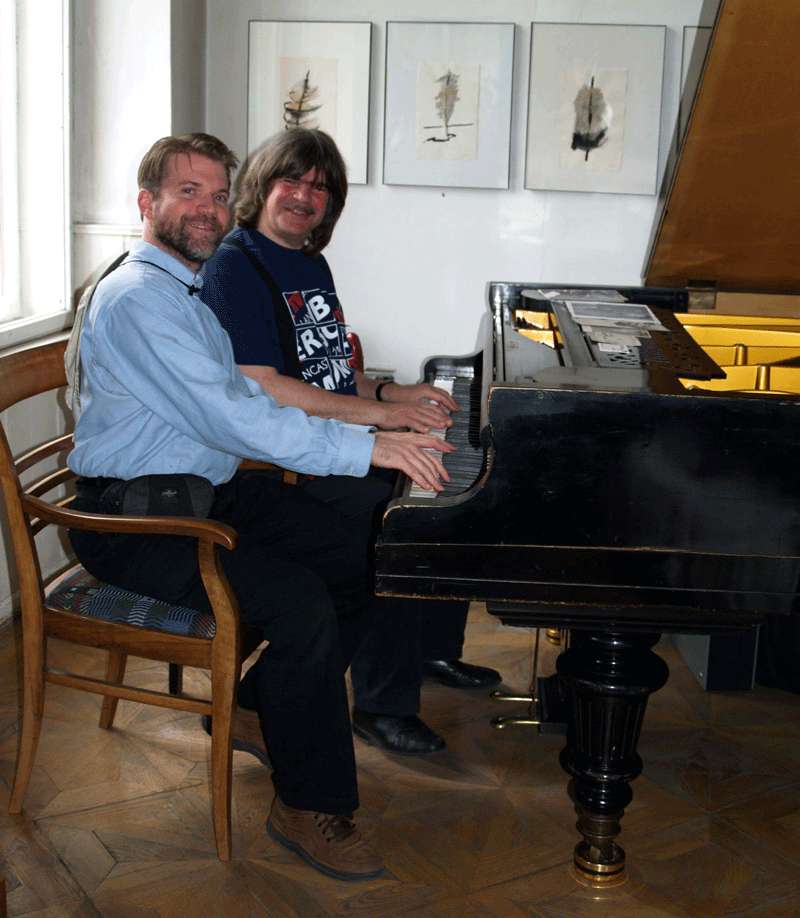
Axel Zwingenberger is among the most influential and prolific of the European performers, composers, and scholars of Boogie Woogie. Zwingenberger has inspired new generations of Boogie Woogie players all over the world, such as in Japan where Boogie Woogie pianist Keito Saito (born in 1978) specifically cites Axel Zwingenberger as an inspiration in the liner notes to Saito's 2008 album, Boogie Woogie Far East.
A Humorous Texas and Pacific Railway Advertisement
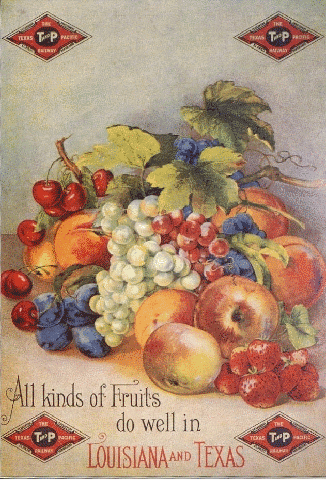
I include this old advertisement from Texas and Pacific Railroad here because I am amused by its unintended humor. Given the eccentric traits of some Texas and Louisiana musicians, this advertisement is prophetic.
African Americans in Texas, Louisiana, and Arkansas in 1910
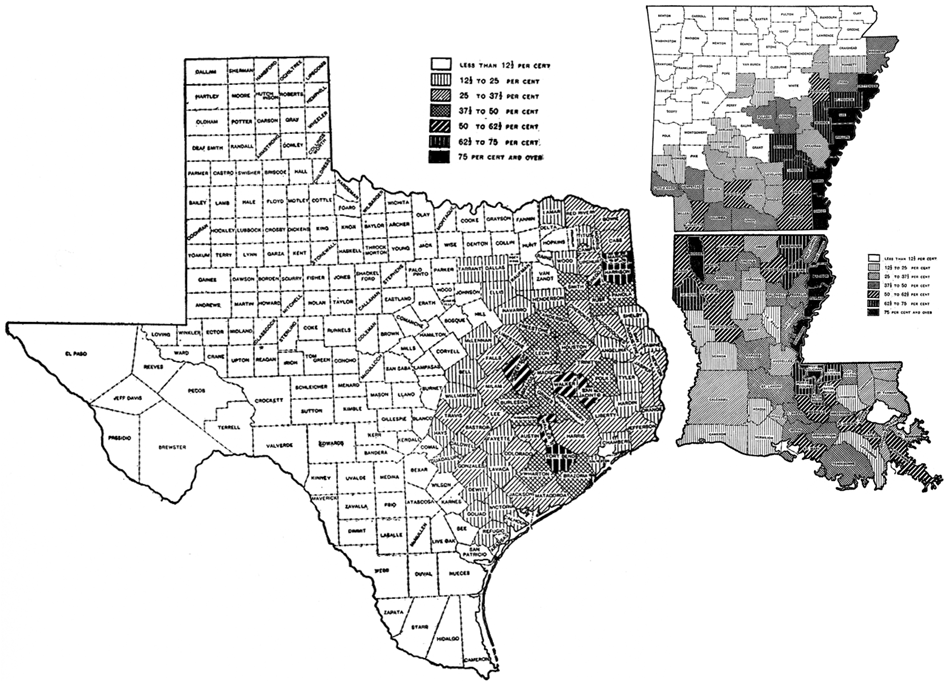
The three states above are commonly referred to as the "Arklatex." Despite the fact that political boundaries derive 3 separate states, the area where these three states converge is culturally cohesive. The town of Texarkana lies on the border of Arkansas and Texas, a longitude line that bisects the Arklatex.
Of significance is the fact that several counties in the Arlatex had African American Population densities that exceeded that of New Orleans, which had only a 50 to 62.5 percent African American population by 1910. The three Texas counties in the Arklatex with the highest African American population were Marion County (between Marshall and Texarkana), Harrison County (containing Marshall), and Gregg County, each with 62.5 to 75 percent African American population. Moreover, the Texas & Pacific Railroad was headquartered in Harrison County in Marshall, and the Texas & Pacific was the main railroad line through Marion, Harrison, and Gregg Counties.
Several Louisiana Arklatex parishes (Louisiana's equivalent to a "county") also had African American Population densities equal to or exceeding that of New Orleans. These included Caddo Parish (on the Texas border, and containing Shreveport), and Bossier Parish (immediately across the Red River from Shreveport, and with a greater than 75% African American population!), and De Soto Parish (on the Texas border immediately south of Caddo Parish). A forty-mile stretch of the Shreveport and Houston Railway ran through Desoto Parish to meet the Houston East and West Texas Railway line at Logansport, LA, at the Texas-Louisiana border.
Between 1883 and 1898, the Thomas family almost certainly traveled through Texarkana during their migration from Little Rock, AR to Houston, TX. After "discovering" Boogie Woogie in east Texas, George W. Thomas, Jr. probably traveled back through Texarkana when he and his younger brother, Hersal, moved to Chicago to spread Boogie Woogie to Clarence "Pine Top" Smith, Albert Ammons, and Meade "Lux" Lewis. See the maps below for larger images of each of these three states. (These maps are derived from the 1910 United States Census.)
African Americans Population Density by County in Texas in 1910

African American Population Density is indicated above from data from the 1910 U.S. Census. Clearly, within Texas, the African American population is concentrated in the eastern part of the state, with a very high density (62.5 to 75%) in Harrison County, where the Texas & Pacific Railroad headquarters were located. The coincidence of African American musical sensibility and inclinations, East Texas railroads, logging camps, turpentine camps, piney woods, barrelhouses, brothels, and mildewed, out-of-tune pianos resulted in Boogie Woogie. Could some of the same influences that came together to evolve Boogie Woogie, Ragtime, and Jazz still be occurring today in the Piney Woods of East Texas? More generally, is there other seminal music that is being born in the Southern United States that has not yet been discovered? I have no doubt that there is!
African Americans Population Density by County in Louisiana in 1910
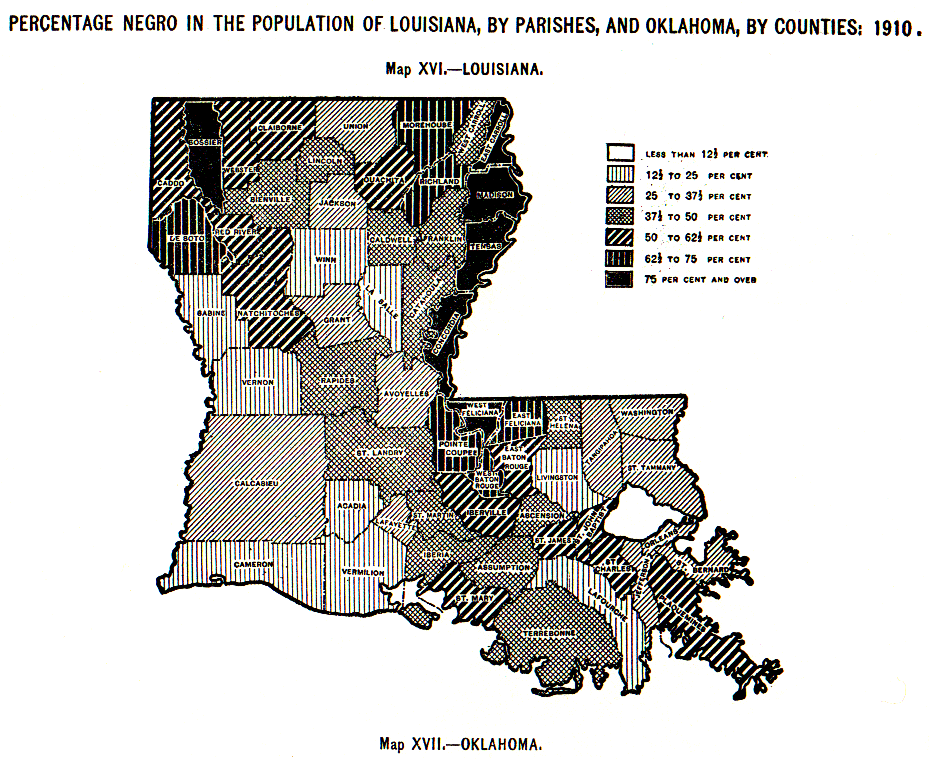
(Derived from 1910 United States Census Data)
African Americans Population Density by County in Arkansas in 1910
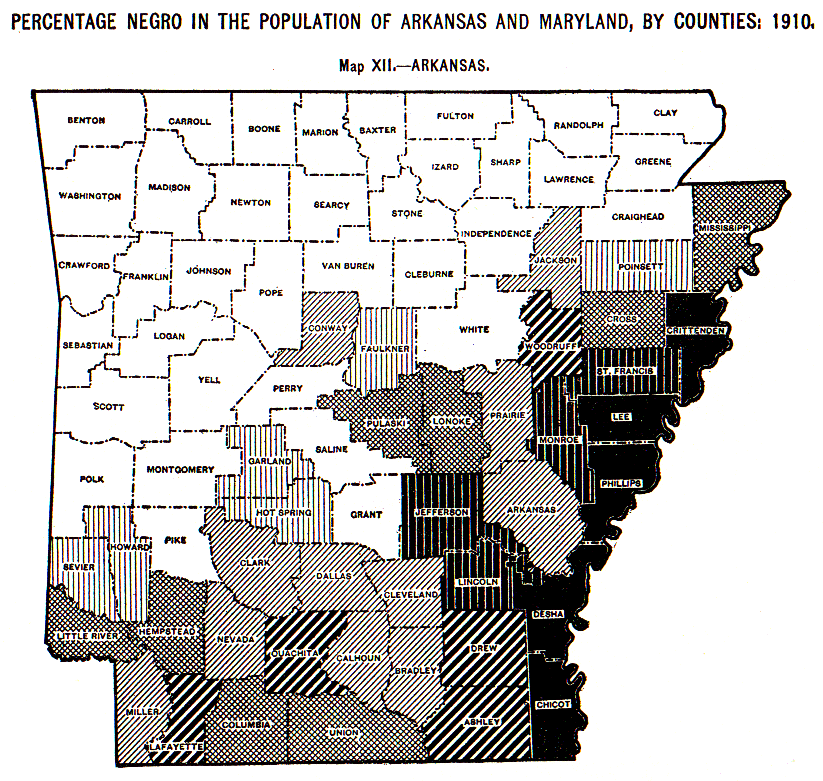
(Derived from 1910 United States Census Data)
Houston's 3rd, 4th, 5th, and 6th Wards
In the Texas Handbook of history, Alan Govenar writes:
"African Americans in Houston settled mostly in four segregated wards: the Third, Fourth, Fifth, and Sixth. It was in the Third Ward that Sam (Lightnin) Hopkinsqv accompanied his cousin Alger (Texas) Alexander in the late 1920s, and where Hopkins returned by himself in the 1940s to play on Dowling Street. The Santa Fe Group gathered in the Fourth Ward.qv They were a loosely knit association of itinerant black pianists in the 1920s and 1930s that included Robert Shaw,qv Black Boy Shine, Pine Top Burks, and Rob Cooper, who played in the roadhouses and juke joints along the Santa Fe tracks ["Santa Fe Group" is a misnomer, as these pianists performed at locations other than those served by only the Santa Fe], playing their distinctive style of piano that combined elements of blues with the syncopation of ragtime. In the Fifth Wardqv also there were black blues pianists, but their style of performance was even more eclectic. Probably the most well-known of these were members of the George W. Thomas family. The eldest, George Thomas, Jr., was born about 1885 [Other sources cite 1883 as the birth date for George Thomas, Jr.], followed by his sister, Beulah, better known as the classic blues singer Sippie Wallace, and her brother, Hersal. In Houston there were fewer opportunities for recording than in Dallas until after World War II,qv when several independent labels were started."67
Both Houston's 4th and 5th Wards had pianists who made important contributions to the development of Boogie Woogie piano. "Ma Grinder," (a sexual reference) as played by Robert Shaw, was a signature piece of the 4th Ward. George Thomas, Sr. worked for the Southern Pacific Railroad, which, in the late 19th century, had purchased previously constructed railroad tracks that ran through the 5th Ward. Among tracks purchased by the Southern Pacific before 1900 were those of the Houston East and West Texas Railroad that ran northward from Houston through Lufkin and Nacogdoches, and on to Shreveport. The existence of the 5th Ward on the north side of the Buffalo Bayou in Houston made it all the easier for itinerant musicians to favor railroad lines that had stations located on the north side of the Buffalo Bayou. The 5th Ward also had easiest access to railroad tracks that ran through the piney woods between Houston and Texarkana. The two most probable railroad routes between Houston and Texarkana would have been:
1. International and Great Northern to Palestine, to Longview, then (on the Texas & Pacific) to Marshall, and then to Texarkana (See my map above for this proposed Thomas family migration route.)
and
2. Southern Pacific (Originally Houston East and West Texas) north to Diboll, to Lufkin, to Nacogdoches, to Shreveport, and then (on the Texas & Pacific) either directly to Texarkana, or to Texarkana by way of Marshall. Given that George Thomas, Sr. worked for the Southern Pacific railroad, the Thomas family might have had greater familiarity or comfort using this route.
Consequently, at some location along either one of these routes seems like the most probable location where George Thomas, Jr. would have heard the piano performances on which Paul Oliver says George Thomas, Jr. based his "Hop Scop Blues" (later renamed "New Orleans Hop Scop Blues").
The Fifth Ward of Houston - Home of the Thomas Family
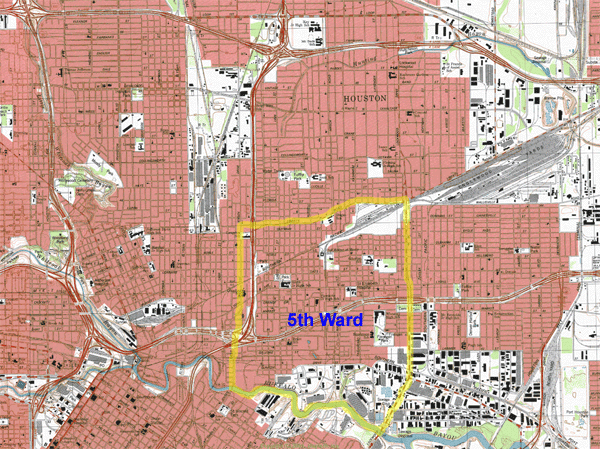
Map Illustration by John Tennison. Copyright 2005
The Fifth Ward is bound by Jenson Drive on the west, Liberty Road on the north, Lockwood Drive on the east, and Buffalo Bayou on the south.
African Americans in the United States in 1990
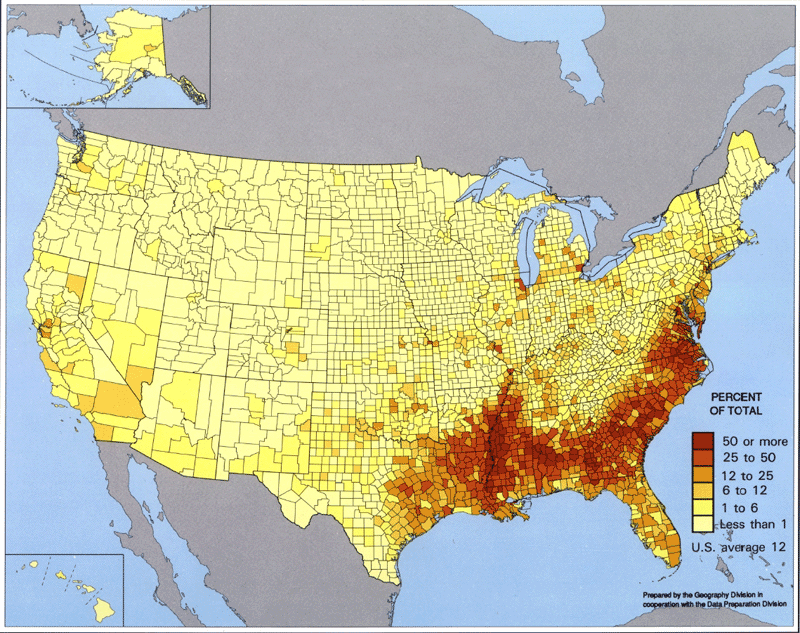
African American Population Density is indicated above from data from the 1990 U.S. Census.
Misunderstandings about Boogie Woogie:
"The Bad Boy of the Rag Family Who Wouldn't Study"
Roy Carew, a contemporary and promoter of Jelly Roll Morton, said that "Boogie Woogie was the bad boy of the rag family who wouldn't study." By "rag family," Carew meant "Ragtime." Carew's statement is unfortunate, as it suggests that not studying is "bad." Yet, it was precisely BECAUSE Boogie Woogie players did not "study" that they were able to NOT be unduly influenced by harmonic and other "rules" of music that might restrict what they came up with. That is, to "study" implies training yourself to do something the way someone else has already done it. Although it can be fun to "learn the rules" so that you can more effectively "break" them, a composer can also come up with something just as musical and probably MORE creative by not knowing the "rules" of other composers at all.
Since Roy Carew did not review the full breadth of Boogie Woogie, he failed to consider the incredible virtuosity of musicians such as Oscar Peterson, one of the greatest Boogie Woogie players of all time, and more generally, one of the greatest jazz pianists of all time. Roy, this bad boy studied! (Any skeptics should listen to Oscar Peterson's Boogie Woogie numbers on the Oscar Peterson 2-CD "Genesis" album on Proper Records, released 2002.)
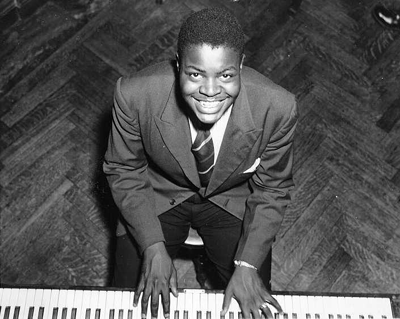
Pictured above is Oscar Peterson (194-?), Photo: D.C. [Langford]. (from the Canadian Pacific Railway Company). For more information, see the Musical Archives of National Library of Canada
The complexity of Conlon Nancarrow's "Boogie Woogie Suite" also belies Carew's obviously limited scope of reference when considering Boogie Woogie. If Carew had examined the full scope of Boogie Woogie music, he would have had to acknowledge that some composers and/or performers in the Boogie Woogie idiom had "studied" a great deal. For example, reviewer and musician, Kyle Gann considers Nancarrow to be one of the three most influential American composers of his generation.10
Despite Boogie Woogie's potential for musical complexity, many classically trained musicians have failed to grasp this potential. They are so upset or perplexed by Boogie's frequently not following rules of western harmony that they completely overlook the polyrhythmic beauty and other musical aspects of Boogie Woogie.
According to Martin Williams, Smithsonian Jazz historian, such an apparent lack of insight is evident in the "Boogie Woogie Etude," composed by Morton Gould and recorded by pianist Jose Iturbi. Williams wrote, "Because neither man understood the polyrhythms that give the style its vitality, the record is surely one of the most embarrassing ever made by an important artist."
Why Do Some People Dislike Boogie Woogie?
Generally, those who express the strongest hatred for Boogie Woogie typically fall into one or more of following four categories:
1. Musicians who have tried, but have not had the coordination or the stamina to play Boogie Woogie. For example, when speaking of playing Boogie Woogie, Smithsonian historian Martin Williams states (page 50), "....without the right rhythmic touch and imagination (a quite individual matter) it is very difficult to play well."38 So if you hear a musician express disdain towards Boogie Woogie, ask them to play some Boogie Woogie for you!
2. Musicians and/or critics who, analogous to those who are genetically incapable of tasting certain flavors, seemingly cannot hear the polyrhythmic complexity of Boogie Woogie, but instead try to mentally process their experience of Boogie Woogie according to classical Western rules of music theory and harmony that often do NOT apply. Nonetheless, many Boogie Woogie recordings not only complex polyrhythms, but also complex harmonic structure, even if not according to rules of melody and conceptualizing chords in 3rds. Indeed, the ratio of the frequencies between the notes used to create dissonance (as heard in Lewis' "Honky Tonk Train Blues") is mathematically more complex than the simple harmonic ratios between the frequencies of notes of common major or minor chords.
3. Some are resentful or jealous of the social advantages that come from public's appreciation of Boogie Woogie. For example, because of the libidinal energy expressed in Boogie Woogie, good players often "get the girls." This claim might sound silly to some readers, but from the days of Hersal Thomas' competing with Sammy Price in Texas (page 28-29)40, and Hersal's prowess in Chicago in the 1920s, and numerous other instances up to the present, this competitive phenomenon has multiple witnesses and has stood the test of time. In addition, some musicians who have spent many years being "formally trained" and learning certain "rules of music" are jealous of the admiration given to Boogie Woogie and other pianists who have not been "formally" trained, and who defy these rules. Fats Waller seems to be someone who had a degree of resentment towards the popularity of Boogie Woogie. Waller's contract required that he not be required to play Boogie Woogie. Yet, Waller's contract did not prevent music publishers from capitalizing on the popularity of Boogie Woogie by publishing at least three books of music that used the name of "Fats Waller" and "Boogie Woogie" on the covers, furthering the mistaken perception that Fats Waller was predominantly a "Boogie Woogie" pianist. Jelly Roll Morton also harbored some resentment towards Boogie Woogie's popularity. Although Eubie Blake did not make hostile comments towards Boogie Woogie, he tried to capitalize on Boogie Woogie's popularity with his "Eubie's Boogie" in the 1960s. However, from listening to "Eubie's Boogie," Blake appears to have developed limited ability to play Boogie Woogie.
4. Musicians and/or critics who are not considering the full Boogie Woogie repertoire, but instead have focused on a small number of poor examples of Boogie Woogie.
Boogie Woogie: The Father of Rock and Roll
The Boogie Woogie Beat: Rompin' Stompin' Rhythm, Broadcast the week of 1/17/02, Based on Riverwalk, script ©2001 by Margaret Moos Pick, stated:
" Pine Top's Boogie Woogie launched a fad that swept the world in the 1930s and 40s. The boogie woogie craze was the most spectacular revolution in popular music to come along until Elvis Presley's Blue Suede Shoes. In many ways, Boogie Woogie is the father of rock and roll."
Chuck Berry, Little Richard, Jerry Lee Lewis, and Ray Charles were inducted into the Rock and Roll Hall of Fame at their first induction dinner in 1986. These four of the very first inductees into the Rock and Roll Hall of Fame have stated the following about Boogie Woogie:
Little Richard said:
"Everything I play is boogie woogie...rock and roll is just up-tempo boogie woogie!"
In a 1990 interview, Little Richard also offered this explanation for the birth of rock:
"I would say that boogie-woogie and rhythm & blues mixed is rock and roll."
On page 142 of his 1987 autobiography, “Chuck Berry: The Autobiography,”29 Berry wrote:
“The nature and backbone of my beat is boogie and muscle of my music is melodies that are simple. Call it what you may: jive, jazz, jump, swing, soul, rhythm, rock, or even punk, it’s still boogie so far as I’m connected with it. When I can't connect to it, I have no right to dispute its title. When its boogie, but with an alien title, the connection is still boogie and my kind of music.”29
The "alien title," of "Rock and Roll" to which Berry refers indicates that he was aware that his music had been arbitrarily re-labeled by promoters and marketers. Moreover, Berry partly borrowed his guitar style from the Boogie Woogie as played by the pianist in Berry's band, Johnnie Johnson. For this reason, some historians regard Johnnie Johnson as a more legitimate "Father" of Rock and Roll than Berry.
During a November 3, 1999 interview by Nick Spitzer on the American Routes Radio Show, Spitzer asked Jerry Lee Lewis about the music that came to be called Rock and Roll. Lewis responded:
"They called it blues. They called it Boogie Woogie. Then they changed the name of it to Rock and Roll."
By referring to "they," Lewis suggests that it was not he who changed the name of the type of music he was playing, but rather those who promoted and marketed the music he was playing.
Charles gives ample evidence of the influence that Boogie Woogie had on him, indicating that Boogie Woogie was the first style to which he was exposed, and that Boogie Woogie records were the first records to which he listened. In his autobiography, "Brother Ray: Ray Charles' Own Story,"56 Ray Charles states the following (page 8):
"Sometimes I'm asked about my biggest musical influence as a kid. I always give one name: Mr. Wylie Pitman. I called him Mr. Pit."56
and (page 8)
"Mr. Pit could play some sure-enough boogie-woogie piano."56
and (page 8)
"Oh, that piano! It was an old, beat-up upright and the most wonderful contraption I had ever laid eyes on. Boogie-woogie was hot then, and it was the first style I was exposed to. Mr. Pit played with the best of them."56
and (page 9)
"I tried to figure out how he could make all those notes come together. I was a baby, but I was trying to invent some boogie-woogie licks of my own."56
and (page 9)
"Some days I'd be out in the yard back of the house. If I heard Mr. Pit knocking out some of that boogie-woogie, I'd drop what I was doing and run over to his place. The man always let me play."56
and (pages 9-10)
"I heard the radio round town, though there were only white stations on it. No way they'd be playing real blues -- I mean hollering-through-the-hollow-log blues. But records were also around, and the first ones I listed to were on Mr. Pit's jukebox."56
and (page 10)
"Boogie-woogie, baby! The jukebox was jumping with the stuff. There was Pete Johnson, Meade Lux Lewis, and Albert Ammons. And you better believe that there was also some filthy blues, some country blues, coming out of that same box -- Tampa Red, Blind Boy Phillips, and Washboard Sam."56
In 1987, Smithsonian music historian, Martin Williams wrote (page 51):
"Early rock music borrowed boogie woogie devices and effects wholesale."38
Another source of corroboration of Boogie Woogie's role in the creation of Rock and Roll comes from Morgan Wright of Hoy Hoy Records. Wright has done extensive listening of pre-1950s Rock and Roll (see Hoy Hoy Records website for audio examples, artist names, and historical commentary on the history of Rock and Roll.) As a result of Wright's inquiry into the history of the music we came to call "Rock and Roll," he came to define "Rock and Roll" as:
"Boogie Woogie with a back beat."75
Wright's operational definition of Rock and Roll underscores the integral presence of Boogie Woogie elements in the musical genre to which the term "Rock and Roll" was applied by Alan Freed and others. (Note: Alan Freed did not coin the term, "Rock and Roll," but he did popularize the use of term, "Rock and Roll." See next paragraph.)
Not only did Boogie Woogie contain the musical features in the music that was later called "Rock and Roll," titles used in classic Boogie Woogie and other pieces also predated the later use of the words, "rock" and "roll" by such Rock and Roll promoters as Alan Freed. For example Hersal and George Thomas's 1923 recording of "The Rocks" and Pete Johnson's 1938 recording of "Roll 'Em Pete" explicitly demonstrate the use of the words, "rock" and "roll" in Boogie Woogie titles. There are many other examples as well. Although not a Boogie Woogie piece, Trixie Smith recorded "My Man Rocks Me (with One Steady Roll)" in 1922, demonstrating the coupling of the words, "rock" and "roll" long before Alan Freed arrived on the scene. Many years prior to 1922, the term "rock and roll" had been used as a nautical term to denote the side-to-side and forward-and-backward motion of ships on the ocean. Moreover, in keeping with this nautical meaning, the Boswell Sisters recorded their piece, explicitly and unequivocally titled, "Rock and Roll" on October 4 of 1934.
The Spiritual to Swing Concert, December 23, 1938: The First Rock and Roll Recordings
Thomas Dorsey's (not the Bandleader Tommy Dorsey) "Rock Me," and "That's All" as recorded by Sister Rosetta Tharpe (vocal & guitar) and Albert Ammons (Boogie Woogie piano) at the December 28, 1938 Spirituals to Swing Concert are the earliest recordings (that I have heard so far) that I would unequivocally consider "Rock and Roll." These recordings can heard on the 1999 Vanguard Records on Disc 1 of the 3-CD Boxed Set. At least in the case of "That's All," Morgan Wright confers with me that the December 2, 1938 recording is "Rock and Roll."75 (Wright has not given me his opinion regarding the recording of "Rock Me" from the same night.) Although he and I consider some recorded music prior to December 23, 1938 have elements of Rock and Roll, others likely would not consider such examples as unequivocal as the December 23, 1938 recordings by Tharpe and Ammons. Such differences in perception suggest that, like the elements that contribute to a Boogie Woogie feel, elements that contribute to a Rock and Roll feel exist on a continuum, with their respective magnitudes. Although some of these elements (such as having a back beat) were clearly present in 1920s recorded music (such as in Charlie Spand's and Bind Blake's 1929 recording, "Hastings Street", the average magnitude of back beat was clearly of a higher magnitude in 1950s Rock and Roll, such as can be heard in Chuck Berry's "Maybellene."
If any readers know of recordings prior to December 23, 1938 that they would consider "Rock and Roll," I would love to hear from them at nonjohn@yahoo.com.
The website of the Rock and Roll Hall of Fame states the following:
"Certainly, in the unleashed frenzy of the 'spirit feel' style of gospel epitomized by such singers as Mahalia Jackson, Marion Williams and Sister Rosetta Tharpe, one can hear the rousing roots of rock and roll."
Yet, despite this admission, as of 2010, neither Sister Rosetta Tharpe nor Marion Williams have been inducted into the Rock and Roll Hall Fame.
Clearly, the presence or influence of Boogie Woogie can be heard in almost all 1950s Rock and Roll. In the 1960s, Rock and Roll began to evolve and diversify to encompass textures could not reasonably be called Boogie Woogie. Even though these parallel evolutions in Rock and Roll occurred, Boogie Woogie never left Rock and Roll. Consequently, Boogie Woogie has maintained its development both within present-day Rock and Roll, Blues, Jazz, and as its own genre.
On July 22, 2005, I wrote a letter and sent it by certified mail to the Rock and Roll Hall of Fame in support of inducting George Thomas, Hersal Thomas, Albert Ammons, Pete Johnson, Meade Lux Lewis, and Sister Rosetta Tharpe into the Rock and Roll Hall of Fame. The full text of the letter can be seen on the home page of the Boogie Woogie Foundation (www.bowofo.org) As of November, 2010, I have not heard back from the Rock and Roll Hall of Fame.
Boogie Woogie Reaches New Heights of Complexity with Conlon Nancarrow
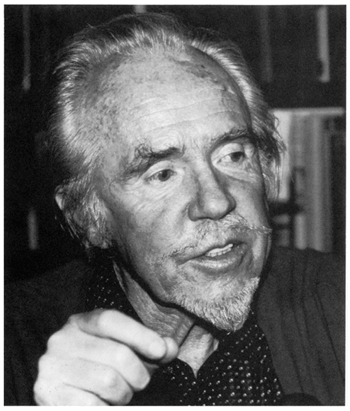
For a good example of rhythmic and harmonic complexity that has been composed and recorded in the Boogie Woogie genre, listen to composer Conlon Nancarrow’s “Boogie Woogie Suite." My boyhood house in Texarkana, Arkansas, was directly across the street from the boyhood house of Conlon Nancarrow. As a child in the 1970s, I used to play in the Nancarrow yard. The yard was very lush, green, and mysterious. The Nancarrow house was a beige brick house with red-orange Spanish clay tiles on the roof. Conlon's brother, Charles Nancarrow, still lived in the Nancarrow house as I was growing up, and as a result, I learned of Conlon’s work from Charles from a young age. I was very inspired to know that someone who grew up next door to me had gone on to become a celebrate musician, and what Village Voice critic Kyle Gann called one of the three "most influential American composers of their generation."10 In same way Bill Clinton, with his frequent trips to Texarkana, inspired me by demonstrating the heights to which local folks could climb.
Composer and music critic Kyle Gann has written an excellent book titled, “The Music of Conlon Nancarrow” (1995, Cambridge University Press). In his book, Gann writes, “Samuel Conlon Nancarrow was born on the Arkansas side of Texarkana on 27 October 1912. John Cage had been born fifty-two days earlier in Los Angeles, Elliott Carter four years earlier in New York City; by the end of the century the three would have become the most influential American composers of their generation. Nancarrow's importance would manifest itself later than that of the other two, both of whom would figure in his career."10
Gann also writes, "the Nancarrows lived in the same home throughout Conlon's youth, on the southeast corner of 20th and Beech Streets, a few blocks east of State Line Avenue" and notes that "Texarkana, Arkansas, has produced its share of groundbreaking composers."10 For example, Scott Joplin attended school on Laurel Street several blocks south of the Nancarrow house.
My first close listenings of "Conlon's Boogie Woogie" Suite came when my boyhood piano teacher, Mr. Edward Walters, lent me his entire LP record collection of Conlon’s work. There is no question that listening to “Boogie Woogie Suite” and other Nancarrow recordings at an early age had an important effect of demonstrating to me the unlimited complexity to which Boogie Woogie could soar. Any person who regards Boogie Woogie as a “dead-end” or obsolete style without potential for musical invention needs to jolt themselves out of their snobbery by listening to Conlon Nancarrow’s work and that of current Boogie Woogie composers.
In the Conlon Nancarrow tradition of composing piano scores that are beyond the performance capabilities of human beings, Kyle Gann went on to release his own album of complex piano music on the New World Records label in 2005. The album is titled, "Nude Rolling Down an Escalator: Studies for Disklavier." Of particular note on this album to Ragtime and Boogie Woogie artists are the pieces, "Texarkana," and "Cosmic Boogie-Woogie."
The Present and the Future of Boogie Woogie
"Nonjohn and others are keeping Boogie Woogie alive and well in Texas and throughout the world. Thanks to Nonjohn and other Boogie Woogie practitioners, the world remains Boogie Woogie Conscious." -- Bill Scribner, John "Nonjohn" Tennison website webmaster, 2004 (Thanks, Bill, for those kind words. My own mother could not have said it better!)
As of 2005, Boogie Woogie continues to thrive and evolve, as evidenced by the proliferation of Boogie Woogie artists (See www.boogiewoogie.com), by annual Boogie Woogie festivals in Europe (such the International Boogie Woogie Festival presented by Silvan Zingg in Lugano, Switzerland), in the United States, and at other annual Blues festivals throughout the world where Boogie Woogie artists perform.
John "Nonjohn" Tennison, Silvan Zingg, and Sabina, October 14, 2005

(photo from John Tennison's collection)
Silvan Zingg performed at AMRF's 7th annual Boogie Woogie and Blues Festival on October 14, 2005, at the Royal Oak Theatre in Royal Oak, Michigan.
In October, 2005, Bob Baldori (A.K.A. "Boogie Bob") and Bob Seeley kicked off their 2-man 2-piano 4-handed Boogie Woogie tour. The first performance was at Fishbone's in downtown Detroit on October 13, 2005.
Bob Baldori and Bob Seeley Prove that 4-Handed Boogie Woogie is Alive and Well in in the USA in 2005

(Photo was taken by John Tennison, October 13, 2005, at Fishbone's in downtown Detroit.)
See the website of the American Music Research Foundation for their own series of annual Boogie Woogie festivals in the United States, and for a page of links to other Boogie Woogie websites.
Kenny "Blues Boss" Wayne, John "Nonjohn" Tennison, and Michael Kaeshammer, October 14, 2005
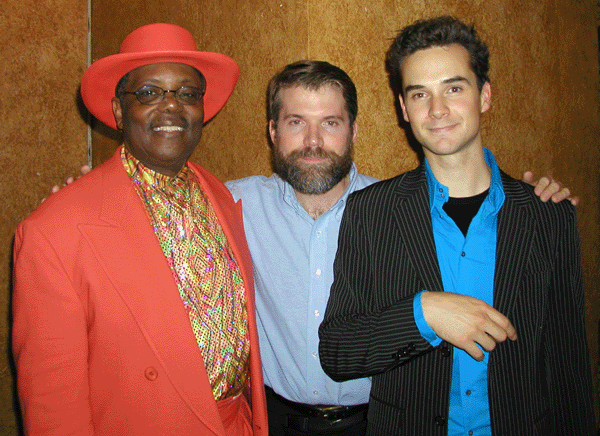
(photo from John Tennison's collection)
Wayne and Kaeshammer performed at AMRF's 7th annual Boogie Woogie and Blues Festival on October 14, 2005, at the Royal Oak Theatre in Royal Oak, Michigan.
Another good web page of Boogie Woogie links can be found at Colin Davey's Boogie Woogie website.
The Full Scope of the Boogie Woogie Metaphor
Far from being only a term for a style of music, Boogie Woogie is a metaphor for something universal. Consequently, Robert Palmer (born 1945 in Little Rock, AR) titles his Epilogue, "The World Boogie," in his 1981 book, Deep Blues20. The closing paragraph of Palmer's Epilogue (page 277) captures the feel of what it means be in a state of collective consciousness, also known as being "Boogie Woogie Conscious," an expression first used in 1940 by Alec Templeton17. Palmer writes:
"A literary and musical form. . . a fusion of music and poetry accomplished at a very high emotional temperature. . . these are different ways of describing the same thing. A gigantic field of feeling. . . that's a way of describing something enduring, something that could be limitless. How much thought (to return to Miss Waddell's Clarksdale English class, May 1943) can be hidden in a few short lines of poetry? How much history can be transmitted by pressure on a guitar string? The thought of generations, the history of every human being who's ever felt the blues come down like showers of rain."20
"Boogie Woogie is Music. Boogie Woogie is Libido. Boogie Woogie is Yoga. Boogie Woogie is a Religious Experience. Boogie Woogie is the Creative Life Force. Boogie Woogie is the Eternal Dance." -- John "Nonjohn" Tennison
References & Bibliography
1.
"Jazzmen", 1939, by Harcourt Brace Jovanovich, Inc., New York, edited
by Frederick Ramsey, Jr. and Charles Edward Smith. [Chapter 4
("Blues") by E. Simms Campbell and Chapter 8 ("Boogie
Woogie") by William Russell provide important details on the history of
Boogie Woogie.]
2. "The New Harvard Dictionary of Music," 1986, by the Belknap Press of Harvard University Press.
3.
“Existentialism,” 1974, Edited by Robert C. Solomon, University
of Texas
4. "The White Negro," (essay), 1957, by Norman Mailer.
5. "The Story of the Blues," 1969, by Paul Oliver, London.
6. "Hendersonia", 1973, by Walter C. Allen, Jazz Monographs Number 4
7. “The History of the Blues,” 1995, by Francis Davis, Hyperion, New York.
8. "They All Played Ragtime," 1950, by Rudi Blesh and Harriet Janis.
9. "The Story of Boogie Woogie: A Left Hand Like God," 1988, by Peter J. Silvester, with a special contribution from Denis Harbinson, Quartet Books Limited, A Member of the Namara Group, London (Reprinted in 1990 by Omnibus Press, London).
10. "The Music of Conlon Nancarrow," 1995, by Kyle Gann, Cambridge University Press.
11. "Whistle in the Piney Woods: Paul Bremond and the Houston, East and West Railway," 1999, by Robert S. Maxwell, University of North Texas Press.12. "5 Boogie Woogie Piano Solos by All-Star Composers" (a book of sheet music), Copyright 1942, edited by Frank Paparelli, Leeds Music Corporation, RKO Building, Radio City, New York, NY.
13. "Texan Jazz," 1996, by Dave Oliphant, University of Texas Press.
14. "Music in a New Found Land: Themes and Developments in the History of American Music, " 1964, by Wilfrid Mellers, Alfred A. Knopf, Inc., New York.
15. “Jazz Styles: History and Analysis," Seventh Edition, Chapter 2 ("What is Jazz?"), by Mark C. Gridley, Prentice Hall, Inc. 2000.
16. "Blind Lemon Jefferson: The Complete Classic Sides Remastered," 4-CD Box Set, Liner Notes by Drew Kent, JSP Records, 2003, England.
17. "Boogie Woogie Piano Styles—No. 1: The History, Development and Art of Playing the Boogie Woogie Style” By Sharon Pease, Copyright 1940 by Forster Music Publisher, Inc., Chicago, IL
18. "The Boogie Woogie Beat: Rompin' Stompin' Rhythm", Radio Broadcast for the week of 1/17/02, Based on Riverwalk, script ©2001 by Margaret Moos Pick
19. The "South Bank Show" (educational television series in Great Britain), episode on Boogie Woogie, 1986, with commentary by Music Historian, Paul Oliver
20. Deep Blues, by Robert Palmer, published in 1981 by Viking Penguin, Inc.
21. Down Beat, July 1939, page 22, “Boogie Piano Was Hot Stuff in 1904” article by Onah L. Spencer
22. "Blind Lemon Jefferson: His Life, His Death, and His Legacy," by Robert Uzzel, 2002, Eakin Press, Austin, TX.
23. "Tolbert's Texas" by Frank X. Tolbert, 1983, Doubleday and Company, Inc.
24. “The Devil’s Music: A History of the Blues”, Second Edition, 1997, by Giles Oakley, De Capo Press (based on the 5-part BBC-TV documentary “The Devil’s Music”)
25. "The Life and Legend of Leadbelly," 1992, by Charles Wolfe and Kip Lornell, Harper Collins Publishers
26. “The Eighty-Six Years of Eubie Blake,”
LP Music Album, Columbia Records C2S 847
27. "The Land Where the Blues Began," 1993, by Alan Lomax, The New Press, New York, NY.
28. "Bluesland: Portraits of Twelve Major American Blues Masters," edited by Pete Welding & Toby Byron, Penguin Books, Ltd., 1991.
29. “Chuck Berry: The Autobiography,” 1987, by Chuck Berry, Faber and Faber.
30. “Meeting the Blues,” 1988, by Alan Govenar, Taylor Publishing Company, Dallas, Texas.
31. "Texas Handbook of History" in article on "Prostitution" by David C. Humphrey (Full article is online.)
32. "Blues Piano" - Documentary with interview of Ray Charles by Clint Eastwood. (Part of the Martin Scorsese Presents the Blues Series) .
33. "Ray" - The 2004 biographical movie about the life of Ray Charles. The movie erroneously substitutes the word, "Stride" for "Boogie Woogie." Sadly, in the film, the term "Boogie Woogie" is used in a derogatory fashion by a white racist country musician.
34. "Women's Status in Texarkana, Texas in the Progressive Era, 1880-1920," 2002, by Beverly J. Rowe, Women's Studies, Volume 37, The Edwin Mellen Press.
35. "Just Jazz," edited by Sinclair Traill and The Hon Gerald Lascelles, Chapter 2. "Boogie Woogie" (pages 13-40) written by Ernest Borneman, published 1957 in Great Britain for Peter Davies Ltd by The Windmill Press, Kingswood, Surrey.
36. “Everybody’s just wild about Eubie” -- article by Peter Hanley, copyright 2003.
37. Swing Music Magazine, Quotation from Jazz reviewer, John Goldman in 1936 (Exact volume and date of Swing Music Magazine is uncertain. Quotation was taken from page 133 of reference #9 above).
38. "The Smithsonian Collection of Classic Jazz, Revised Edition," 1987, selected and annotated by Martin Williams, (with a biological index by Ira Gitler), Smithsonian Institution Press.
39. "The 35 Best Ghost Towns In East Texas and 220 Other Towns We Left Behind," 1988, by Bob Bowman, Copyright 1988 by Bob Bowman & Associates.
40. "What Do They Want?," 1990, by Sammy Price (This is his autobiography.), University of Illinois Press.
41. "Pine Apple Rag," 1908, by Scott Joplin, Seminary Music Company, New York, Copyright 1908.
42. "Pastime Rag No. 1 (A Slow Drag)," 1913, by Artie Matthews, published in 1913 by Stark Music Company, St. Louis, MO
43. Jazz Record (magazine), April 15, 1943 issue, (edited by Art Hodes, musician and promoter of Cow Cow Davenport)
44. "But Only Some of Them Played Boogie Woogie" - a qualifier from John "Nonjohn" Tennison in response to the book titled, "They All Played Ragtime," 1950, by Rudi Blesh and Harriet Janis.
45. "Record Research", Issue #81, (published January, 1967), comments by Victoria Spivey from 1966.
46. "Texas Barrelhouse Piano" (album) by Robert Shaw (A.K.A. "The Ma Grinder"), 1963, Arhoolie Records (re-released on CD on Arhoolie CD 377)
47. Handbook of Texas, article titled "Railroads" by George C. Werner
48. The Varieties of Religious Experience, by William James, M.D.
49. www.juneteenth.com/history.htm
50. Handbook of Texas Online - article titled "LONGVIEW AND SABINE VALLEY RAILWAY," http://www.tsha.utexas.edu/handbook/online/articles/LL/eql6.html.
51. Handbook of Texas Online - article titled "TEXAS AND PACIFIC RAILWAY," http://www.tsha.utexas.edu/handbook/online/articles/TT/eqt8.html.
52. Handbook of Texas Online - article titled "CIVIL WAR" http://www.tsha.utexas.edu/handbook/online/articles/CC/qdc2.html
53. Handbook of Texas Online - article titled "ATCHISON, TOPEKA AND SANTA FE RAILWAY SYSTEM" http://www.tsha.utexas.edu/handbook/online/articles/AA/eqa10.html
54. Handbook of Texas Online - article titled "TEXAS WESTERN RAILROAD" http://www.tsha.utexas.edu/handbook/online/articles/TT/eqt20.html
55. Down Beat, February 19, 1959, "Meade Lux Lewis: A Blues Man's Story," page 16-17.
56. "Brother Ray: Ray Charles' Own Story" (autobiography of Ray Charles), Copyright 1978 by Ray Charles & David Ritz, first published in 1978, re-published in 1992 by De Capo Press
57. "This is Ragtime" by Terry Waldo, 1976, Hawthorn Books, Inc., New York.
58. "Reminiscing with Noble Sissle and Eubie Blake" by Robert Kimball and William Bolcom, first published in New York in 1973, Re-printed by Cooper Square Press, 2000.
59. "5 Famous Boogie Woogie and Blues Solos by Sammy Price" -- 1943 Folio by Leeds Music Corporation, New York.
60. "Nameless Towns: Texas Sawmill Communities, 1880-1942," by Thad Sitton and James H. Conrad, 1998, University of Texas Press, Austin.
61. "Sawdust Empire: The Texas Lumber Industry, 1830-1940," by Robert S. Maxwell and Robert D. Baker, 1983, Texas A&M University Press, College Station, Texas.
62. "The Art of Jazz: Essays on the Nature and Development of Jazz," edited by Martin Williams, Contains chapter "Three Boogie-Woogie Blues Pianists," (pages 95-109), by William Russell, Oxford University Press, 1959.
63. "Clarence Williams Presents: The 'Boogie Woogie' Blues Folio" ("With Annotations by Clarence Williams"), Copyright 1940, by Clarence Williams Publishing Company, 145 W. 45th St., New York, New York.
64. "They Have a Word for It : A Lighthearted Lexicon of Untranslatable Words and Phrases," by Howard Rheingold, Published 2000 by Sarabande Books
65. Liner Notes from CD Box set, "Blind Lemon Jefferson: The Complete Classic Sides Remastered," JSP Records, 2003.
66. Liner Notes from "Texas Barrelhouse Piano" by Mack McCormick, released the Almanac Book and Record Company, Houston, Texas (This album was later re-issued by Arhoolie Records under the same name of "Texas Barrelhouse Piano." (See Reference 46 above.))
67. Handbook of Texas Online, article titled, "BLUES," by Alan Govenar, http://www.tsha.utexas.edu/handbook/online/articles/BB/xbb1.html
68. Interview with Lee Ree Sullivan, Boogie Woogie pianist, 1986, Texarkana, AR-TX, by John Tennison and Alfred Tennison, Jr.
69. Texarkana Trivia Game, published in 1980s, by Texarkana Kiwanis Club and the Texarkana Work Center.
70. Album: "Sippie Wallace Sings the Blues," Liner Notes by Paul Oliver, 1967, released by Storyville Records, recorded October 23, 1966, Copenhagen.
71. Ragtime: A Musical and Cultural History, by Edward A. Berlin, re-published by www.backinprint.com, December 2002.
72. "Southern Rag Medley No. 2" by Blind Boone, published 1909
73. Quote by George C. Bond, Ph.D., Director, Institute of African Studies, Columbia University, Page 6, in “Chokwe,” by Manuel Jordan, Ph.D., a title in the “Heritage Library of African Peoples,” 1998, by the Rosen Publishing Group, Inc., New York
74. LP Liner Notes by Rosetta Reitz for Album: "Boogie Blues: Women Sing and Play Boogie Woogie," 1983, Rosetta Records, New York, NY
75. Email dialogue between Morgan Wright and John Tennison, August, 2006
76. "Looking Up at Down: The Emergence of Blues Culture," by William Barlow, 1989, Temple University Press
77. Interview of Paul Oliver by John Tennison, February 12, 2007
78. "That Crazy American Music" by Elliot Paul, 1957, Published by Bobbs-Merrill, Indianapolis and New York
79. "American Narrow Gauge Railroads" by George W. Hilton, Stanford University Press, 1995
80. "From Ox Teams To Eagles: Texas And Pacific" by Don Watson and Steve Brown, The Boston Mills Press, 1978
81. Handbook of Texas Online article on Tallys, Texas
82. Handbook of Texas Online article on Camden, Texas
83. "Will Pinetop's Sons Be Great Like Their Dad? Clarence and Eugene Smith Today Play Boogie-Woogie With The Best Of Them," article by Sharon A. Pease on page 8 of the October 15, 1939 issue of Down Beat Magazine
84. "Jazz Style in Kansas City and the Southwest" by Ross Russell, University of California Press, 1971
85. "Jazz: New Perspectives on the History of jazz by Twelve of the World's Foremost Jazz Critics and Scholars," Edited by Nat Hentoff and Rinehart & Company, Inc., 1959, New York, Toronto-- Chapter 6, titled "Boogie Woogie," (pages 105-135) by Max Harrison
86. Liner notes to "A Treasury of Field Recordings, Vol. 2", by Mack McCormick
87. Lead Belly's Last Sessions, Folkways Records, (CD #4 of the 4-disc CD set)
88. Louisiana Hayride: Radio and Roots Music Along the Red River, by Tracey E. W. Laird, Oxford University Press, 2004
89. "Stomp the Grinder Down: Texas Blues Piano, Part I" by Michael Hortig, Blues and Rhythm
90. "Illuminating The Leadbelly Legend," by Ross Russell, Down Beat, August 6, 1970, Vol. 37, No. 15
91. "Jazz and Ragtime Records (1897-1942)" by Brian Rust (Malcolm Shaw, editor), Mainspring Press, Denver, Colorado, 2002
92. "Blues and Gospel Records: 1890-1943," Robert M. W. Dixon (Compiler), John Godrich (Compiler), and Howard W. Rye (Compiler), Oxford University Press, USA; 4th edition (October 30, 1997)
93. Page 20, Liner notes, written by Jean-Christophe Averty, for CD album, "Original Boogie Woogie" by Claude Bolling, 1968, Universal Music S.A.S., France.
94. "A Treasury of the Blues: Complete Words and Music of 67 Great Songs from Memphis Blues to the Present Day," "Edited by W. C. Handy, with an Historical and Critical Text by Abbe Niles, with Pictures by Miguel Covarrubias," published by Charles Boni, Distributed by Simon and Schuster, 1949
95. The Evening Gazette, Port Jervis, New York, in the "Literary News Section," Saturday, May, 15, 1880
96. "Conversation With The Blues," by Paul Oliver, Horizon Press, New York, 1965
97. "Deep South Piano: The Story of Little Brother Montgomery," by Karl Gert zur Heide, 1970, Studio Vista Publishing.
98. "I Am The Blues: The Willie Dixon Story," by Willie Dixon with Don Snowden (Biography of Willie Dixon), 1989, Da Capo Press
99. 1961 Interview of Meade Lux Lewis by Don Hill and Dave Mangurian transcribed in Cadence Magazine, Volume 13, Number 10, October, 1987, pages 16-28.
There will be a vastly-expanded list of references that will be present in my upcoming book on Boogie Woogie.
Recommended Reading: "From Ox Teams To Eagles: Texas And Pacific" by Don Watson and Steve Brown, The Boston Mills Press, 1978
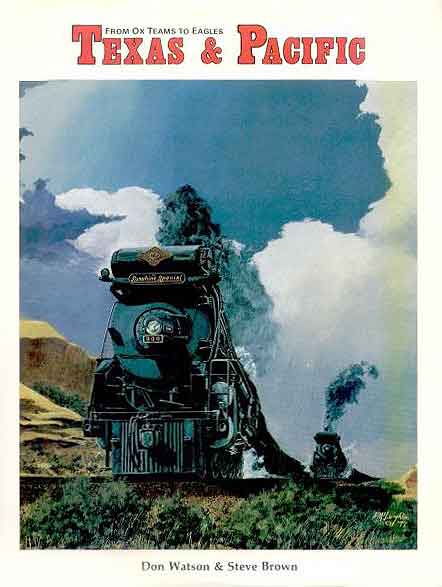
Acknowledgments
I want to thank people and organizations for having shared their knowledge of Boogie Woogie and history, and for having made suggestions that have helped me improve my ever-evolving Boogie Woogie database. Thanks to: Lee Ree Sullivan, Wilbur Smith, Artis Brewster, Jerry Atkins, George Gamble, Nancy Wyatt, Mack McCormick, Omar Sharriff (AKA Dave Alexander), Jack Canson, Nancy Canson, Jean-Paul Amouroux, Axel Zwingenberger, Silvan Zingg, Paul Oliver, Don Watson, Mike Meddings, Deirdre O'Connell, John Davis, Ron Harwood, Ryan Hertz, Bob Seeley, Bob Baldori, Robert Pinsker, Andrew Barrett, Richard A. Olliver, Morgan Wright, Krystyna Parafinczuk, Bob Bowman, William T. Block, Jr., Andrea Iken Tennison, George Iken, Alfred Tennison, Jr., Nancy Tennison, Frank Himpsl, Mike Montgomery, Kevin Witt, Bernd Reufsteck, Burgin Mathews, Alan Balfour, Andrew Petrou, Stuart Gregory, Bernhard Behncke, and Document Records.
(I want my account of the history of Boogie Woogie to be consistent with all known evidence. Thus, I invite anyone interested in the history of Boogie Woogie to contact me at nonjohn@nonjohn.com if they have any information that will contribute to compiling a more accurate history of Boogie Woogie. Moreover, I want to give credit in this article (which will become a book) to anyone who makes such a contribution.)
John "Nonjohn" Tennison's Home Page